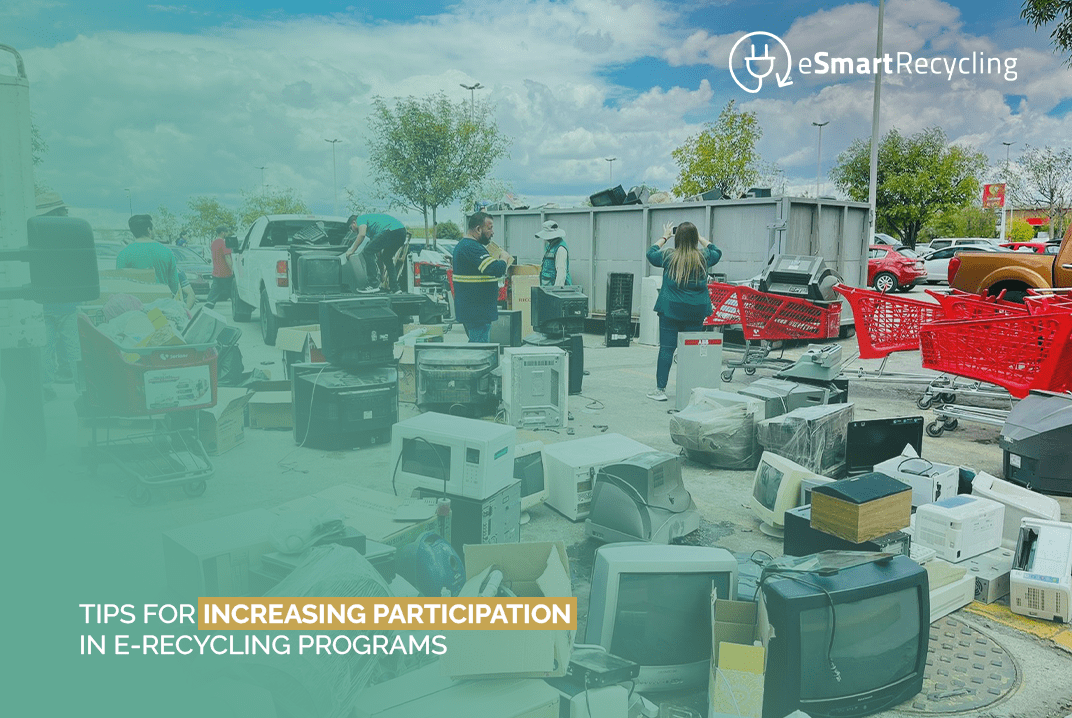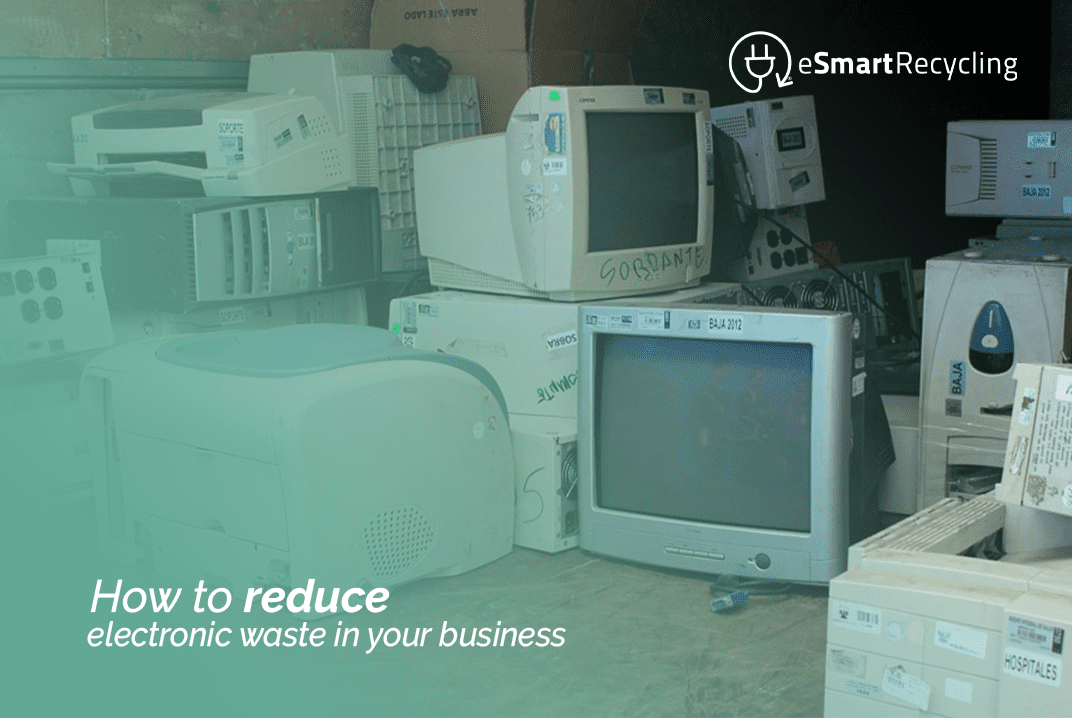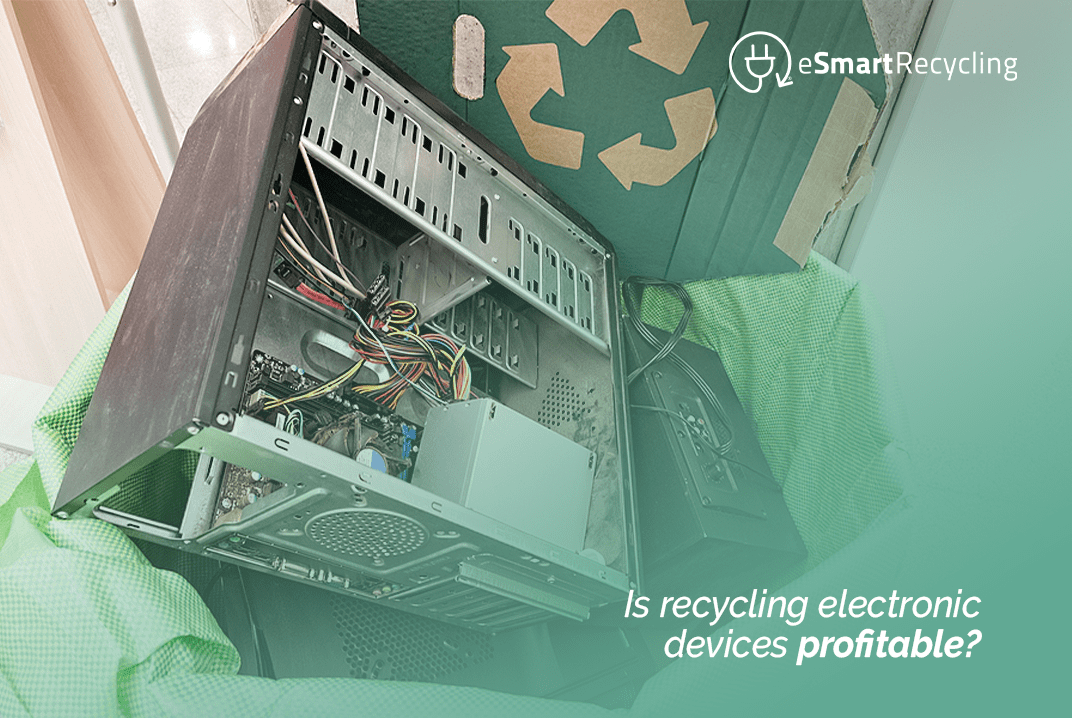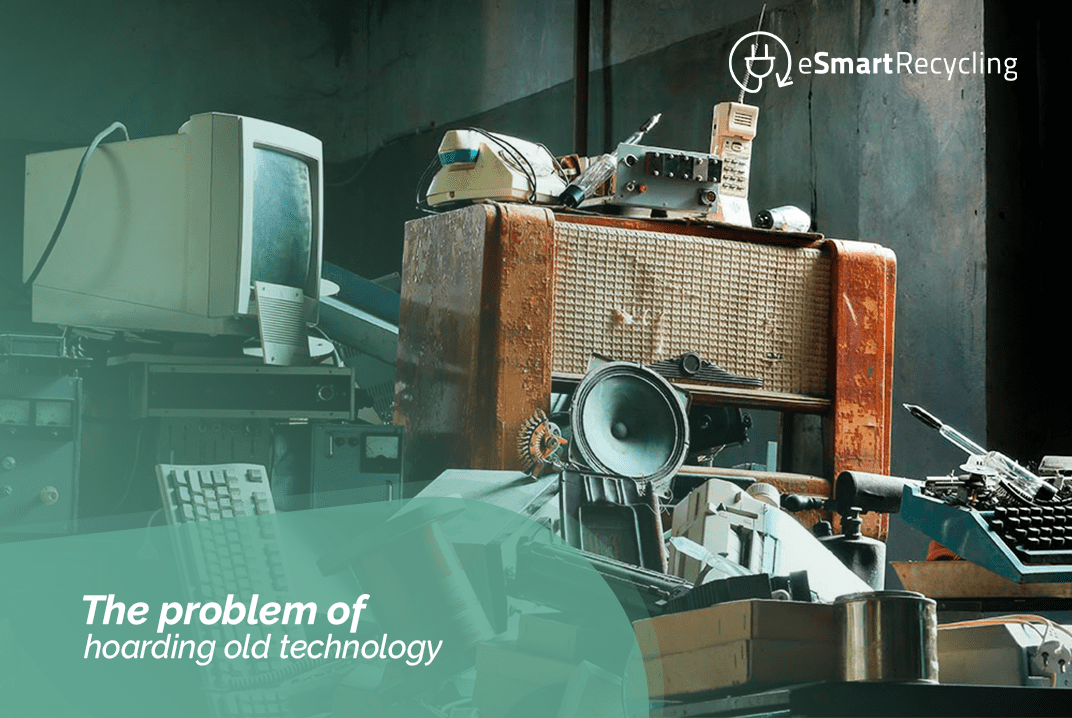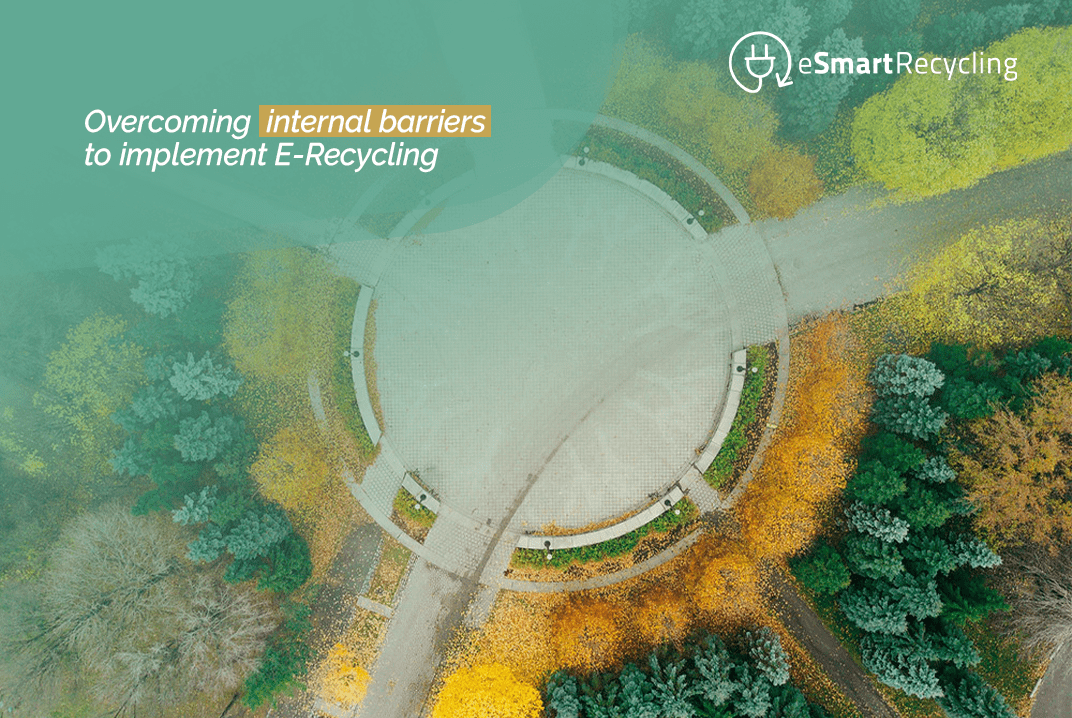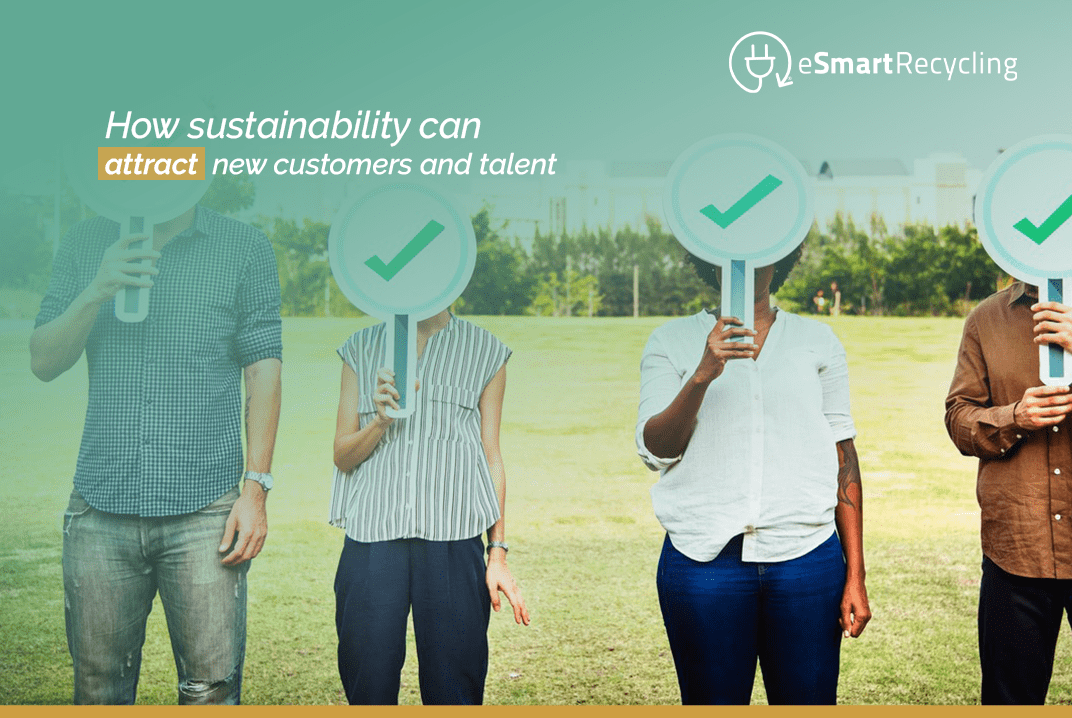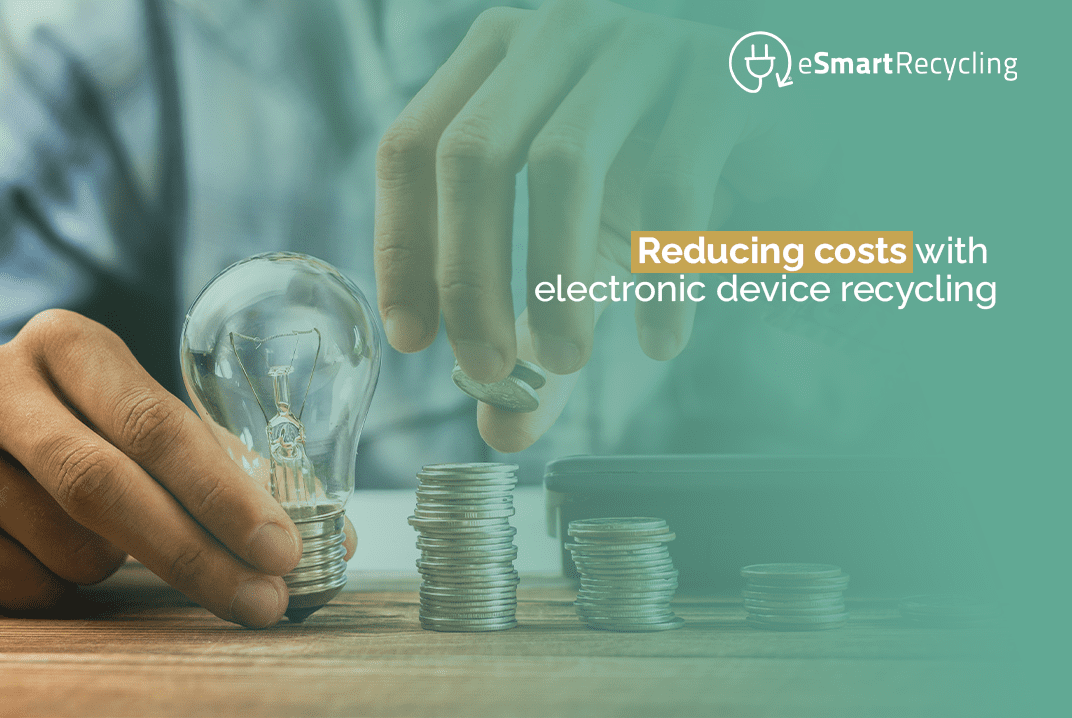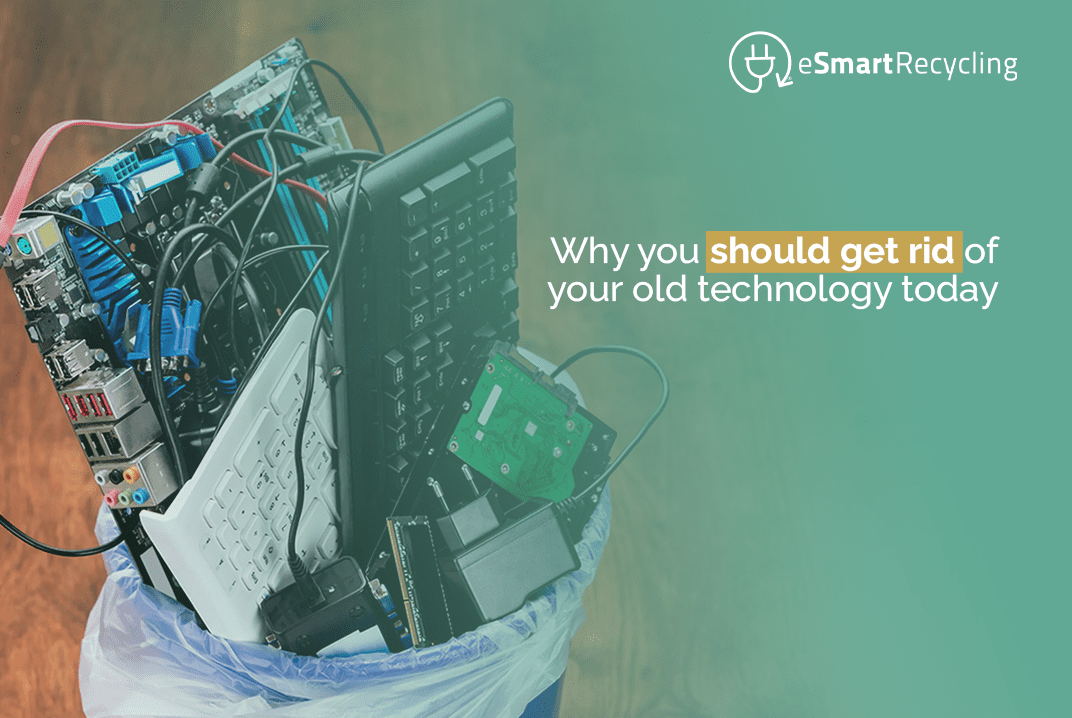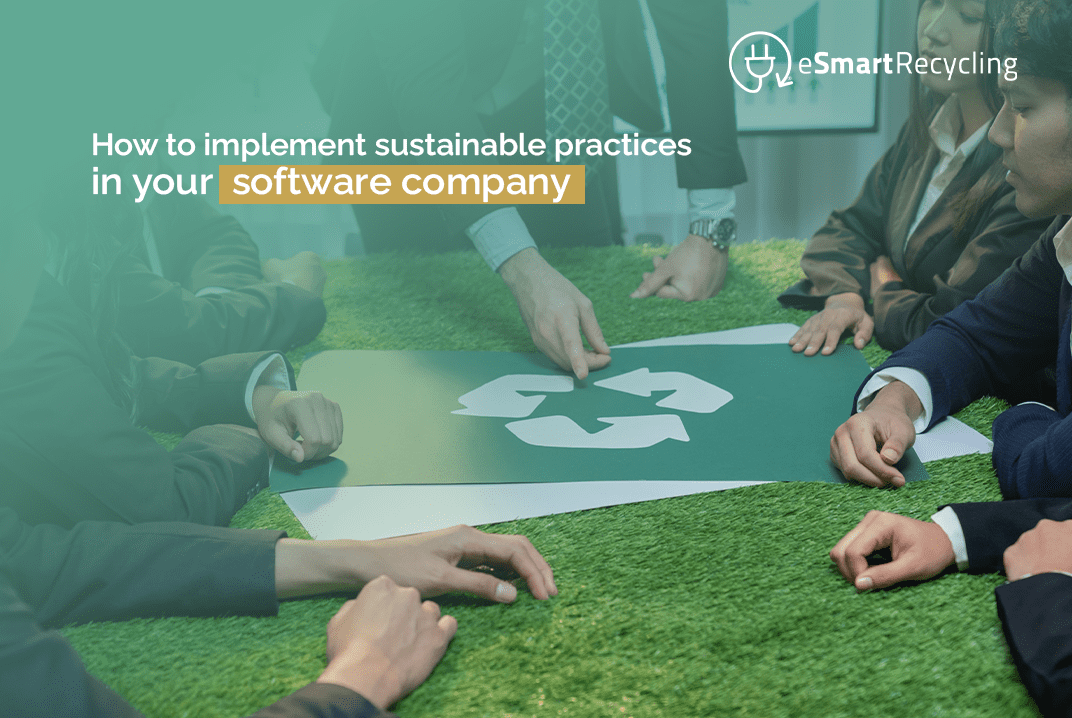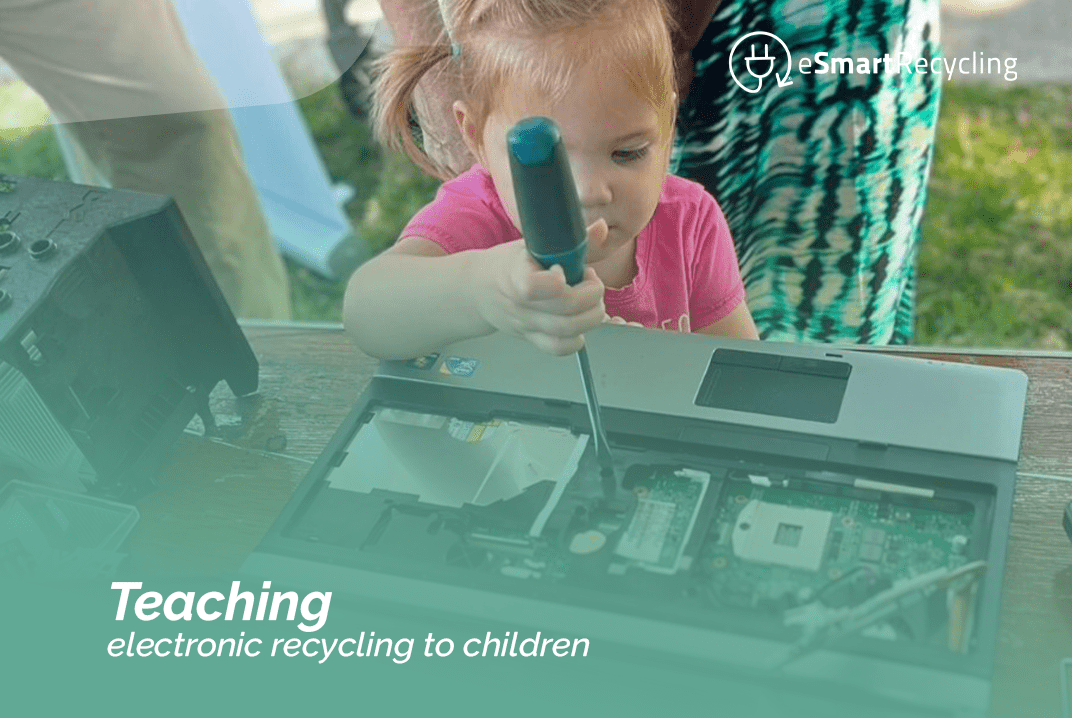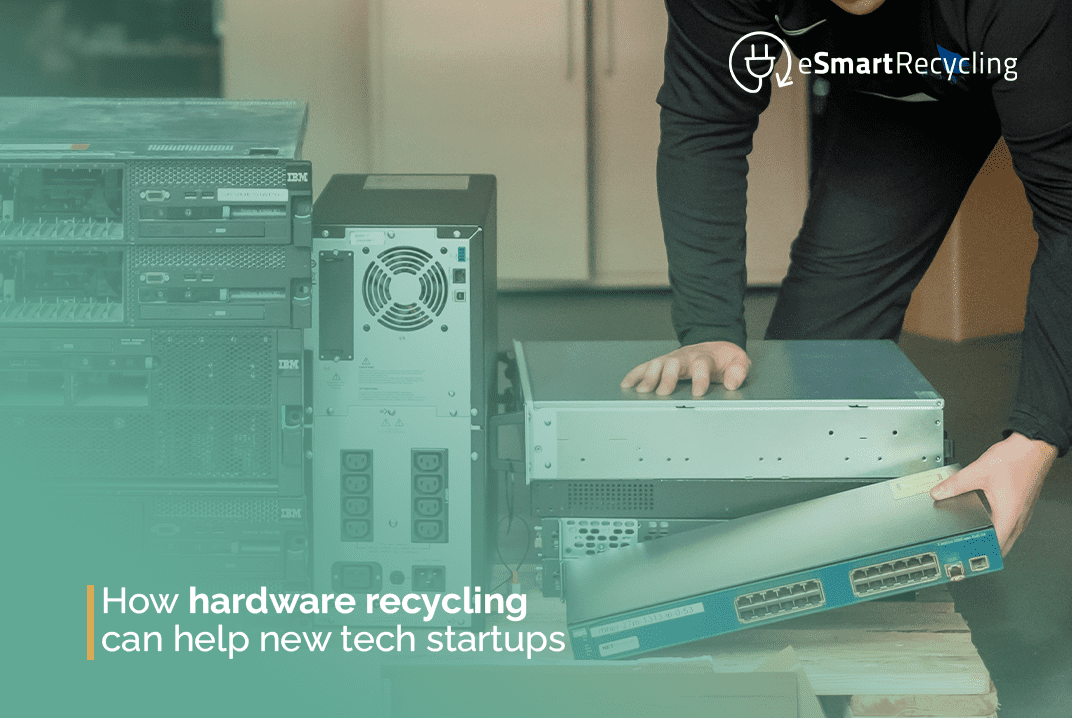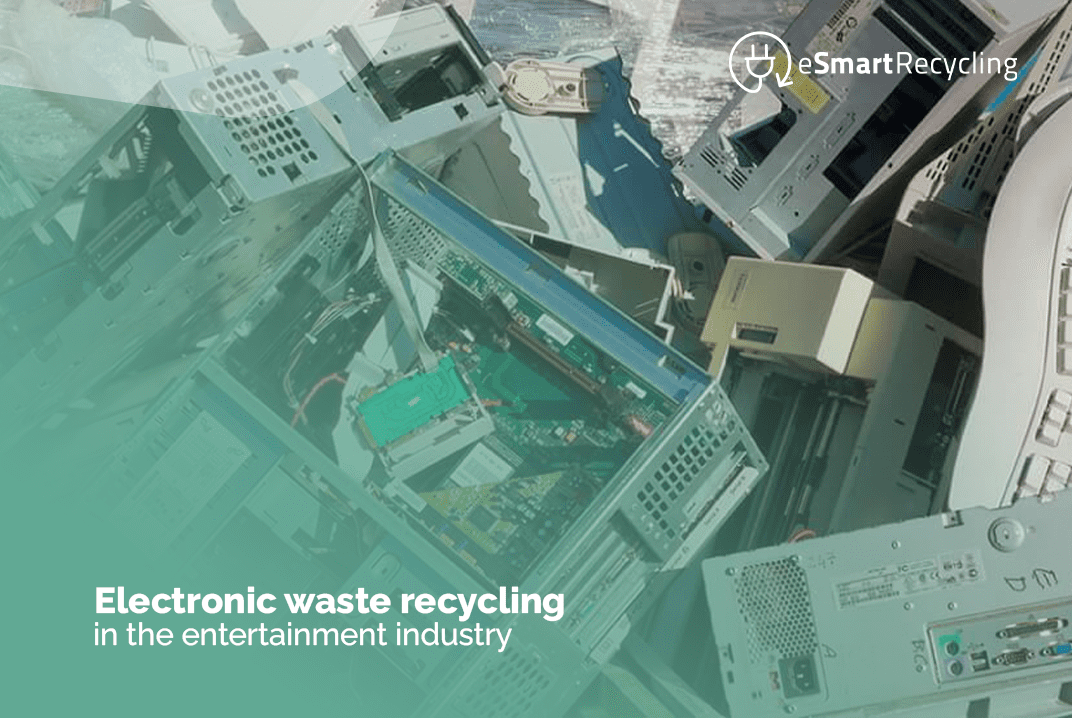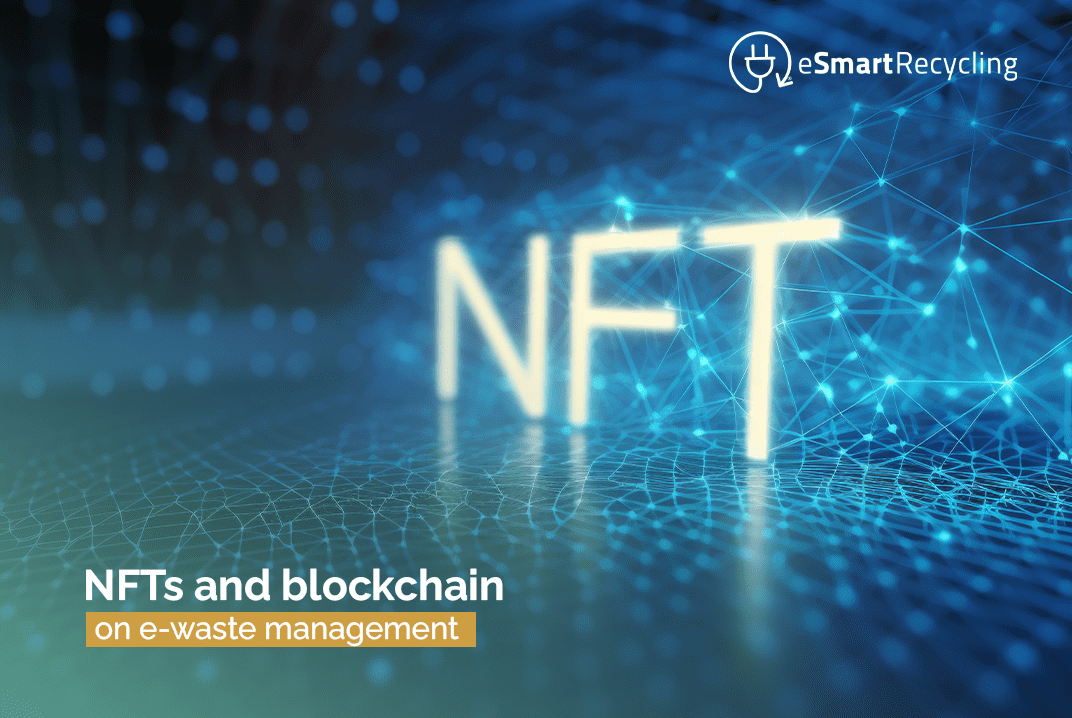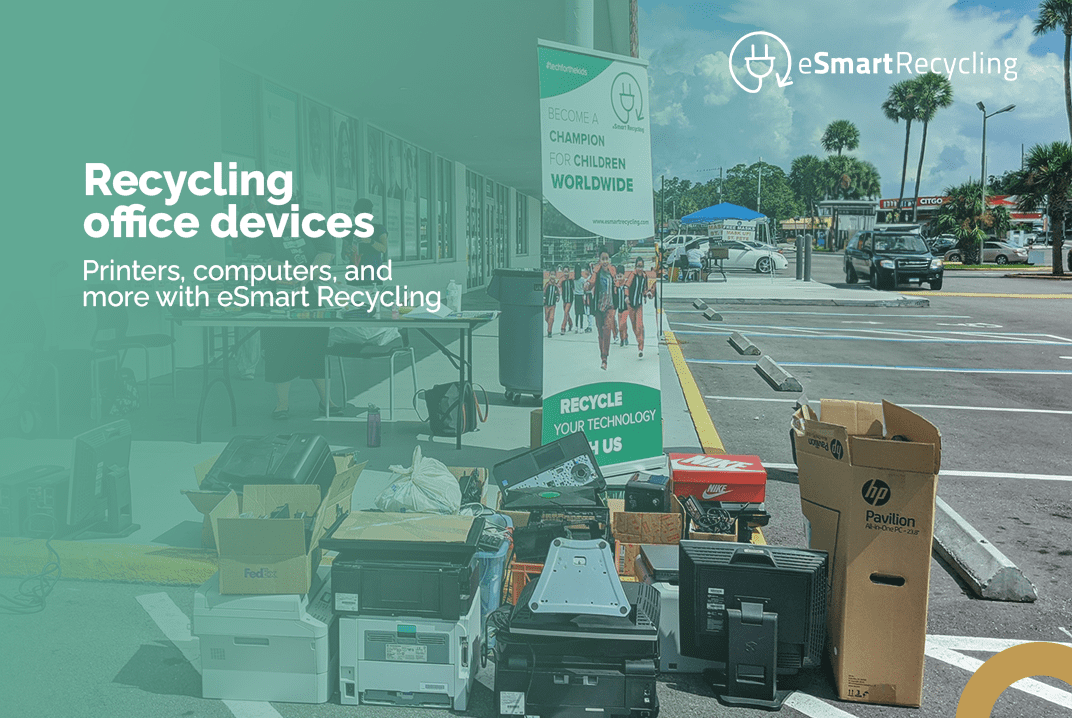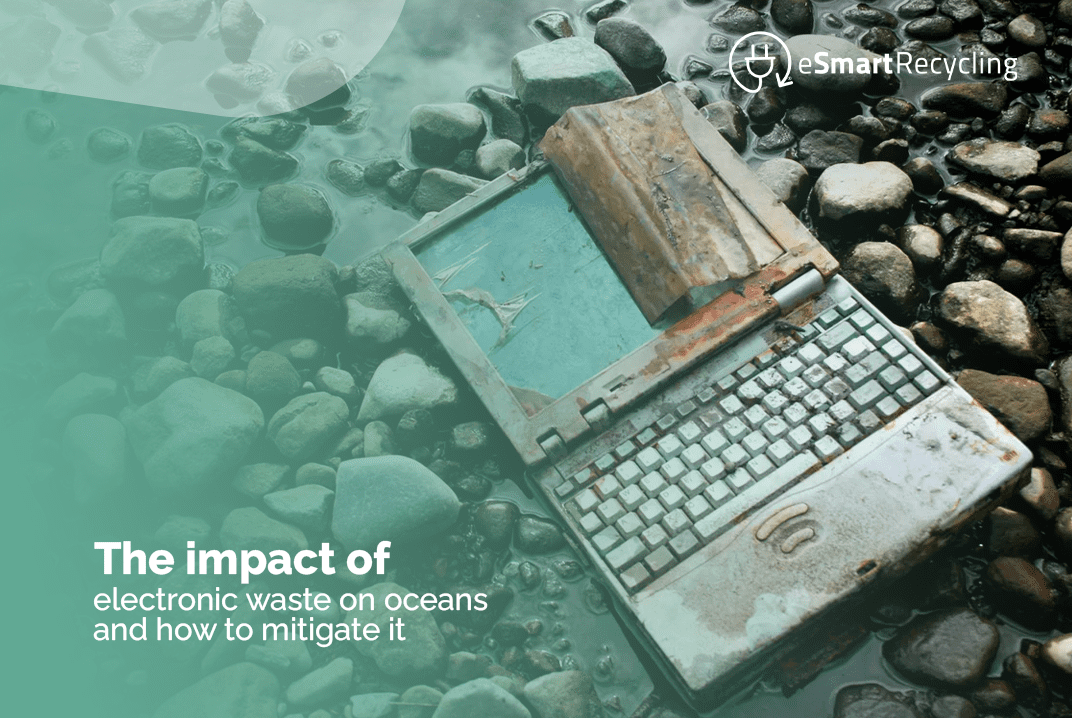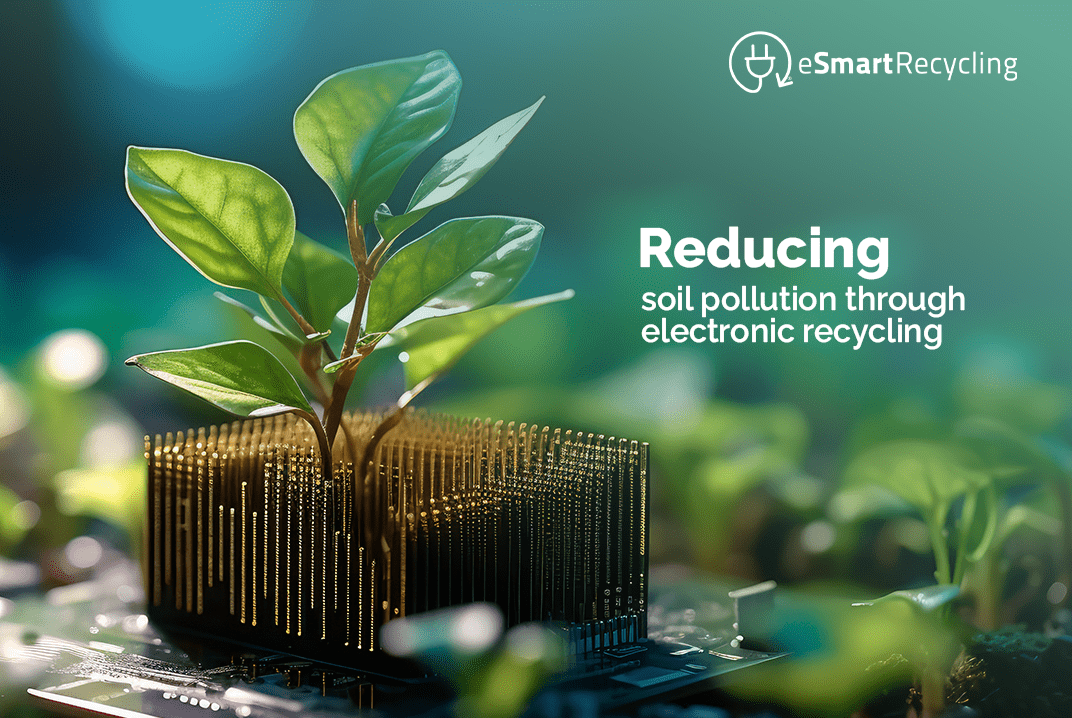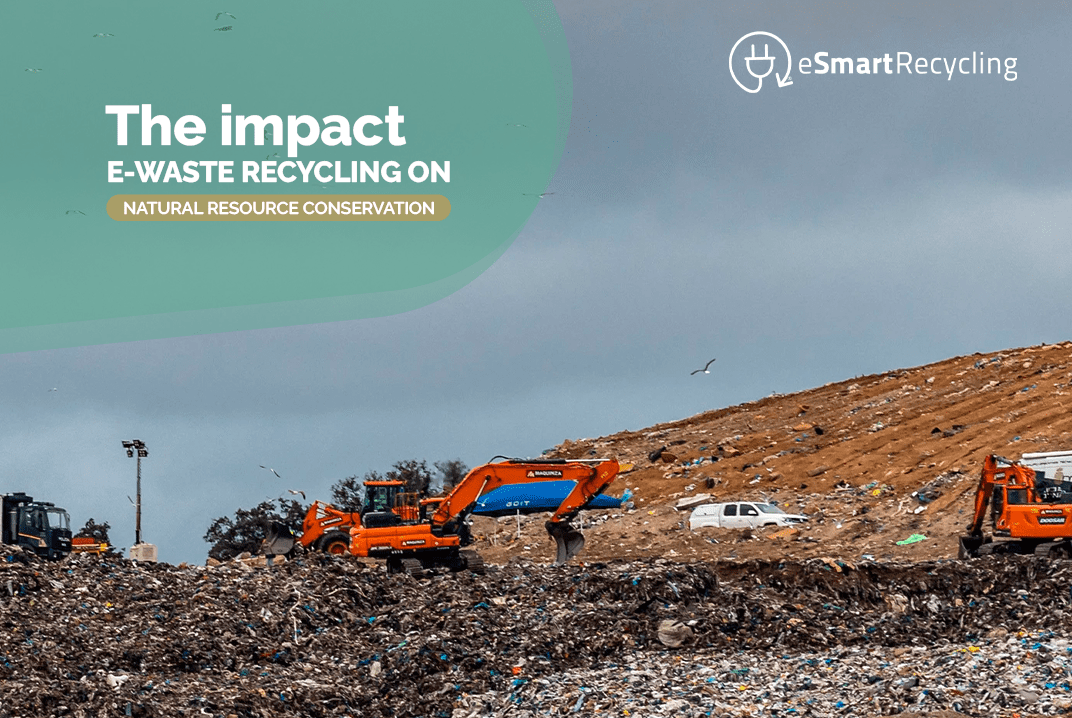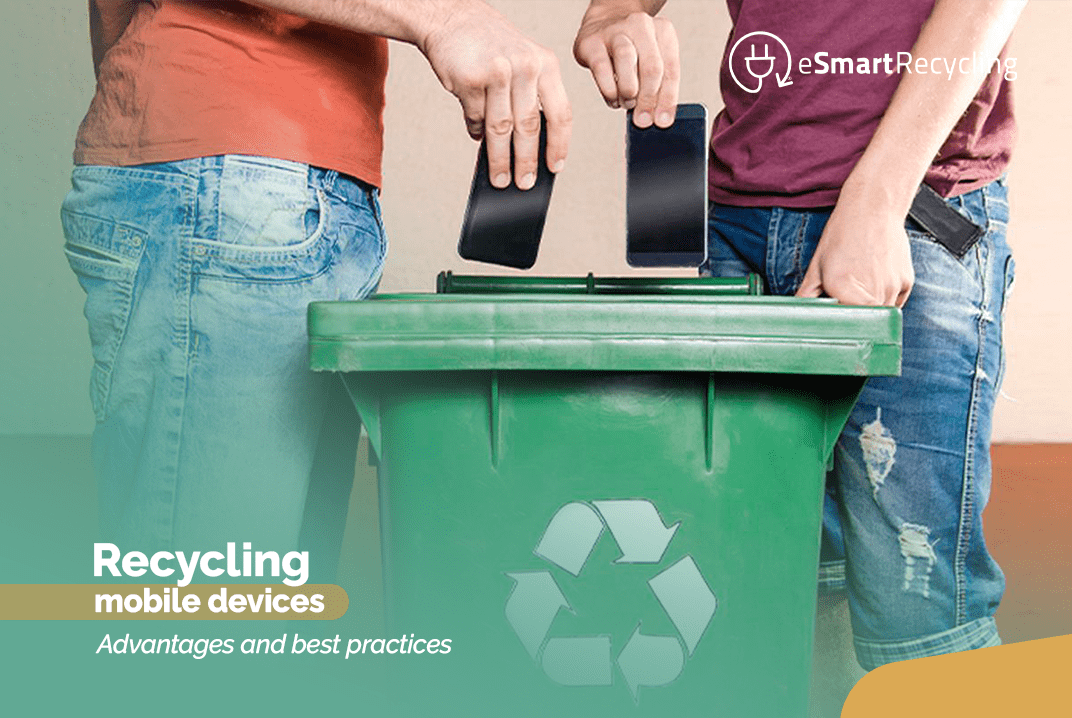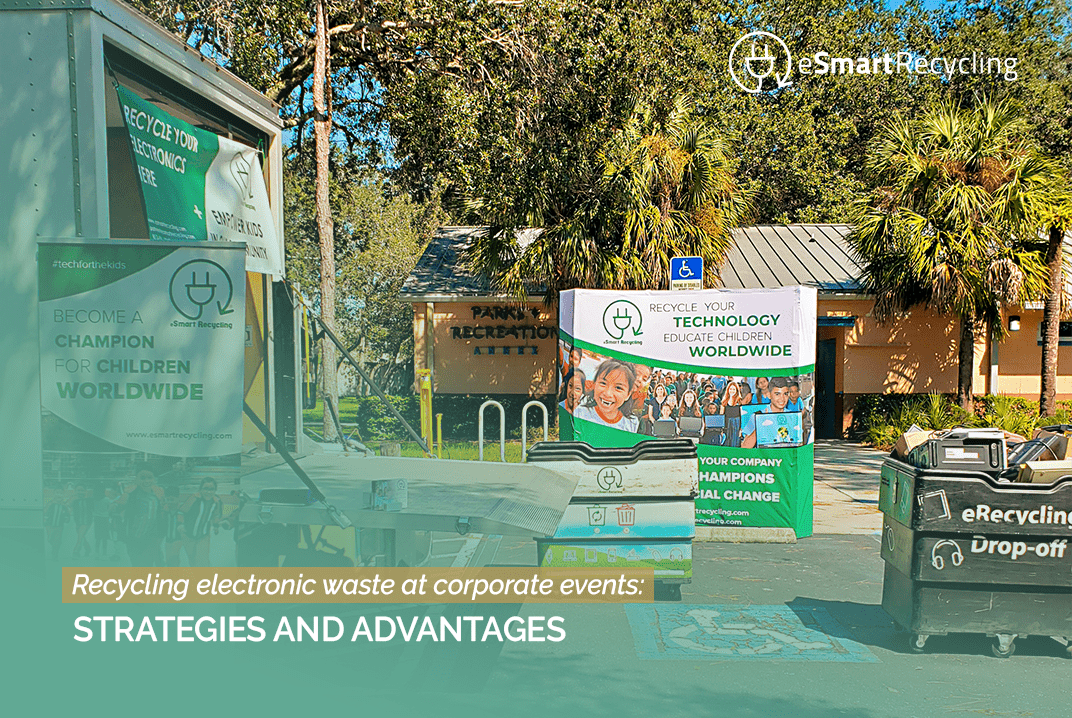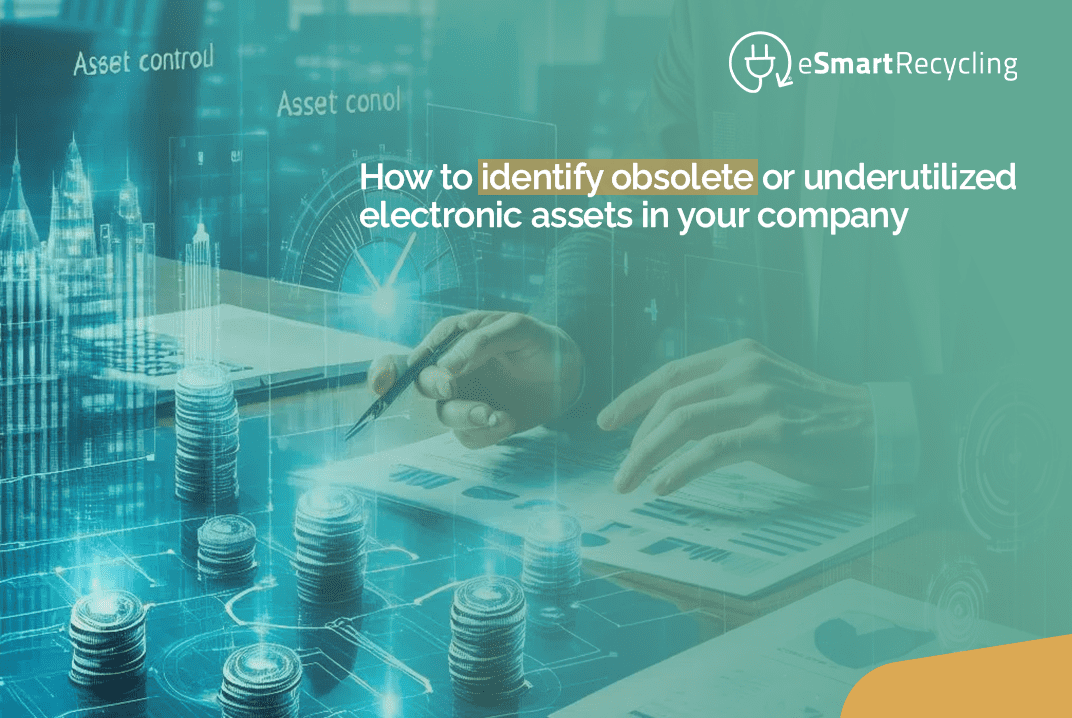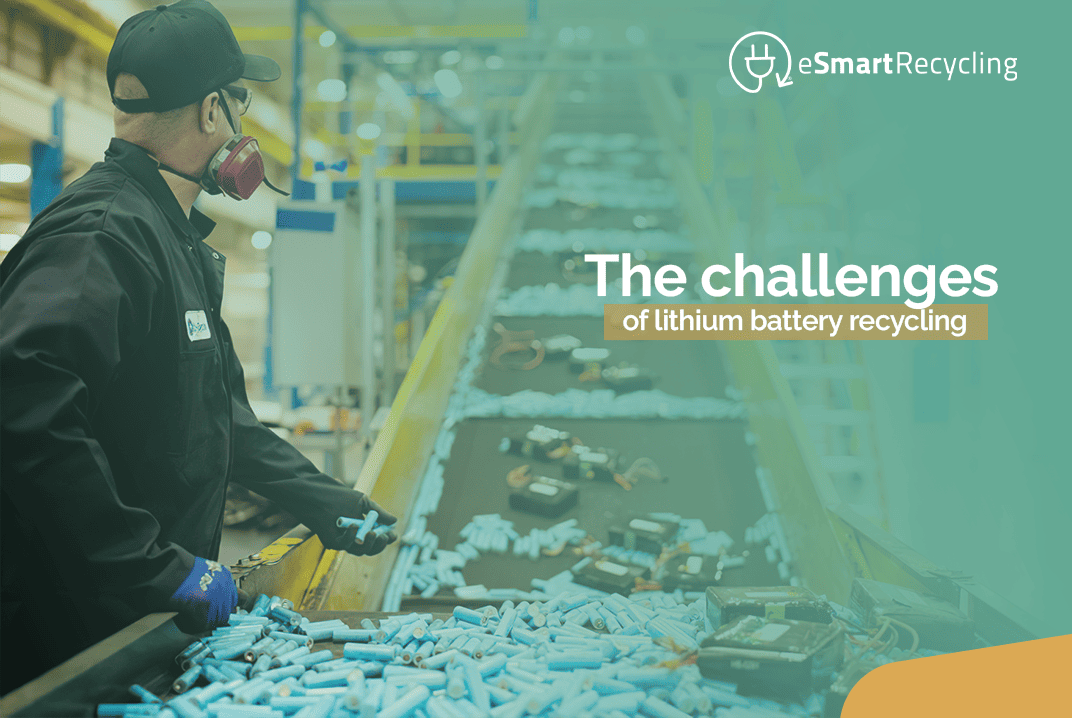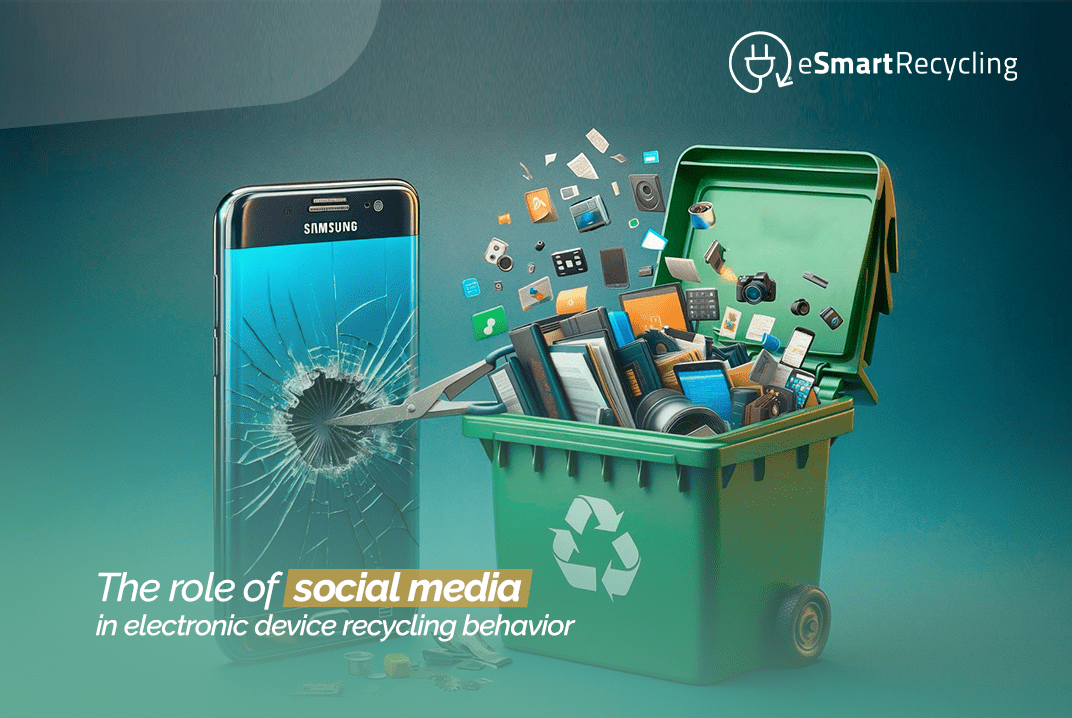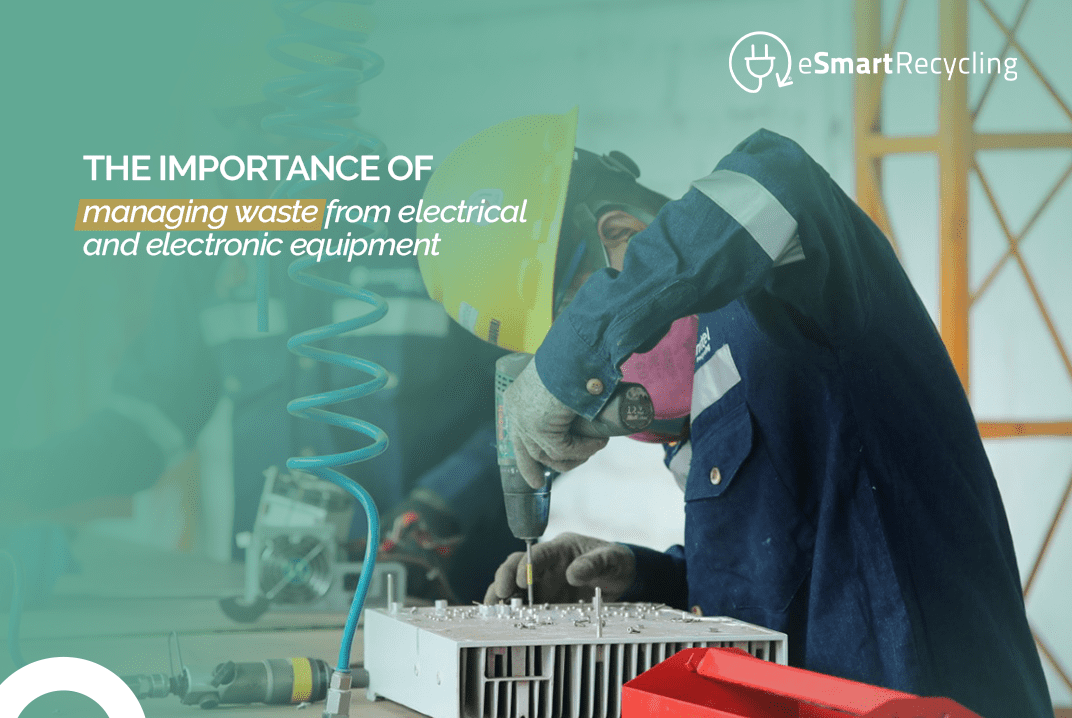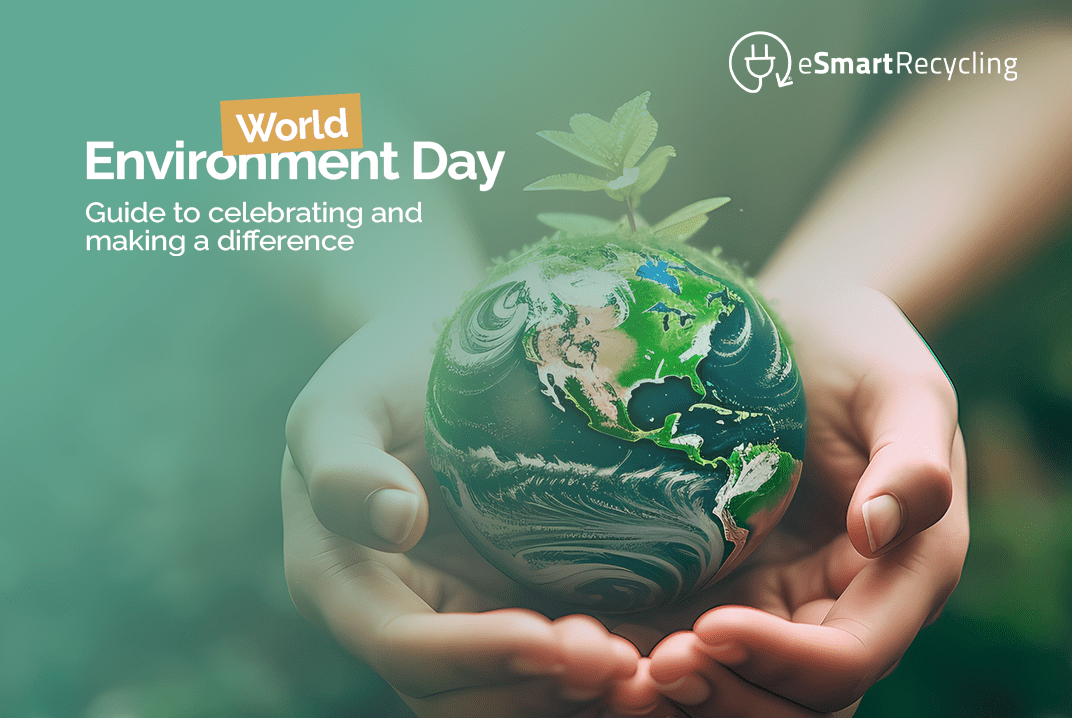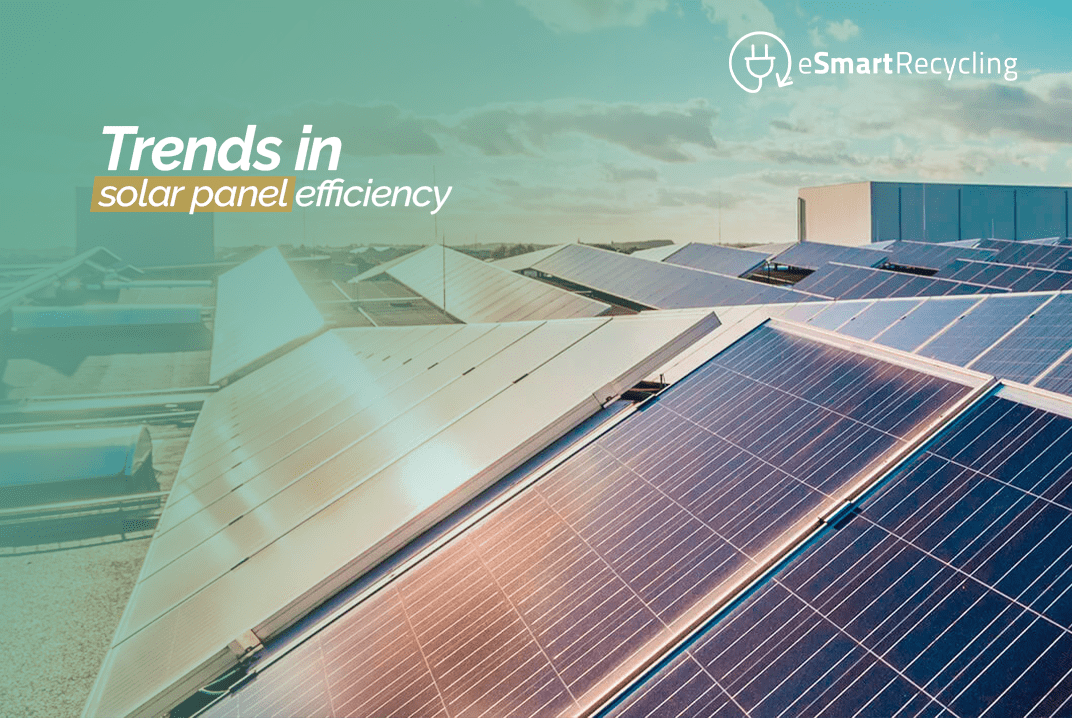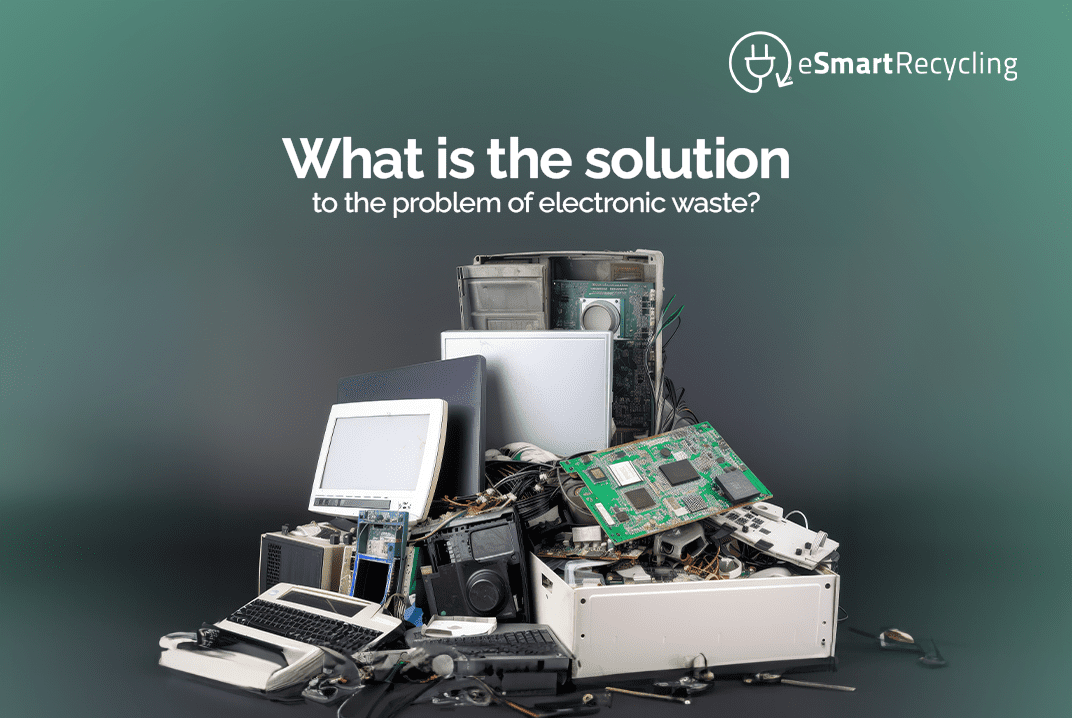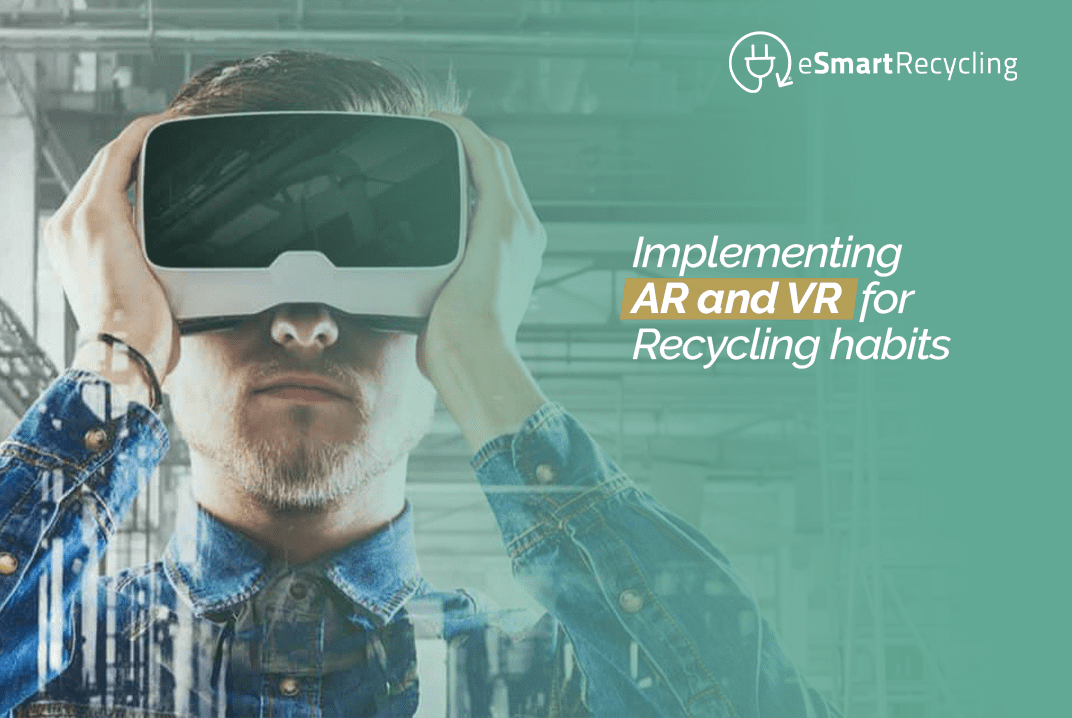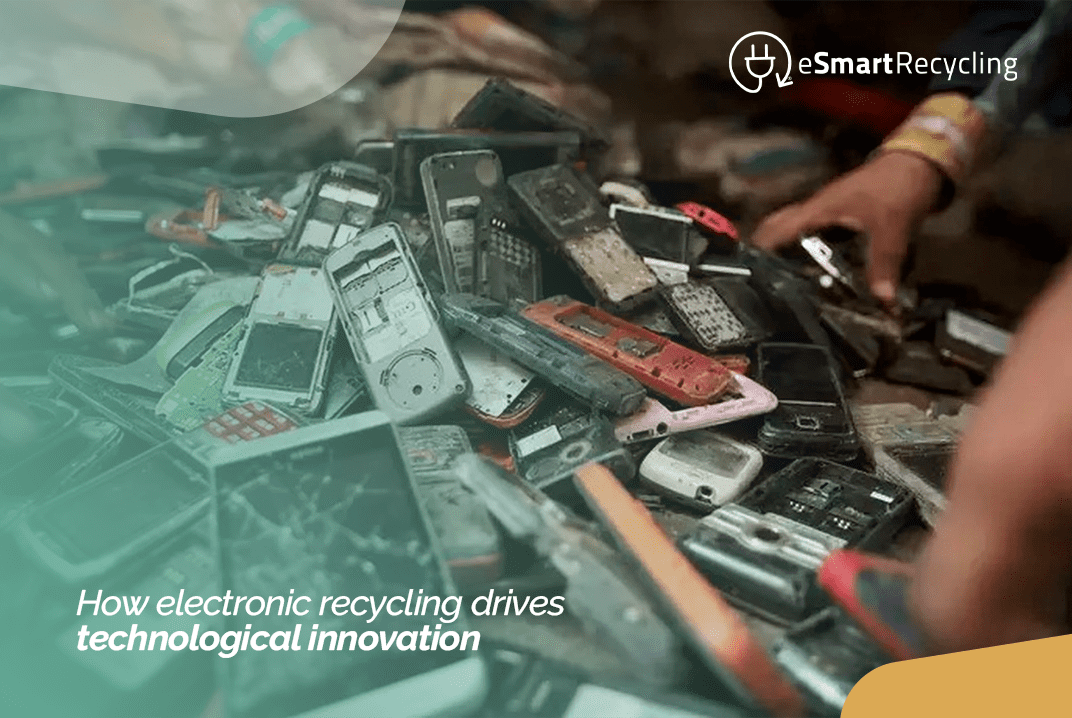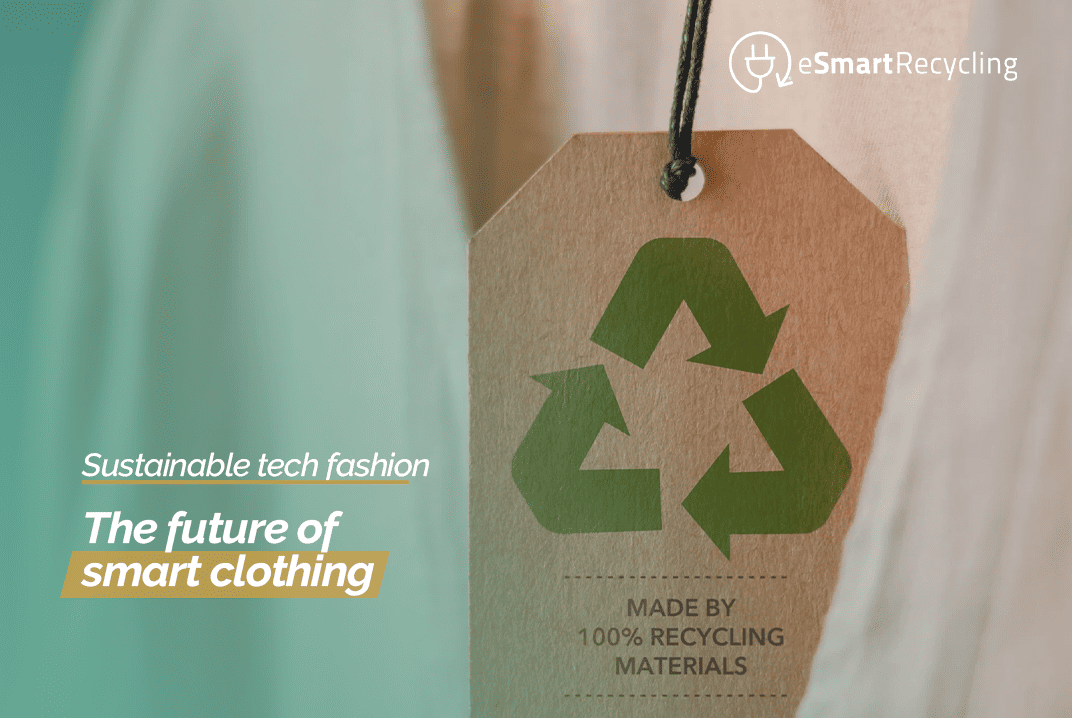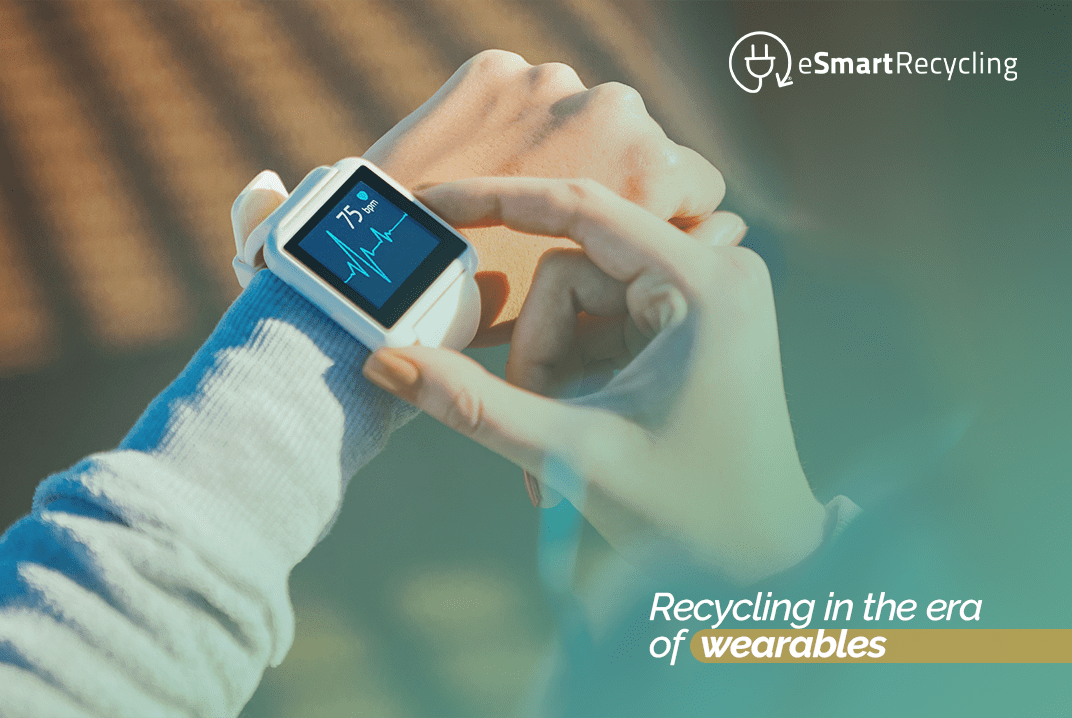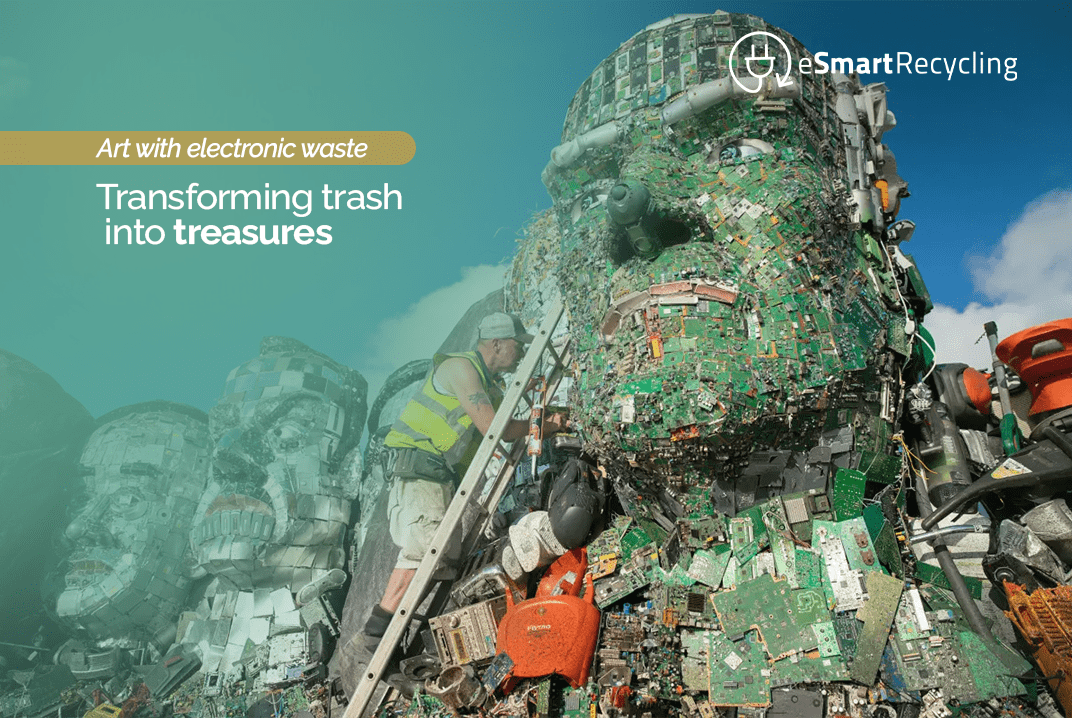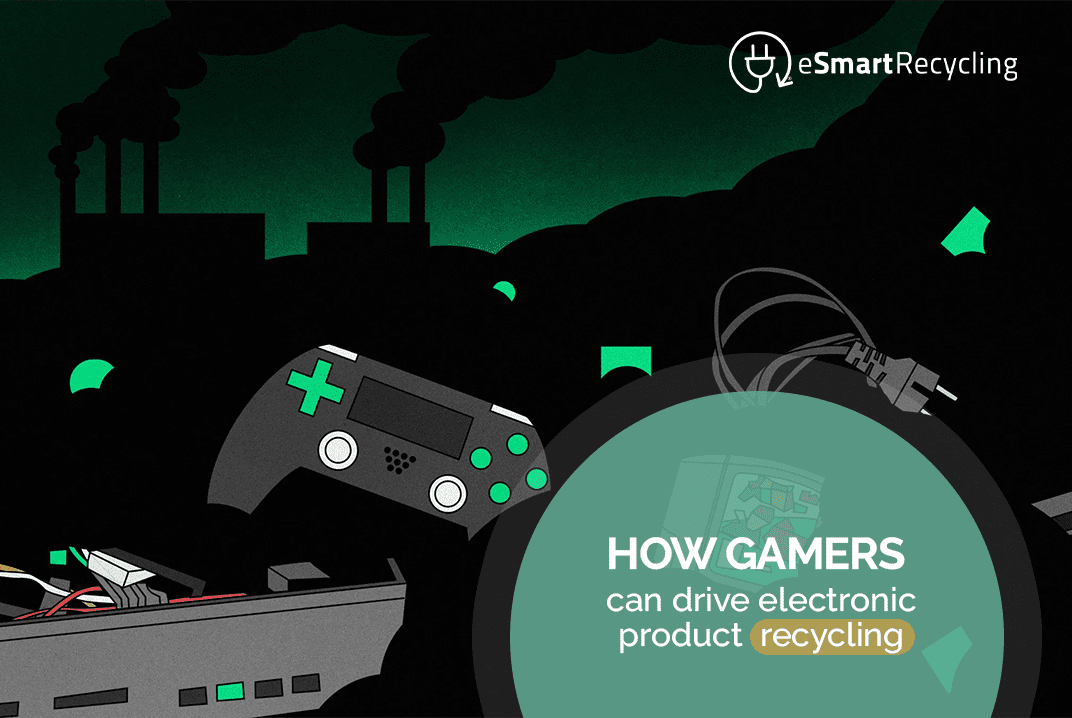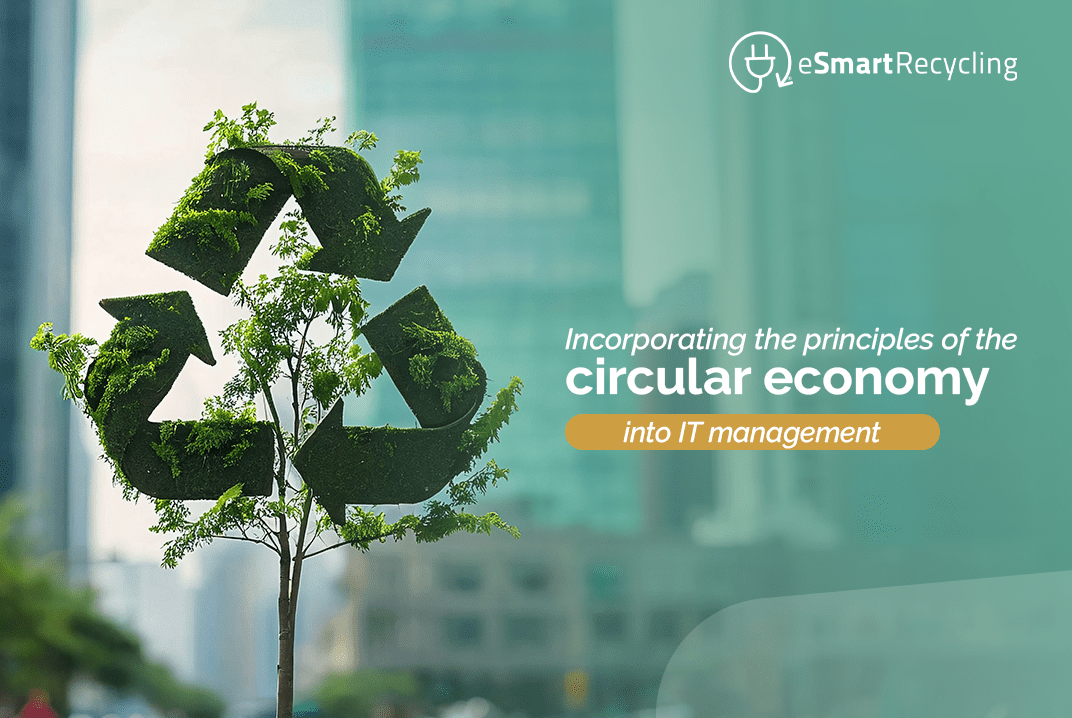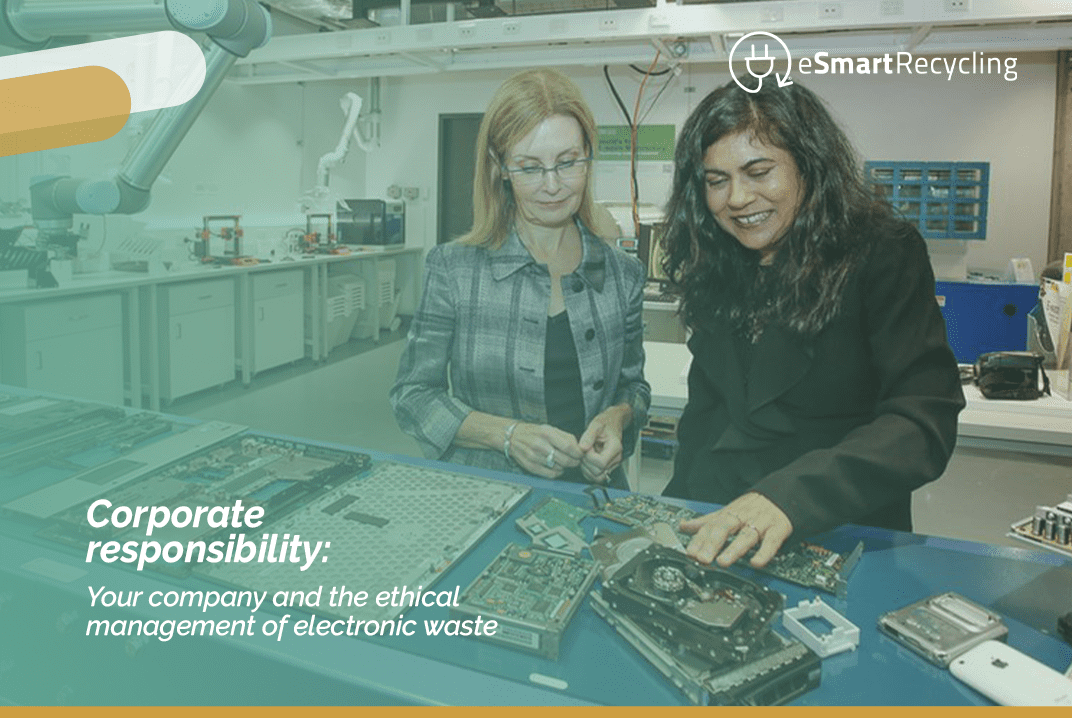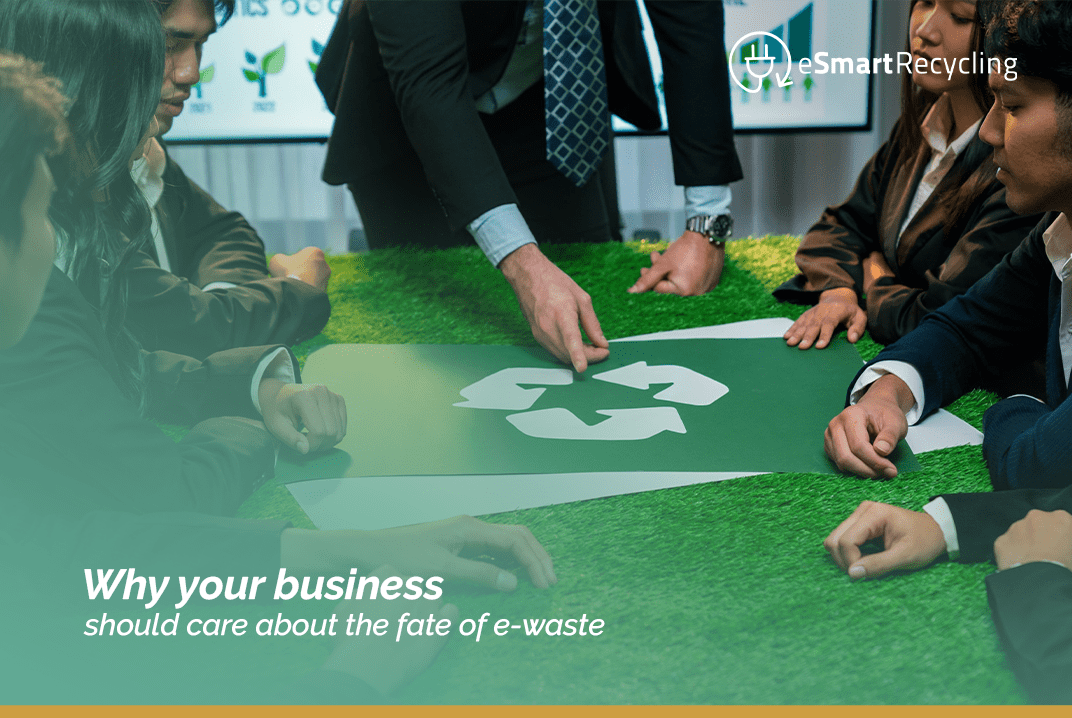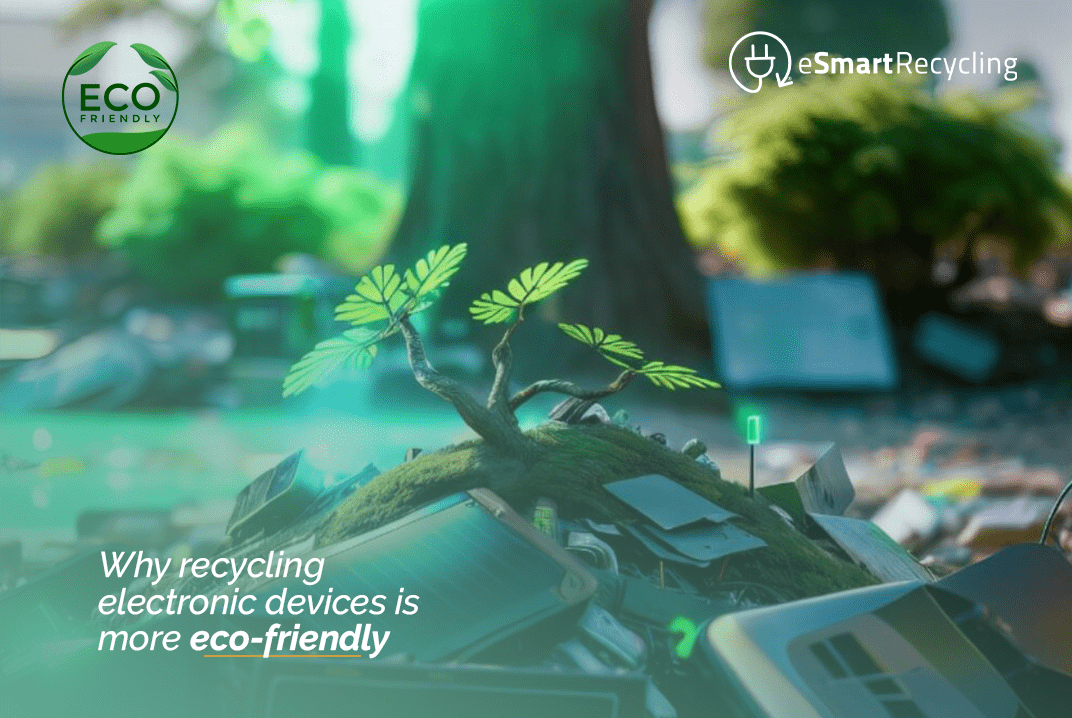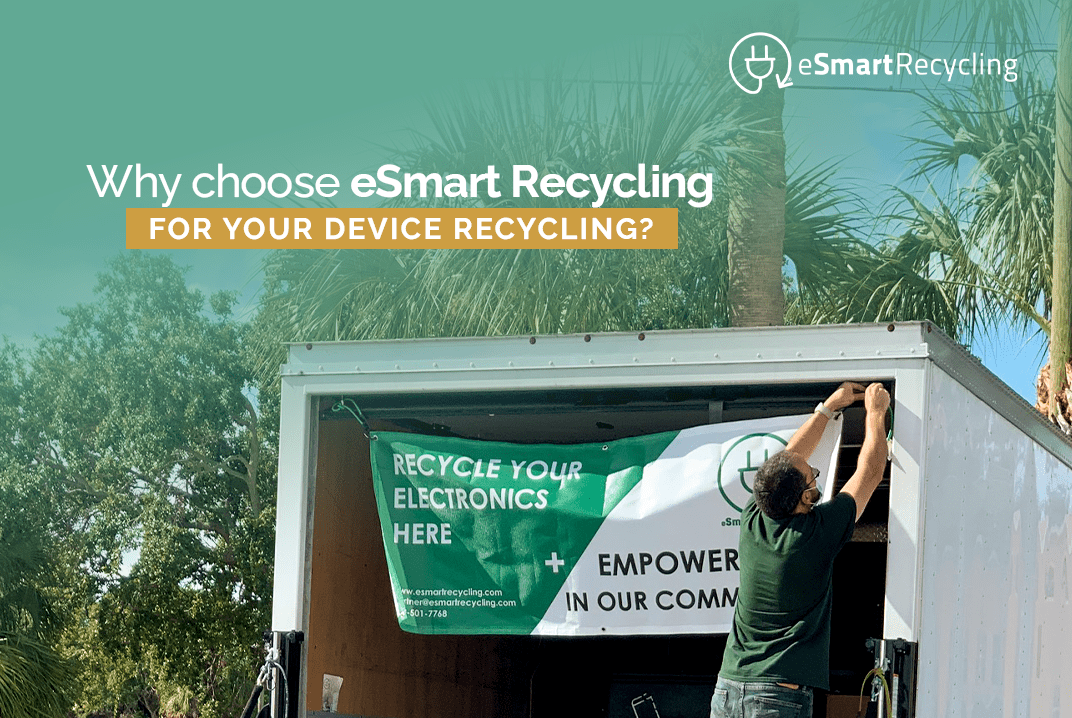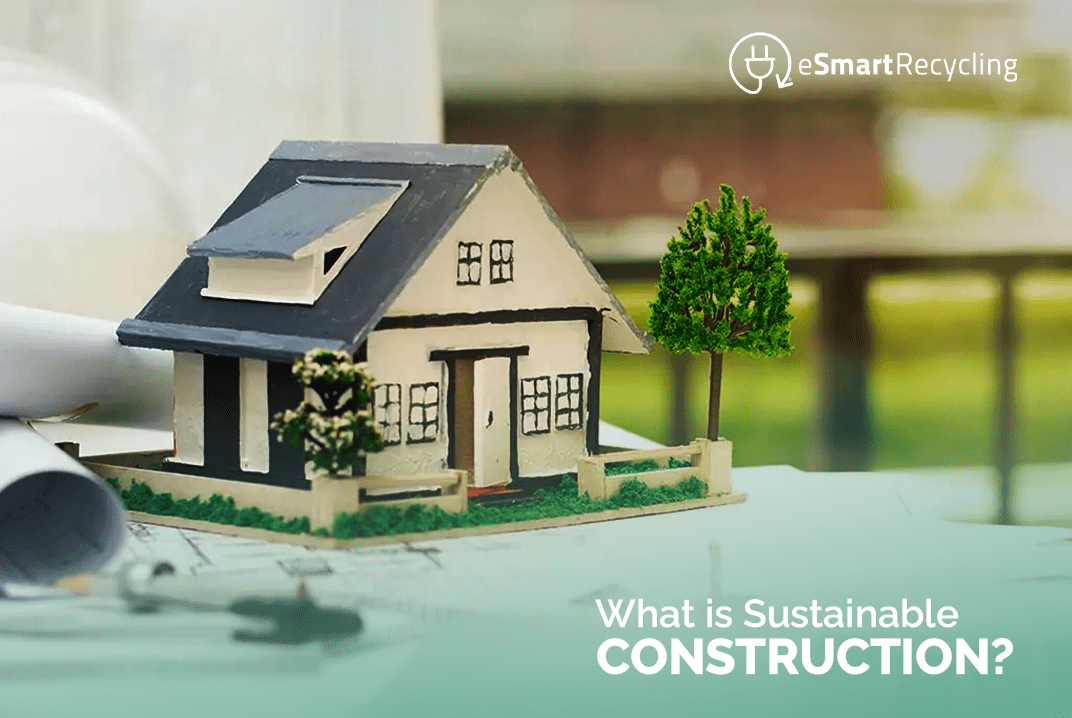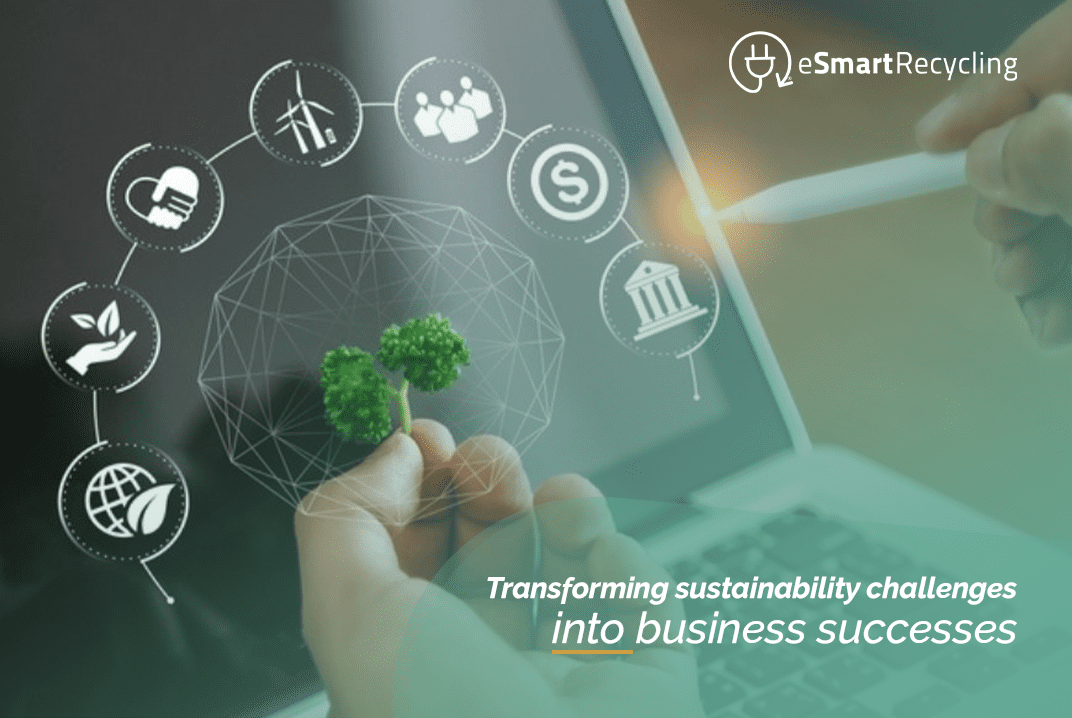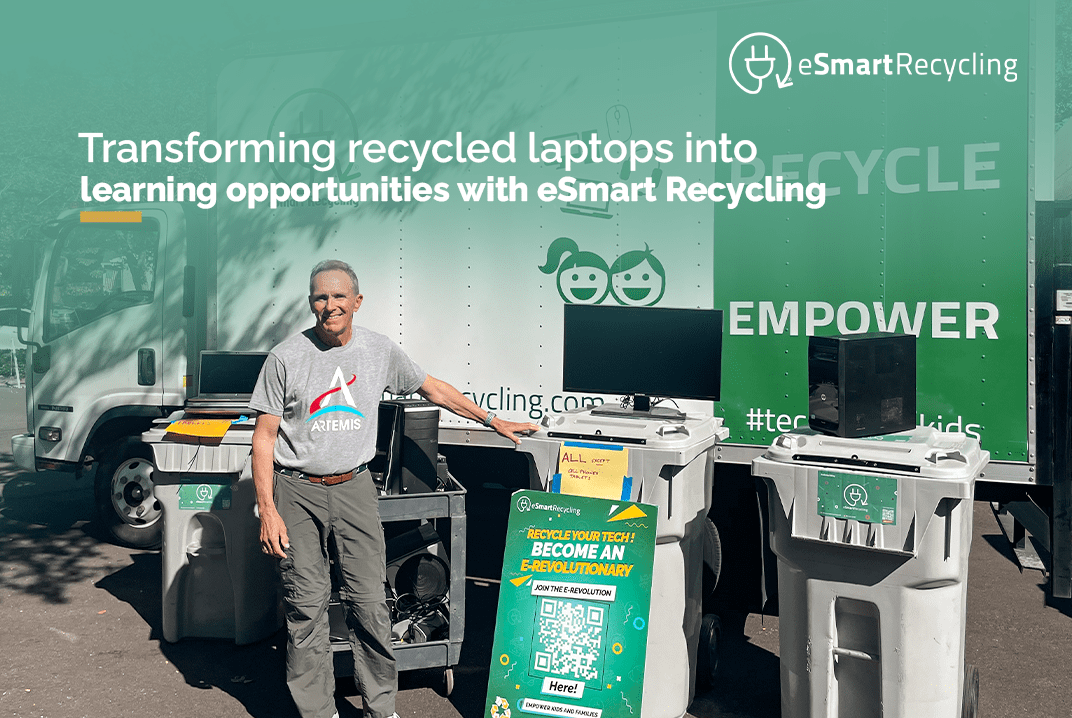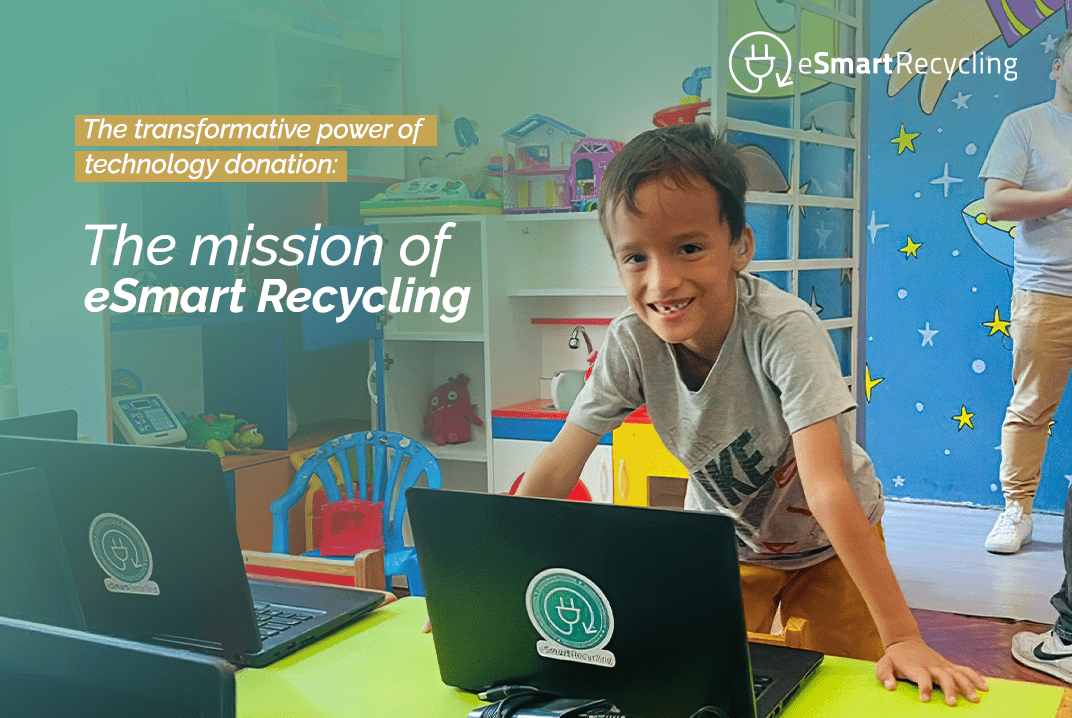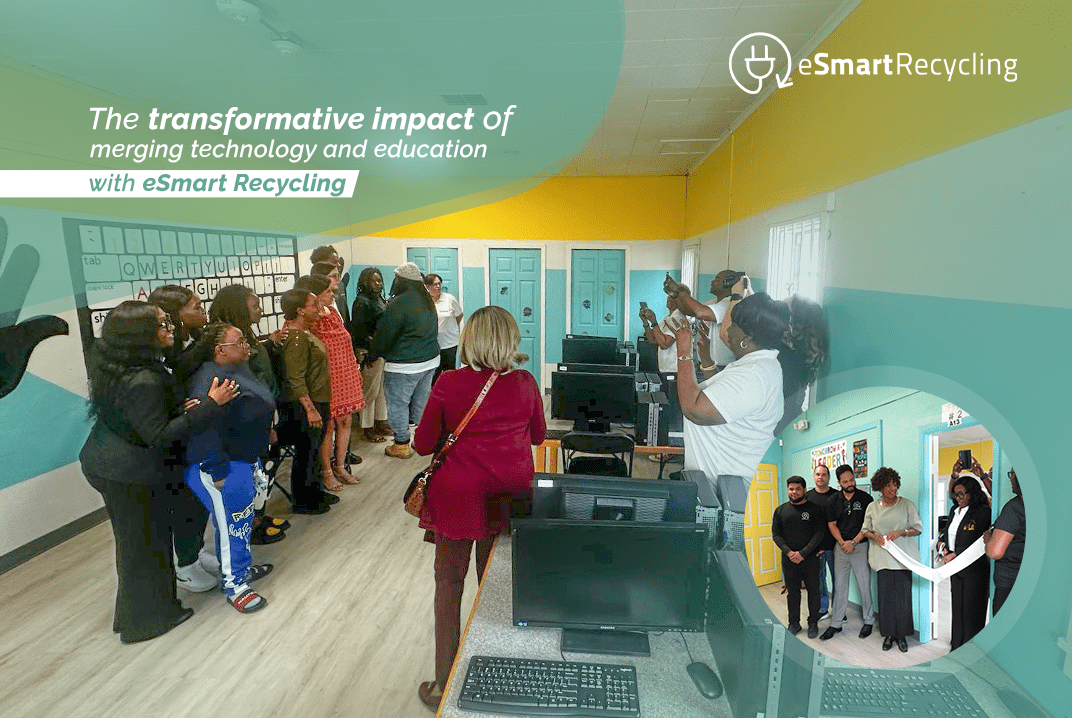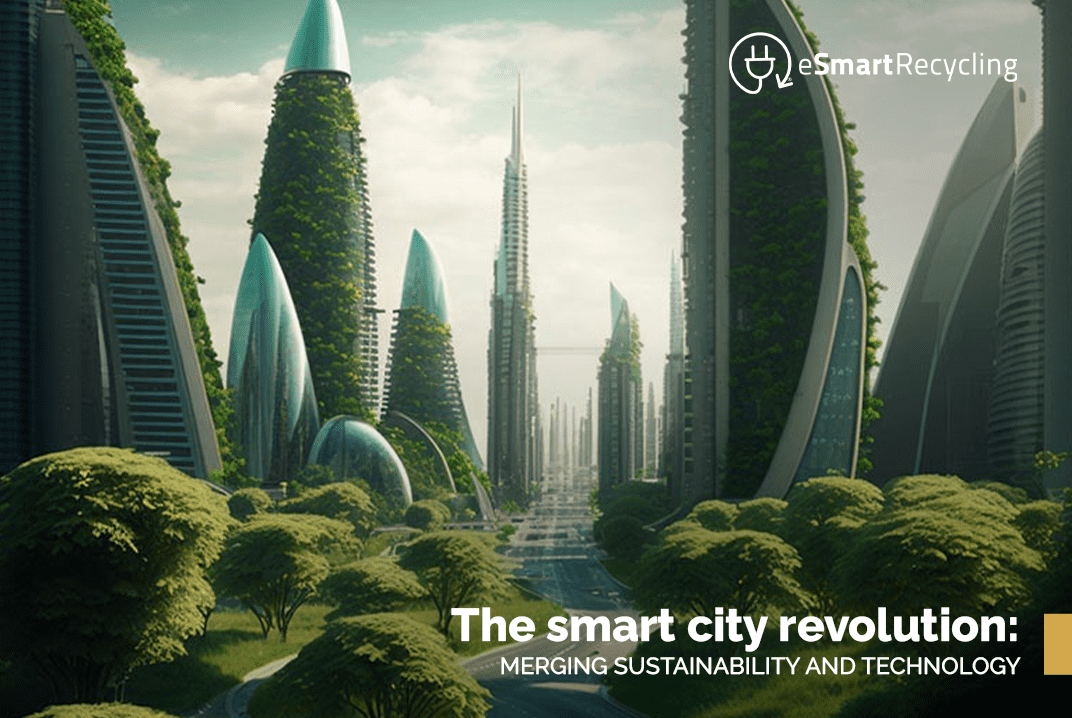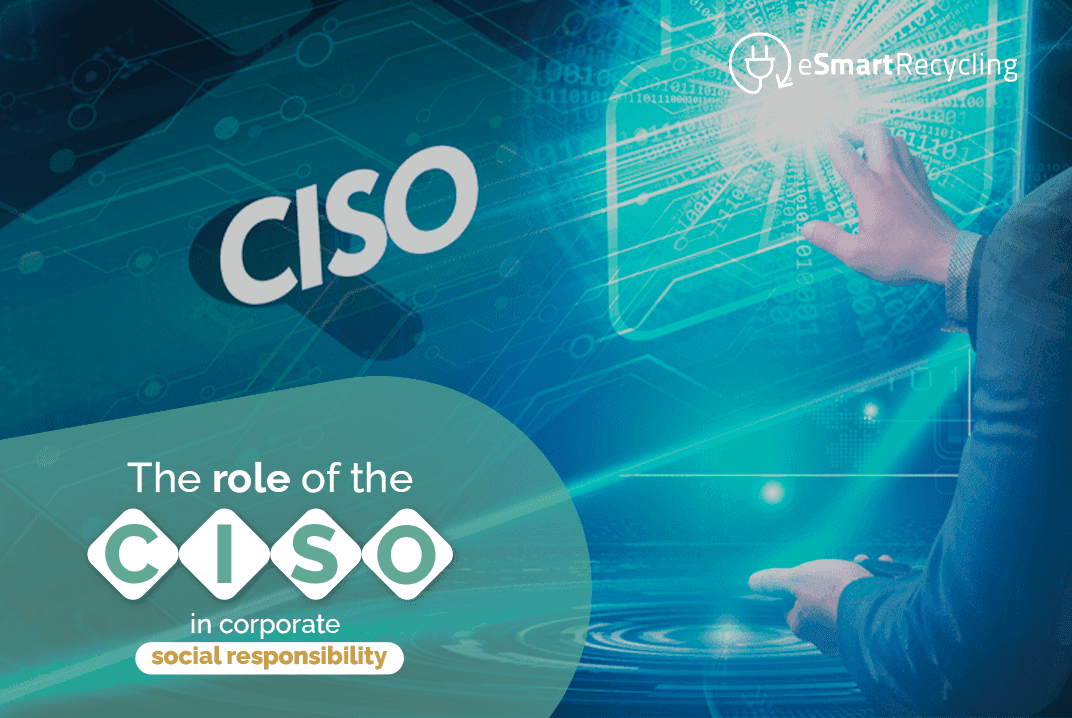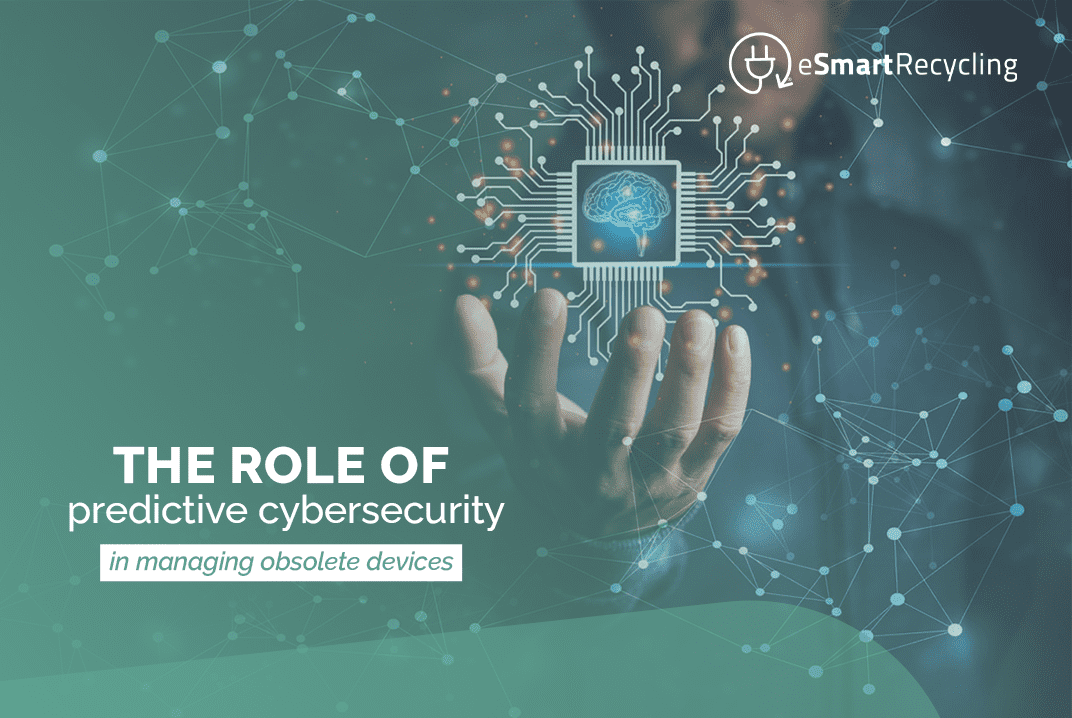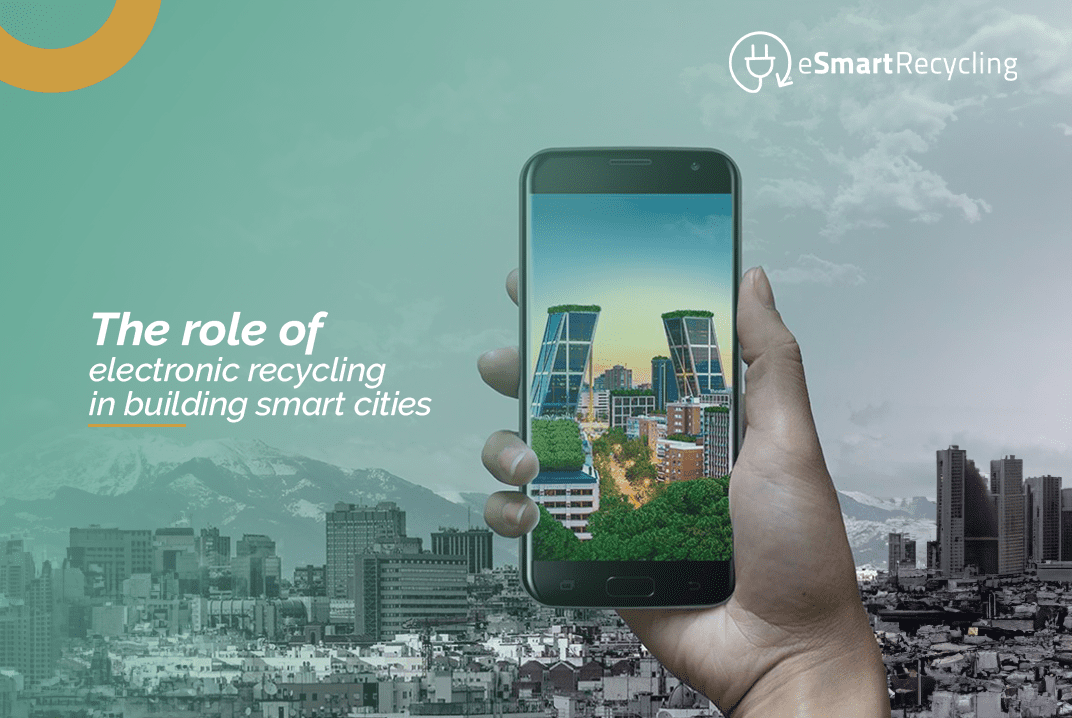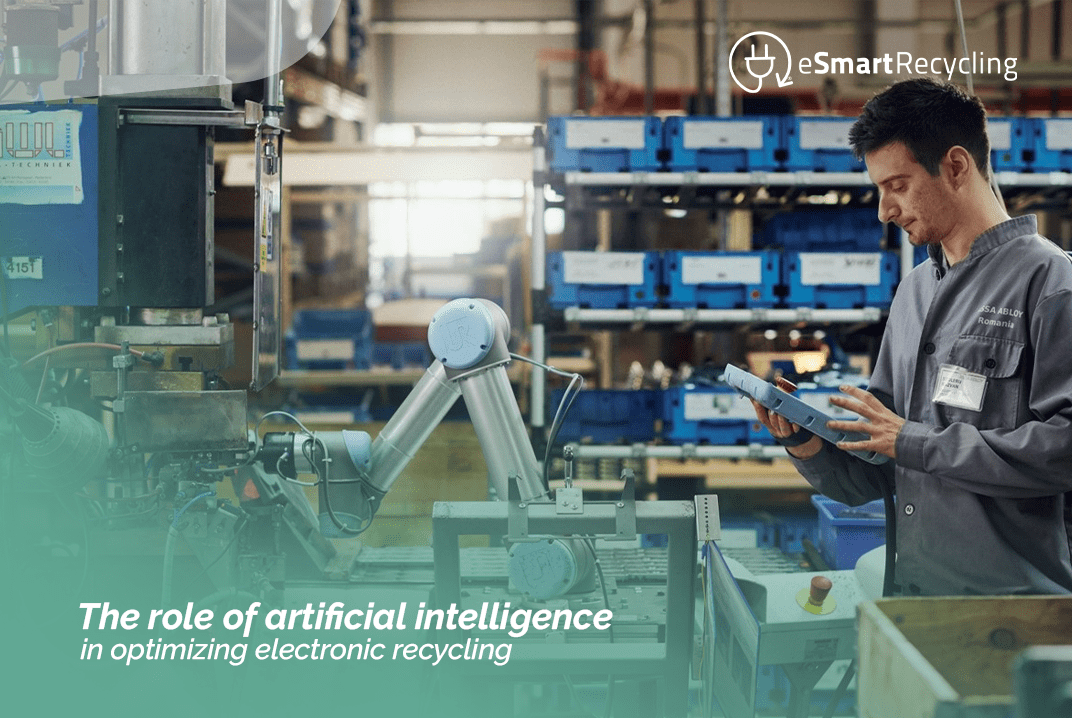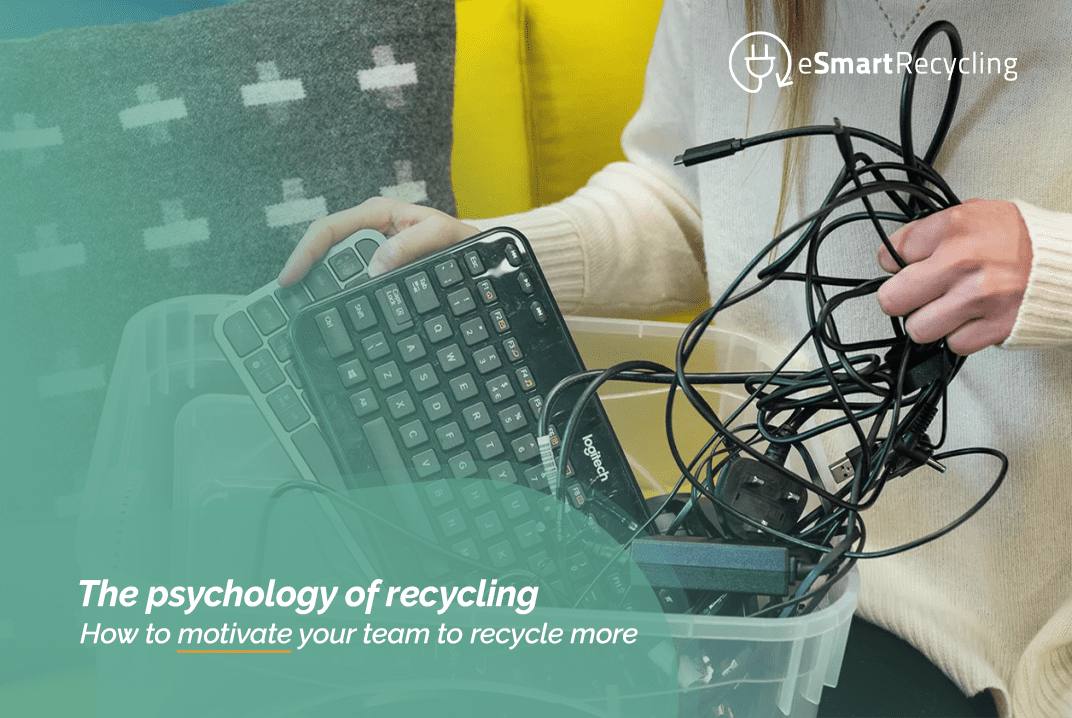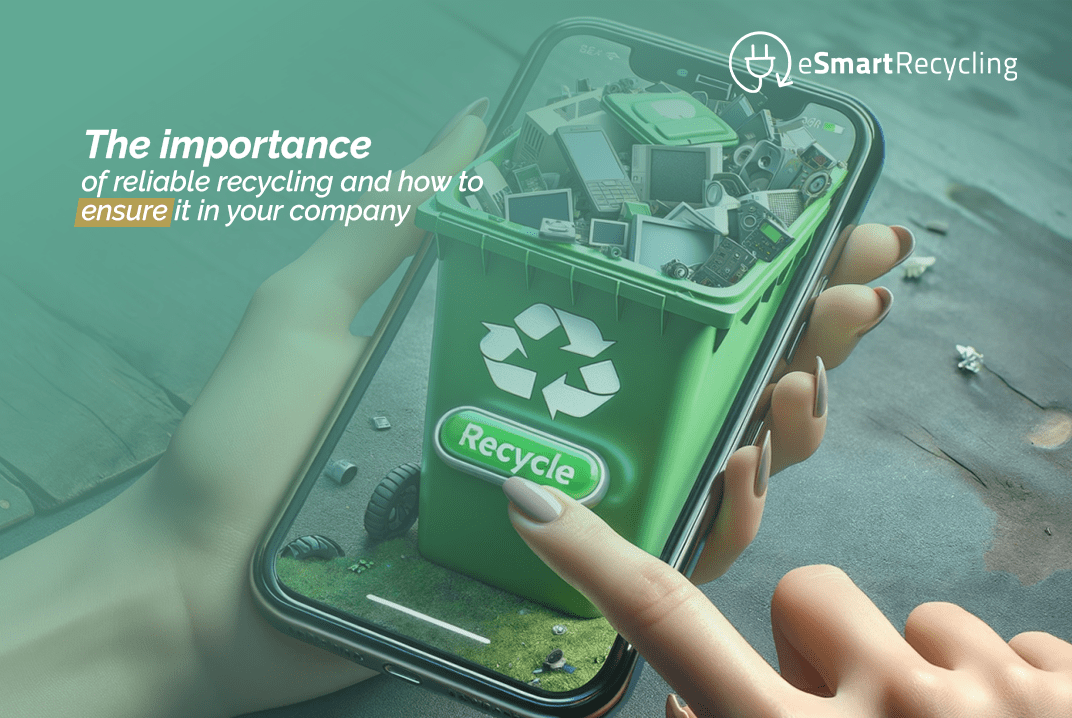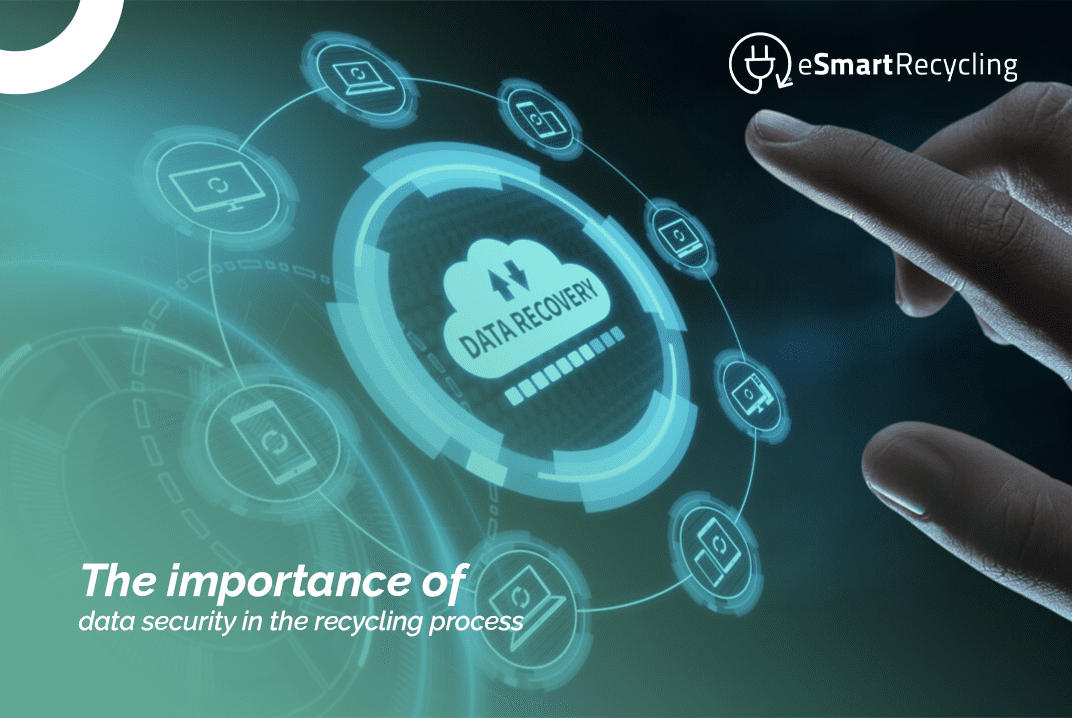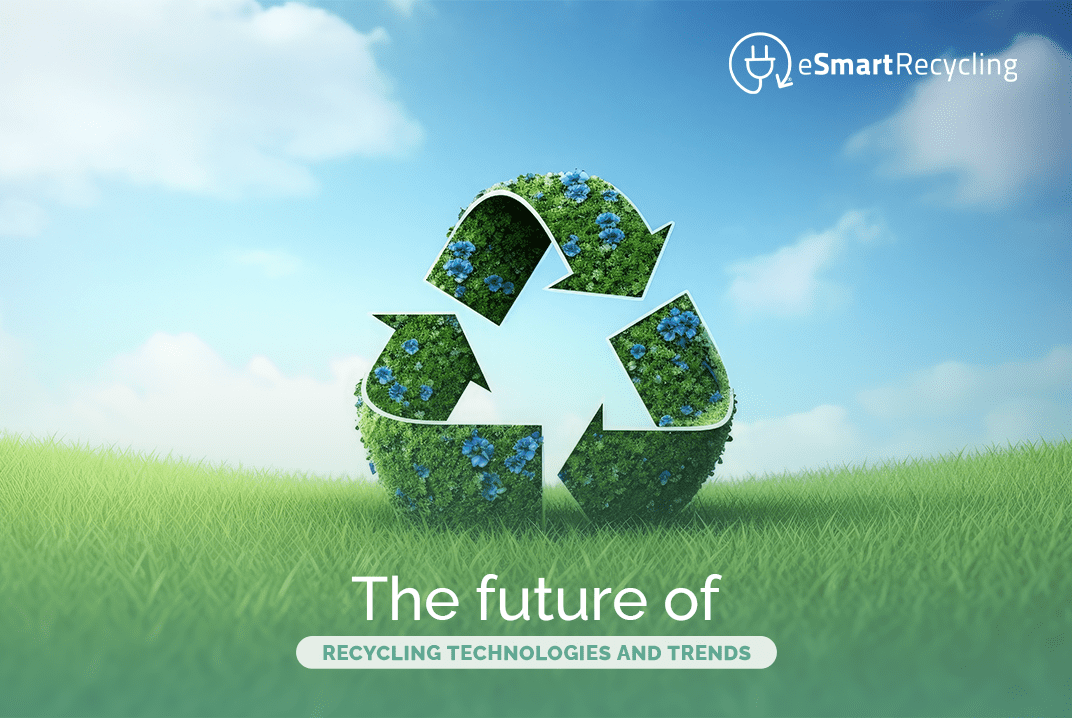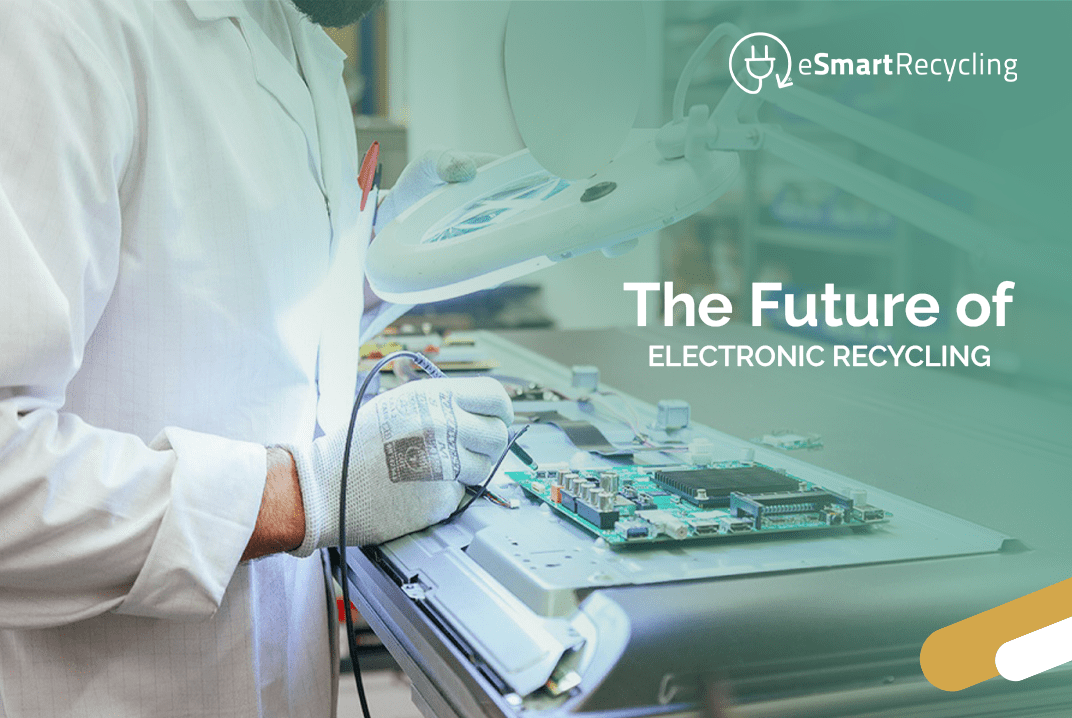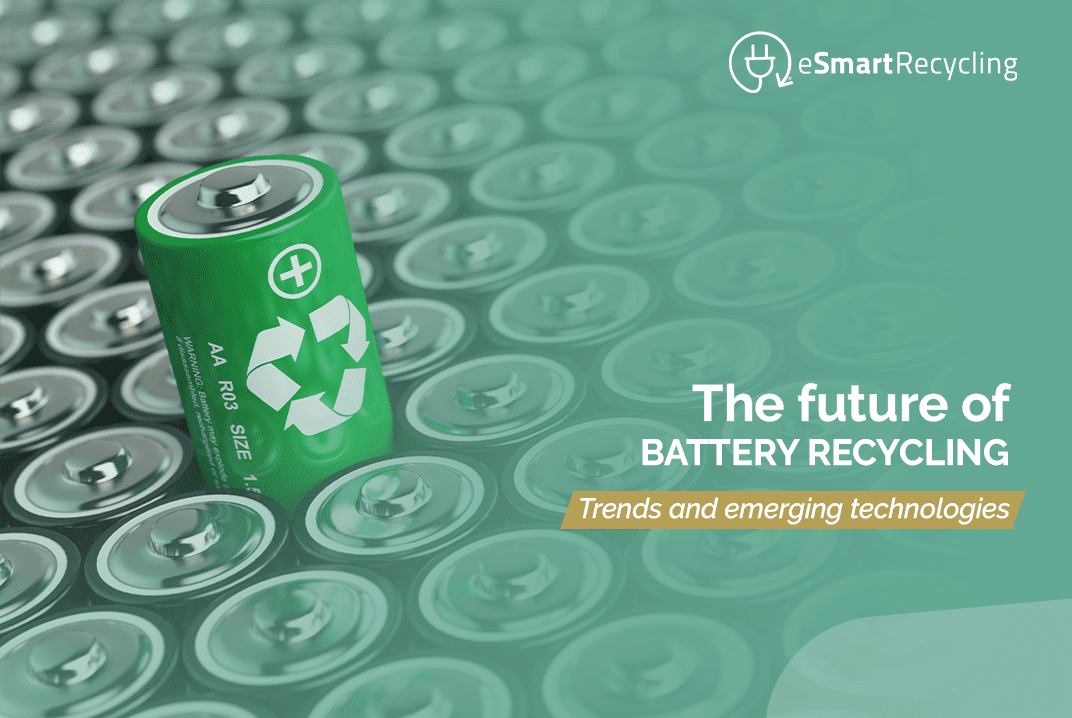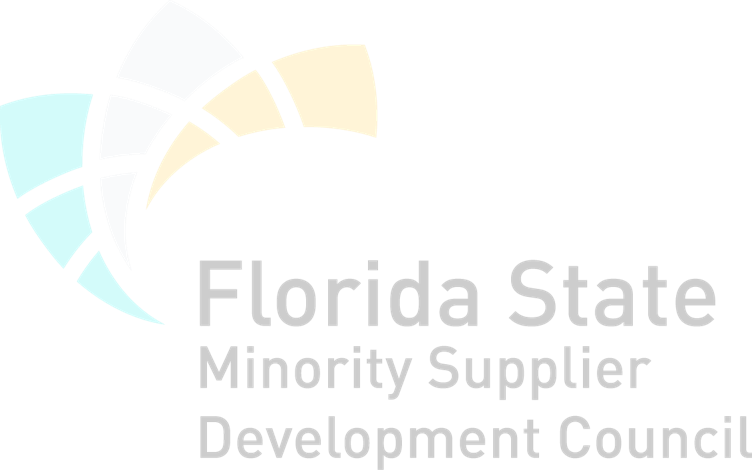eRecycling News & articles
Join our community for exclusive insights, latest updates, and special offers delivered straight to your inbox.
Be part of the e-Revolution and subscribe to our newsletter
July 23, 2024
More and more companies are starting to implement electronic device recycling programs to reduce their environmental impact and meet their sustainability goals. However, getting employees to participate in e-recycling programs can be quite challenging. In this article, we’ll discuss some strategies to increase employee participation in electronic recycling programs within companies.
Inform employees about the benefits of electronic recycling
The first step to increasing employee participation in e-recycling programs is ensuring that all employees understand the benefits of recycling electronic devices. Recycling is not only good for the environment, but it can also help companies save money, reduce their carbon footprint, and create a positive image for the company. Make sure to explain these benefits in detail to educate employees about the importance of electronic recycling.
Address common concerns about electronic recycling
Many employees may have concerns about electronic recycling, such as data security and understanding what can and cannot be recycled. Companies need to address these concerns and provide employees with the information they need to feel comfortable participating in the program. For example, companies can create a data security policy, inform employees about the types of devices that can be recycled, and provide electronic recycling bins in common work areas to make participation even easier for employees.
Introduce incentives for electronic recycling
Another way to encourage employee participation in e-recycling programs is to introduce incentives. Incentives can take many different forms, such as discounts on company services or products, time off, or recognition and rewards. These incentives can help employees feel that they are making a difference and can also foster a bit of friendly competition in the office.
Implement a company-wide policy on electronic recycling
The most important step to increasing employee participation in e-recycling programs is to implement a company-wide policy that makes electronic recycling mandatory. This policy can include specific instructions on recycling devices, such as where and how they should be recycled, as well as which types of devices are allowed. Providing clear instructions can help ensure that all employees understand what is expected of them and are more likely to participate.
Implementing an e-recycling program in the company and increasing employee participation can be a challenging task. However, by educating employees about the benefits of e-recycling, addressing common concerns, introducing incentives, and applying a company-wide policy, companies can take steps to ensure their e-recycling program is a success. By making electronic recycling fun and easy for employees, companies can help create a more sustainable work environment and encourage employees to do their part to help protect the environment.
July 23, 2024
Electronic waste is a significant issue in the modern world. Many Americans use electronic devices, which become obsolete within a few years, contributing to the enormous problem of electronic waste. This e-waste can have severe effects on human health and the environment, as well as added costs for businesses. So, what can companies do to reduce the amount of electronic waste they generate?
In this guide, we will explore practical strategies for reducing electronic waste in your business, including tips for recycling, reusing, and prolonging the life of your electronic devices. We will also discuss the potential advantages of reducing electronic waste in your organization and look at some real-life examples of companies that have made significant progress in this area.
What is electronic waste? Why is it important to reduce it?
Electronic waste, or e-waste, refers to all unwanted and obsolete electronic products, such as computers, monitors, televisions, audio and video equipment, and phones. E-waste contains harmful substances like lead, barium, and brominated flame retardants, which can have serious health and environmental consequences.
In addition to these health issues, electronic waste can be costly for organizations. In many cases, companies have to pay for the safe disposal of their e-waste, so it makes good business sense to take steps to reduce the amount of electronic waste they generate.
Practical strategies to reduce electronic waste
There are several strategies that businesses can employ to reduce the amount of electronic waste they generate. Some of these strategies include:
1. Implement a Purchase Plan
This can help ensure that your organization only buys the electronic devices it needs and does so in an environmentally friendly manner.
2. Upgrade IT Equipment on Time
Regularly updating IT equipment can help ensure that devices don’t become obsolete, reducing the amount of electronic waste your organization generates.
3. Recycle and Reuse Old Electronic Devices
This can help ensure that valuable materials from electronic devices are recovered and reused, contributing to reducing the environmental impact of creating new devices.
4. Extend the Lifespan of IT Equipment
Prolonging the life of electronic devices can be a cost-effective way to reduce electronic waste by keeping devices in use longer before replacing them.
Benefits of reducing electronic waste in your business
Reducing the amount of electronic waste generated in your business has several benefits. In addition to reducing the impact on health and the environment, the cost savings associated with reducing electronic waste can be significant. For example, Dell estimates that its Asset Recovery Services program has saved it around $50 million annually.
Reducing electronic waste can also help a company’s image, as customers are increasingly aware of the environmental footprint of the products they use. Taking steps to reduce electronic waste can help ensure that the public sees companies as environmentally responsible organizations.
Real-life examples of companies reducing electronic waste
Many companies have taken significant steps to reduce the amount of electronic waste they generate. One example is Best Buy, which has implemented a program that has helped it recycle more than 2.5 billion pounds of electronic waste over the past decade. Another example is HP, whose Sustainable Impact program has helped it recycle over 1.1 billion pounds of electronic waste.
Electronic waste is a significant problem in the modern world and can have severe consequences for health and the environment. However, there are several practical strategies that businesses can employ to reduce the amount of electronic waste they generate. These strategies can result in significant cost savings and a more positive image for the organization. Real-world examples like Best Buy and HP also demonstrate that companies can take steps to reduce the amount of electronic waste they generate.
July 18, 2024
With the rise of the digital era, the electronic devices we use daily are increasingly made from electronic waste materials. The explosion of the Internet of Things (IoT) and wireless mobile devices has changed how we interact with the world around us. Consequently, the demand for electronic waste recycling has significantly increased, and many companies are entering this field. But is electronic waste recycling profitable?
This article will cover some fundamental concepts and underlying notions about electronic waste recycling. We aim to examine the role of electronic waste recycling in a company’s bottom line and how it can be used to significantly reduce the number of discarded products through proper recycling methods.
What is electronic waste recycling?
Electronic waste, or e-waste, refers to any electronic equipment that is obsolete or no longer in use. This can include computers, televisions, mobile phones, VHS and DVD players, e-readers, printers, and other devices. Electronic waste recycling is the process of recovering valuable and reusable materials from electronic devices. This concept is becoming increasingly important as electronic product disposal rates rise with advances in nanotechnology and higher levels of electronic technology.
Benefits of electronic waste recycling
The benefits of electronic waste recycling cannot be underestimated. While many people and businesses may consider electronic waste a burden, recycling it can significantly reduce the financial costs of purchasing new devices and help increase the value of electronic equipment. Additionally, reducing the total volume of discarded electronic devices protects the environment from the ecological impact of electronic waste materials.
Furthermore, electronic waste recycling programs offer economic benefits. For instance, many companies today seek to reduce expenses, and electronic waste recycling provides a cost-effective means to achieve this goal. The materials collected from electronic waste, such as precious metals—gold, silver, copper, and even palladium—can be sold to various companies at a premium price. This, in turn, creates new revenue streams for companies and helps improve their bottom line.
Profitability of electronic waste recycling
As with any business, profitability is the ultimate goal. Many companies have already recognized the financial potential of electronic waste recycling and are capitalizing on the trend. Some of the most lucrative options for electronic waste recycling include the resale of used electronic equipment, the recycling of second-hand electronic devices, and the processing of secondary raw materials.
One of the most profitable ways to recycle electronic waste is through the processing of secondary raw materials. After extracting the battery and casing parts, the remaining electronic devices are disassembled, and the valuable components are cleaned. This process allows for the extraction of precious metals from electronic waste materials. The extracted materials can then be sold directly to smelting companies for profit.
Electronic waste recycling offers substantial economic rewards, and with the rise of IoT technologies and wireless devices, the demand for electronic waste recycling continues to grow.
Companies increasingly turn to electronic waste recycling programs to reduce costs and increase profits by recycling old electronic devices for reusable materials. Moreover, the environmental benefits of electronic waste recycling are well-documented. Investing in electronic waste recycling could be an excellent opportunity for companies looking for new revenue sources and an eco-friendly way to achieve economic gains.
July 16, 2024
Are you someone who loves technology? Whether you use it for personal or professional purposes, you can’t deny modern devices’ impact on our daily lives. We live in an era of almost limitless technological potential, and we do our best to make the most of it. Unfortunately, this also means it’s easier than ever to accumulate old and outdated technology.
While this old hardware and software may be languishing in the corner of your home, out of sight and mind, the fact is that it has the potential to hinder the present and future well-being of your devices seriously. That’s why it’s so important to regularly declutter and recycle old technology. Read on to learn more about this common problem and what you can do about it.
Why it’s a problem
It’s easy to shrug off old technology as something not worth worrying about, but the truth is it can have serious consequences. The biggest issue is security risks, as outdated software and hardware lack crucial security updates. These devices are essentially an open invitation for hackers to infiltrate your system. Additionally, these devices can become unstable and slow as they age. Having an old, slow computer can be frustrating for anyone, but it also poses productivity issues for professional use.
Another often overlooked concern is the environmental impact. Electronic devices can be extremely hazardous to the environment if not disposed of properly. Modern devices contain small amounts of highly carcinogenic materials, such as lead and mercury. When these substances are improperly discarded, they can leach into the soil, contaminating groundwater and posing a serious health risk to those who come into contact with them.
What can you do?
Old technology can cause many problems if left unchecked. The best thing you can do is periodically review your home and decide what is worth keeping and what can be safely discarded or recycled. If your old devices still work, consider donating them to a charity. These organizations often refurbish and redistribute computers and other devices to families in need.
If your device is truly unusable, consider finding a reputable electronic waste recycling center. These places will dispose of old electronic devices safely and environmentally. Most also offer hard drive wiping services, ensuring all your sensitive data is completely and securely erased before recycling.
It’s also worth talking to an IT professional to ensure all your devices are up-to-date and secure. They can help you find the best place to recycle your electronics and offer advice on updates and newer devices if needed.
Technology is exciting and accessible, and some of us are constantly on the hunt for the next big thing. But we can’t forget about what we already have. Old technology poses many overlooked risks. It’s important to be proactive in recycling and properly disposing of obsolete devices. Not only is it the most environmentally responsible choice, but it’s also the safest way to ensure your sensitive data is protected and your devices are secure from potential security risks.
The best thing we can all do is be aware and responsible when it comes to using technology. Regularly declutter and stay informed about updates, as well as explore electronic waste recycling as a viable option. By doing so, you can protect your devices and the environment from potential harm.
July 15, 2024
Protecting the environment and generating value are two key areas every organization must consider. E-recycling can significantly contribute to environmental protection and value creation through the reuse or recycling of electronic waste. However, organizations face several barriers when trying to implement e-recycling systems. In this article, we will examine four internal barriers and offer an approach to overcome them.
Understanding the environmental context
Many organizations struggle to implement electronic recycling because they do not understand the environmental context or its potential impacts on the business. It is important to quantify potential environmental impacts and understand the associated environmental legislation. Additionally, internal communication about the importance of environmental stewardship is crucial to creating a culture that supports e-recycling.
Understanding the economic context
Organizations also face difficulties in implementing e-recycling because they do not understand the economic context or its potential impacts on the company. It is essential to comprehend the economic benefits that e-recycling can bring to the organization. Communicating with different areas of the company to demonstrate that e-recycling can create value is equally important.
Overcoming resistance
Another internal obstacle organizations face when implementing electronic recycling is overcoming resistance. Resistance may come from key decision-makers or employees. It is important to create a work environment that promotes the necessary cultural change essential for the successful implementation of e-recycling. This means promoting e-recycling and its benefits to the organization and understanding the concerns of those who oppose it.
Addressing internal integration issues
Companies often struggle to integrate electronic recycling policies into existing systems or processes. For example, policies or processes may need modification to accommodate the changes e-recycling brings, and internal IT systems may need improvement to support the implementation. To overcome this internal barrier, it is crucial to design a solid project plan and select the right team members for execution.
Strategies to overcome internal barriers
1. Educate and Raise Awareness:
- Provide training sessions and workshops to educate employees about the environmental and economic benefits of e-recycling.
- Share success stories and case studies from other organizations that have successfully implemented e-recycling programs.
2. Highlight Economic Benefits:
- Demonstrate cost savings from reduced disposal fees and potential revenue from recycling valuable materials.
- Showcase how e-recycling can improve the company’s reputation, leading to increased customer loyalty and attracting new business.
3. Foster a Supportive Culture:
- Encourage leadership to visibly support and participate in e-recycling initiatives.
- Create employee incentive programs to reward participation and contributions to e-recycling efforts.
4. Develop a Comprehensive Implementation Plan:
- Conduct a thorough assessment of current processes and identify necessary changes for e-recycling integration.
- Establish clear goals, timelines, and responsibilities for the e-recycling project team.
- Regularly monitor progress and adjust the plan as needed to address any challenges that arise.
Implementing electronic recycling is crucial for creating value and protecting the environment. However, many organizations face internal barriers when attempting to undertake this task. It is important to understand environmental impacts and legislation while promoting cultural change within the organization. Additionally, understanding and showcasing economic benefits is necessary to overcome resistance and integrate e-recycling into existing processes. By applying effective project management, organizations can overcome these internal barriers and achieve the benefits of e-recycling.
By addressing these barriers head-on and implementing strategic measures, companies can successfully integrate e-recycling programs, leading to long-term environmental and economic benefits.
July 15, 2024
Companies that can not only expand their reach but also attract customers and talent who share their values ultimately gain a competitive advantage. Corporate sustainability has gained increasing relevance in recent years and is no longer just a trend; it’s a necessity. Now more than ever, companies strive to be more transparent, responsible, and impactful. Prioritizing sustainability efforts can help businesses connect with new customers and talent in a deeper and more meaningful way.
Connecting with customers
In today’s world, consumers increasingly expect the products and services they purchase to have a positive impact on people and the planet. According to a 2018 consumer survey by Accenture, nearly half (48%) of U.S. consumers said they would be willing to make some compromises to achieve an environmental impact. Moreover, 81% of those surveyed expect companies to be good corporate citizens, always considering environmental, social, and community well-being. There is also a growing wave of competition to be more sustainable: an international survey of executives conducted by PwC found that 91% of companies recognize the benefits of sustainability, and 80% include sustainability in their strategy or business plan.
Businesses that prioritize sustainability can establish stronger relationships with their customers. Earning trust and loyalty is fundamental to business success, and demonstrating an authentic commitment to sustainability is one of the key ways to achieve this. According to the 2019 Porter Novelli/Cone Purpose Biometrics Study, 77% of consumers believe that a company must address social and environmental issues. If a company makes sustainable decisions, it can increase brand loyalty and deepen customer relationships because consumers perceive that the company’s values align with their own.
One way companies can increase customer loyalty and demonstrate their commitment to sustainability is by participating in initiatives like carbon offsetting or environmental advocacy. These practices show that a company not only “talks the talk” but also “walks the walk.” Companies can also educate their customers about their sustainability efforts, helping customers connect with the brand and trust that it is making responsible decisions. For example, Levi Strauss & Co. has been cultivating its strong sustainability brand for years. One way it has achieved customer loyalty is through consumer education, such as launching the “Water<Less Jeans” campaign, which customers see as Levi’s action to reduce water consumption.
Attracting new talent
In addition to building new customer relationships, corporate sustainability can also attract, engage, and retain talent. According to a Cone study, 76% of millennial employees said they would be more likely to stay with a company with a strong purpose, while also highly valuing proactive leadership and an empowering corporate culture.
When companies demonstrate a commitment to sustainability, employee engagement and loyalty increase, as employees are more likely to feel personally connected to the organization. It also makes the organization more attractive to potential employees, as millennials increasingly value companies with an authentic commitment to social impact.
MGM Resorts International undertook a company-wide sustainability initiative, which not only significantly impacted their environmental outcomes but also created a new culture among employees. Committing to sustainability has led to a greater sense of purpose within the company, as employees now know they work for a company dedicated to contributing to a better world.
Corporate sustainability is not only beneficial for the long-term health and well-being of the planet but also for businesses. It can help companies stand out in a crowded market and develop strong, lasting relationships with their customers and employees. Companies that take seriously the creation of a positive impact through sustainability have the opportunity not only to attract new customers and talent but also to solidify their reputation as a responsible and forward-thinking brand.
July 12, 2024
Electronic recycling is a hot topic in today’s world, receiving increasing attention as businesses strive to become more environmentally conscious. In light of climate change, carbon emissions, and the accumulation of electronic waste, what steps should your company take to prioritize electronic recycling? As leaders in this field, eSmart Recycling is here to help you understand the importance of electronic recycling in your business. This article provides practical information and resources.
The importance of electronic recycling
Electronic recycling is crucial for preserving environmental health. As we consume more electronic devices, it’s necessary to dispose of old or non-functional items properly. All these electronic devices contain components that, if not handled correctly, could harm the environment and human health. Metals and other materials like cadmium and lead, found in items such as hard drives and circuit boards, can contaminate soil, air, water supplies, and wildlife.
Legal compliance
Another critical aspect of electronic recycling is that companies disposing of electronic waste are facing stricter regulations worldwide. The U.S. Environmental Protection Agency (EPA) has set standards for managing end-of-life electronics. In the UK, the Waste Electrical and Electronic Equipment (WEEE) Directive requires companies to dispose of computer equipment properly. Non-compliance can result in hefty fines.
Why prioritize electronic recycling?
The European Union reports that only 35% of electrical items are properly recycled. Despite global digitization, there is a lack of awareness, and taking electronic waste from homes, offices, and businesses to a recycling facility often involves several challenges.
However, as companies transition to greener technology, prioritizing electronic recycling is essential. Addressing the issue with transparent communications and understanding the long-term environmental impacts will make electronic recycling a priority.
Economic benefits
Recycling also offers economic advantages to businesses. Many extracted materials can be recycled or restored for use in new components. Recycling also impacts the production of new products by reducing the consumption of natural resources.
Practical steps to implement electronic recycling
- Make Electronic Waste Avoidance a Priority: Incorporate electronic recycling into your company policies. Replace electronic devices only when necessary. Reuse equipment as much as possible and donate used computer equipment to individuals and small organizations. Assign a department the responsibility for this policy and liaison with eSmart Recycling, where computer equipment disposal is easy to manage. Alternatively, inquire with commercial electronic product suppliers about their recycling programs and take advantage of any incentives they may offer.
- Information and Green Communications: Ensure your staff is informed about the importance of recycling electronic equipment. Develop a training program to educate employees on hardware storage. Hold department heads accountable for managing the electronic recycling awareness program. Ensure that communication aligns with the information provided by eSmart Recycling so everyone has the necessary means to effectively dispose of electronic waste.
Electronic recycling must be a priority in your company, so make sure to take the necessary steps to prioritize it. Utilize green communications and educational programs to inform your employees, and manage electronic waste in the most environmentally responsible and economically beneficial way. At eSmart Recycling, we recycle your electronic devices efficiently and safely, helping your company meet its goals.
July 12, 2024
As the use of electronic devices increases, so does the need to recycle old devices to maintain a clean and efficient environment. Electronic waste is one of the fastest-growing waste types worldwide; however, many people need to be made aware of how recycling electronic devices can save them money. In this article, we will discuss how recycling electronic devices can help reduce your company’s costs and why it is an important practice for all businesses.
What is electronic device recycling?
Electronic device recycling refers to the process of refurbishing, reusing, or dismantling old electronic devices to extract valuable materials for resale or use in new products. This process not only helps reduce our carbon footprint but can also save companies money when replacing and upgrading electronic devices. Recycling electronic devices can help extend the lifespan of the device, leading to both economic and environmental benefits.
How electronic device recycling can save you money
Recycling electronic devices can provide both direct cost savings and long-term benefits for companies. Direct savings include the purchase of new devices and the disposal fees for obsolete or defective devices. Additionally, at eSmart Recycling, we offer competitive prices for large quantities of electronic waste, helping companies recover part of the cost of their purchases.
One of the long-term benefits of recycling electronic devices is that it can help companies better manage their corporate social responsibility (CSR) obligations. Today, many companies are required to comply with various government regulations related to the management and recycling of electronic devices. This compliance not only helps improve the environment but can also enhance a company’s reputation and brand value.
Best practices for recycling electronic devices
When recycling electronic devices, companies should follow a set of best practices to ensure their devices are managed effectively, ethically, and safely. First, companies should be careful when choosing an electronic waste recycling company. They should ensure that the company is licensed and reputable and that their electronic devices will be properly dismantled and disposed of.
Additionally, companies should take the time to securely erase any sensitive information from their devices before recycling them. This is important to protect both the company and its customers from potential data breaches. Finally, companies should consider purchasing new equipment with greater longevity and durability to extend the device’s lifespan and minimize the frequency of upgrades.
The benefits of recycling electronic devices
The benefits of recycling electronic devices extend beyond the economic and CSR benefits mentioned above. Recycling electronic devices also helps create jobs, reduce energy and raw material consumption, and decrease the amount of electronic waste in landfills. Moreover, recycling electronic devices can provide valuable materials for the development of new consumer electronics, such as gold, silver, copper, and aluminum.
Electronic device recycling is an important practice for all companies to reduce costs, comply with regulations, manage obligations, and contribute to a cleaner and greener environment. Recycling electronic devices can help companies save money by extending the lifespan of their devices, selling or donating obsolete devices, and reducing the frequency of upgrades. To ensure devices are managed securely, safely, and ethically, companies should employ best practices during recycling and consider eSmart Recycling as their electronic waste management provider.
July 11, 2024
Living in a world where technology is constantly advancing and evolving, it’s important to keep up. The pace of modern technological change is rapidly increasing, making it harder to ignore the benefits of replacing old equipment and software with new options. As a society, we’ve grown accustomed to having clear advantages, so why should your office be any different? Upgrading your old technology could be the best investment your company can make this year.
What benefits will you gain?
At its core, technological advancements offer numerous benefits in efficiency, productivity, security, and cost savings that far exceed those of their older counterparts. The ability to work more effectively, securely, and cost-efficiently is something businesses can no longer ignore. If you want to remain relevant and competitive in the market, you need the latest tools available to stay ahead.
Increased productivity and efficiency
Older technology makes it harder to keep up with the fast pace of change, causing disruptions and, in turn, loss of productivity. New technology helps employees work faster, more effectively, and with better results. For example, with a newer computer, employees can take advantage of much faster processors and RAM, meaning programs open more quickly and multitasking is more efficient. Additionally, new software features, such as automated workflows, can help automate repetitive tasks and allow employees to focus on more productive work. With the right technology, employees can do more in less time, which helps increase productivity and company profits.
Better security and data protection
Older technology is more susceptible to security vulnerabilities, making it more prone to malware and other online threats. The latest technology offers better security features and protections, such as built-in encryption tools, enhanced firewalls, antivirus software, biometric identification, and more. Additionally, new updates and patches help maintain security and protect data. Upgrading to new hardware and software could save your company a lot of time and money in the long run.
Cost savings
Despite the initial cost of new technology, migrating to new hardware and software can generate long-term savings by reducing maintenance and support costs associated with outdated equipment. New technology also typically has a longer lifespan, meaning the total cost of ownership is significantly reduced. Moreover, new productivity features, security protections, and energy efficiency can make new equipment and programs a long-term cost saver.
What should you look for?
When purchasing new technology, consider which tools and features best fit your company’s needs. Think about which programs are necessary for your company to operate effectively. Also, consider important IT solutions for data protection. Look for energy-efficient products to reduce operating costs. Purchase reputable brands like Microsoft, Apple, and HP, as these products are usually of higher quality than their counterparts from other brands. Finally, take your time researching before buying to find the best deals and ensure the new technology meets your company’s needs.
The time to ditch old technology is now
As technology continues to evolve, businesses must stay relevant to keep up with market changes, and the best way to do this is to invest in new technology. If your company wants to remain competitive and efficient, now is the time to get rid of your old technology and embrace new equipment and software. With improved productivity, security, data protection, and cost savings, upgrading to more modern technology could be the best investment your company can make this year. Start looking for the right equipment today and take your business to the next level.
July 11, 2024
Improving your company’s reputation can be a challenging task. Still, to ensure long-term success, it’s crucial to focus on your business’s impact on the environment and the economy.
One of the best ways to achieve this is by implementing sustainable practices in your company. This article will examine the benefits that sustainability can bring to your business, provide some tips on improving your company’s sustainability, and discuss the importance of communicating your sustainability efforts to your customers.
Why should you focus on sustainability?
Sustainability can bring numerous advantages to a company. For one, it can help reduce operational costs, increase brand value, and improve customer retention and loyalty. Additionally, adopting sustainable practices can help minimize your company’s environmental impact, contributing to the well-being of the planet.
Focusing on sustainability can also open up new business opportunities. As consumers become more aware of their environmental impact, companies that take steps to be more sustainable are better positioned to tap into new markets. Moreover, implementing sustainable practices can create opportunities to collaborate with like-minded companies, aiming for beneficial partnerships.
How can business owners improve their company’s sustainability?
Here are some steps business owners can take to enhance their company’s sustainability:
-
Reduce Waste Production
Implement recycling programs, reduce paper usage in daily operations, and use energy-efficient appliances.
-
Adopt Sustainable Business Practices
Use products made from sustainable materials, reduce water and energy usage, and source items from companies with similar sustainability practices.
-
Foster a Workplace Culture of Sustainability
Encourage carpooling and public transportation, and conduct awareness campaigns and workshops for employees.
The importance of communicating your company’s sustainability efforts to customers
Effectively communicating your company’s sustainability efforts to your customers is crucial. Not only does it help build a positive brand image, but it also motivates customers to pursue sustainability themselves. Clearly state your company’s sustainability goals and the steps taken to achieve them through effective marketing campaigns and a dedicated website.
Promote your company’s sustainability online through social media, blogs, and online communities. Sharing stories and photos about your company’s and community’s efforts can help build trust and create a stronger connection between your customers and your business. Engaging in discussions with customers and the community about steps to improve sustainability and sharing ideas and resources can contribute to creating a better future for everyone.
Incorporating sustainable practices into a business has the potential to greatly improve its overall reputation as well as its environmental impact. To achieve this, business owners should focus on reducing waste, adopting sustainable business practices, and fostering a culture of sustainability within the company. It’s also crucial for companies to communicate their sustainability efforts to their customers.
By focusing on sustainability, businesses can greatly enhance their operations and help create a better future for generations to come.
July 8, 2024
Do you want to implement sustainable practices in your software company? Sustainability is an increasing concern for businesses, and there are many reasons why companies should move towards more sustainable practices. Sustainable software development helps improve software quality and reliability while reducing the carbon footprint of operations. Here are some practical tips to help you implement sustainable practices in your software company.
Get management involvement
The first step to implementing sustainable practices is to get management involved. Convince your leaders to take sustainability seriously and demonstrate its benefits. This often involves developing a business case highlighting the potential rewards of adopting more sustainable practices. The business case should illustrate potential cost savings, improved productivity, and market differentiation resulting from embracing sustainability in software development.
Conduct a benchmark assessment
Once you have management on board, the next step is to conduct a benchmark assessment of the company’s current practices. This assessment should identify any waste or inefficiencies in the company’s operations and look for improvement opportunities. Identify areas where the company uses more resources than necessary or elements of the software creation process that could be enhanced for sustainability. A benchmark assessment can also identify any relevant regulations that apply to the industry or area of operations.
Create green policies
As the benchmark assessment will show, there are likely more opportunities to improve your company’s sustainability than initially thought. Once you have a clear understanding of the challenges and obstacles your company faces in achieving greater sustainability, you can start creating green policies to address them. Consider switching to cloud-based systems and technology, which can help reduce energy usage and lower carbon emissions. You should also consider working with your suppliers to ensure they implement sustainable practices.
Promote employee engagement
An engaged workforce is one of the most effective methods for driving change in a company. Once you have developed green policies, it’s important to ensure the entire staff is committed to implementing them. Explain to your employees the reasoning behind the policies and encourage everyone to get involved. Listen to employees’ concerns and opinions, and make it clear that the company’s goals are not only to benefit the environment but also to create a healthier and more sustainable workplace.
Implement metrics
Once green policies are in place, it’s important to track and measure the results. This will help ensure the changes are working as intended and identify areas for further improvement. Consider implementing an environmental management system, a set of processes and practices designed to track environmental impacts and monitor progress. Key metrics to track include energy use, resource consumption, and carbon emissions.
Implementing sustainable practices in your software company can help improve software quality and reliability while reducing the carbon footprint of operations. To transition to more sustainable practices, secure management commitment and conduct a benchmark assessment. Create green policies, promote employee engagement, and implement metrics to track and measure results.
By following these steps, you can help enhance the sustainability of your company’s operations.
July 8, 2024
Are you looking for ways to make your business more sustainable? Have you heard of the concept of zero waste? In this article, we will delve into zero waste and show you how to achieve it in your business.
What is zero waste?
Zero waste is a concept aimed at eliminating waste from the production chain. This means that all materials, processes, and systems are designed to avoid the generation of waste. The zero waste concept also focuses on minimizing environmental impacts, especially those associated with waste production and disposal.
Why is zero waste important?
Zero waste is important because it can reduce the environmental impact of businesses. It not only reduces waste but also saves resources and optimizes production. Since waste reduction is a sustainability measure that can result in cost savings, it is also important for a company’s bottom line.
How to achieve zero waste in your business
Here are some steps you can take to achieve zero waste in your business:
-
Gain management support
Securing the support and commitment of management is essential for successfully implementing zero waste management in your business. Management must align with the plan’s goals and objectives and help guide the company towards the zero waste mission.
-
Evaluate your current operations
Before starting to implement a zero-waste plan, it is crucial to evaluate your current operations. This will help you identify areas for improvement to move towards zero waste. Consider all production processes and supply chain activities, and look for opportunities to reduce waste.
-
Design a zero-waste plan
Once you have evaluated your current operations, it’s time to design a plan. The plan should include concrete steps and performance metrics. Consulting the success stories of other companies can help create your zero-waste plan.
-
Engage employees
Engaging employees at all company levels is important for successfully implementing a zero-waste plan. Employees can offer valuable insights, ideas, and suggestions. They can also play a crucial role in the implementation and maintenance of the plan.
-
Monitor and continuously improve
Once your zero waste plan is in place, it’s important to monitor your results and continuously improve. Regularly evaluate your outcomes and look for areas of improvement. Analyzing data can help you identify trends and opportunities to enhance performance.
The future of zero-waste
Admittedly, zero waste can seem like an impossible goal. However, it is a goal worth striving for. It can reduce the environmental impact of businesses, improve efficiency, and save costs.
By following the steps outlined above, you can move your business towards zero waste. Good luck!
July 5, 2024
As the world increasingly relies on electronic devices, the need to raise awareness about electronic recycling grows. Teaching children about electronic recycling is essential to ensure they grow up understanding the importance of keeping our planet free from electronic waste.
Educating children about electronic recycling should be part of their learning experience, helping to instill lifelong environmental awareness. This article explores ways to teach electronic recycling to children, the benefits of electronic recycling, and how it can be integrated into classrooms.
Explore the world of electronic waste
To start teaching children about electronic recycling, it’s important to help them understand what electronic waste is, how it’s created, and its environmental impact. Use age-appropriate articles, books, and videos to cover the topic. Discuss with children how household devices—like mobile phones, tablets, and gaming consoles—become waste when they’re no longer used.
Define the importance of electronic recycling
Once children understand what electronic waste is, explain why it’s crucial to recycle it. Talk to them about how electronic devices are made from materials harmful to the environment and difficult to recycle. Explain that electronic recycling is essential to prevent toxic chemicals from these devices from reaching and damaging the air, water, and soil.
Explain how electronic recycling works
To help children grasp what electronic recycling is and how it works, be creative in your approach. Use simple examples, such as how glass and paper waste can be recycled into new items. Encouraging children to participate in recycling—like taking them to a local recycling center—can bring the concept to life.
Encourage positive electronic recycling behaviors
Once children have a solid understanding of the importance and practice of electronic recycling, encourage them to incorporate positive recycling behaviors into their daily lives. Urge children to recycle all their old electronic devices to ensure products are disposed of safely. Additionally, helps them understand the importance of maintaining and repairing electronic devices to avoid the need for replacements.
Incorporate electronic recycling into classrooms
Many schools are integrating electronic recycling into their curricula to help students understand the impact of electronic waste. There are a variety of educational resources available to help teachers introduce the topic and engage students in learning and practicing electronic recycling. From discussions and presentations to hands-on activities involving disassembling old devices, electronic recycling can be a fun and interesting educational experience for both teachers and students.
The future of our planet
Teaching children about electronic recycling is a crucial step in ensuring the health and longevity of our planet. If children understand the impact of electronic waste and the importance of recycling electronics, they will be better equipped to make wise decisions regarding their own devices and to help protect the environment from the threat of toxic chemicals. With some creativity and the right resources, teaching electronic recycling to children can be an enjoyable and valuable experience for everyone involved.
July 5, 2024
If you’re concerned about the environmental impact of your electronic devices, you may have heard of nanotechnology. This emerging field of science has the potential to revolutionize our approach to electronic recycling. In this article, we’ll discuss the application of nanotechnology in electronic recycling and its advantages.
What is nanotechnological recycling?
Nanotechnological recycling involves using nanoscale technology to break down and recycle electronic waste. Advances in science and technology have made it possible for nanotechnology to transform recycling methods. Some devices contain precious metals, like gold, which can be recovered and recycled after use. Nanotechnology offers an efficient solution for extracting these precious metals without harming the environment.
How does nanotechnological recycling work?
Nanotechnological recycling employs a method called leaching. Leaching is the process of extracting desired metals from electronic devices. Nanoscale technology is crucial for the leaching process, as metal oxide particles tend to bond together. By using nanoparticles such as functionalized carbon nanotubes, engineers can enhance extraction efficiency and reduce energy requirements.
Benefits of nanotechnological recycling
Nanotechnological recycling has multiple benefits. A significant advantage of using nanoscale technology is the high extraction efficiency. Nanomaterials can extract more metals from electronic waste than conventional recycling methods. This leads to reduced energy consumption and a smaller environmental footprint. Another benefit is the reduced processing time. Major brands like Apple are already using the new leaching process in their recycling plants, enabling faster recycling compared to traditional methods.
Future development of nanotechnological recycling
Currently, scientists and engineers are experimenting with various types of nanomaterials to develop an improved recycling process. One of the most promising innovations is the use of artificial bacteria, which can increase metal extraction efficiency tenfold. Research is also being conducted on the use of biogenic nanomaterials to extract precious metals like gold and silver. The future of nanotechnological recycling looks promising, offering a more efficient, energy-saving, and environmentally friendly alternative to conventional methods.
Nanotechnological recycling uses nanoscale technology to extract precious metals from electronic waste. This technology boasts multiple advantages, such as high extraction efficiency and reduced energy consumption. Future advancements in nanomaterials will make the recycling process even more efficient and environmentally friendly. Major brands are already implementing this technology in their recycling plants, marking a step toward a greener future.
July 5, 2024
In our modern world, electronic waste, or e-waste, has become a significant environmental threat. A report published by the United Nations University, the Consumer Electronics Association, and its advocacy branch, the Consumer Technology Association, found that 44.7 million tons of e-waste were generated worldwide in 2017, an 8% increase from 2016.
While most people have heard about e-waste and its potential environmental impact, few know how to recycle it properly. This is where educating our younger generations becomes crucial in our efforts to combat the spread of e-waste.
Why it’s important to engage younger generations
The need to engage younger generations in the effort to address the growing e-waste crisis is evident. Younger generations are key to ensuring a sustainable future, and their knowledge and understanding can be decisive in combating e-waste issues before it’s too late. Young people are more likely to adapt to and adopt new technologies, meaning they will increasingly use and discard electronic devices. By fostering awareness of e-waste principles and actions, we can create a future where fewer electronic devices end up in landfills.
Creative ways to engage younger generations
Here are some creative ways to engage younger generations in e-waste recycling:
Involve schools and educational institutions
One of the best ways to engage younger generations in e-waste recycling is by involving schools and educational institutions. They can play a crucial role in educating and motivating students from an early age. Schools can incorporate e-waste recycling and sustainability into projects, activities, and lesson plans. Some schools have even been reported to train students to start an e-waste recycling business to help spread awareness.
Use technology to teach technology
Technology can be a useful tool for educating younger generations about e-waste recycling. Apps can be created to alert and educate children about when their devices can be recycled, how to do it properly, and why e-waste recycling is important for the future.
Reward programs
One way to engage children is by creating a reward program for e-waste recycling. This can include prizes for students who collect the most e-waste or discounts on electronic devices for participating children. These programs can raise awareness about e-waste recycling and make it a fun activity.
Educational discussions and materials for parents, teachers, and children
Providing parents, teachers, and children with educational discussions and materials focused on e-waste recycling can greatly help in raising awareness and engagement. Educational materials can include learning activities, brochures, videos, and blog posts that discuss the importance of e-waste recycling and how to properly recycle electronic devices.
The role of brands in engaging younger generations
While schools and educational institutions can play a significant role in engaging younger generations in e-waste recycling, brands can also be valuable partners in this effort. Brands can use their platforms to educate the public about e-waste recycling while directly contributing to the cause. For example, brands can offer free e-waste recycling services and discounts for purchasing new devices, or even create partnerships with educational institutions to help support their initiatives.
The fight against the dangers of e-waste requires a joint effort from both younger generations and brands. Educating and engaging younger generations is crucial to creating a better, sustainable world for future generations.
Schools and educational institutions, along with the contributions of brands, can play a significant role in educating and motivating younger generations in e-waste recycling. We all have an important role to play in the fight against e-waste and now is the time to act and make a difference.
It is important to educate and engage younger generations in e-waste recycling to achieve a future change.
July 3, 2024
Each year, the rate of electronic waste becomes a growing concern among consumers and businesses. With increasing technological advancements and innovation comes an increase in electronic waste. With this in mind, it is important to develop new technologies and devices that are not only better for the environment but also more durable and sustainable. This is where eco-design comes into play: the idea of creating electronic devices that are easy to recycle and better for the environment in the long term.
Reasons for eco-design
Eco-design is becoming more common in the electronics industry because it offers many advantages. It helps reduce the production of electronic waste, lowers raw material consumption, increases resource efficiency, and reduces environmental impact. By producing electronic devices that use recycled materials, energy-saving components, and intelligent electronic designs, companies can create eco-friendly and cost-effective electronic devices.
Environmentally friendly design can also increase company profits. Many consumers are increasingly concerned about the environmental impact of electronic devices and are willing to pay more for sustainably produced gadgets. By creating eco-friendly devices, companies can attract more customers and stand out from the competition.
How to manufacture eco-friendly electronics
There are several ways to design more eco-friendly electronic devices. One of the most important considerations when designing electronics for recycling is using materials that are easily recyclable. This can include various materials such as bioplastics and aluminum, or lighter materials like composites. At the same time, it is also important to avoid using toxic substances and other hazardous materials. Many consumer electronics contain precious metals like gold, silver, and platinum. To increase sustainability and recycling potential, companies can consider using alternative materials like copper or ternary lithium, which are more recyclable.
The design of electronic devices also plays an important role in their sustainability. Devices should be designed to be easy to disassemble, contain minimal flame retardants, and be built using energy-efficient processes. Companies can also choose to implement energy-saving components in their electronic devices to reduce the overall environmental impact. For example, devices that use smaller LCD screens consuming less power to operate or low-power radiofrequency components can help reduce energy consumption.
How to buy eco-friendly electronics
When purchasing electronic devices, it is important to look for gadgets with eco-certification. Many companies offer eco-labeling or green certifications indicating that the device was produced sustainably. This can include the use of recycled materials in the production process, reduced energy consumption during production, and overall waste minimization. Companies like Apple, Dell, and Samsung offer eco-certified devices made with sustainable materials.
Consumers can also look for devices designed for easy disassembly and recycling. Devices with removable batteries, modular components, and labels indicating that the components are recyclable are ideal. This makes it easier to repair and recycle the device when it reaches the end of its life.
The future of eco-friendly electronics
In the future, the design of electronic devices will continue to evolve to create gadgets that are better for the environment. Advances in material science are allowing companies to create lighter and more durable devices, reducing waste production. Companies are also exploring the use of advanced production techniques that reduce waste and improve energy efficiency.
Many companies are also starting to integrate eco-design into their business practices. This includes minimizing the use of packaging and using recyclable materials. Companies like Google and Samsung are also working to create closed-loop systems, allowing them to recover and recycle the materials used in the production of their electronic devices.
With the increase in electronic waste, companies need to develop electronic devices that are better for the environment. Eco-friendly design can help reduce the production of electronic waste, decrease resource consumption, and improve the overall durability of devices. Electronic devices should be made with easily recyclable parts and incorporate energy-saving components.
Both companies and consumers can also look for labeling indicating that devices were produced sustainably. In the coming years, advances in material science and production techniques will continue to drive the development of electronic devices that are better for the environment and more sustainable.
July 3, 2024
5G technology has taken the world by storm, opening up new possibilities for connectivity and convenience. With higher data speeds, 5G is revolutionizing how we connect our electronic devices and, in turn, how we use and recycle them. This next-generation technology has several advantages and some limitations regarding the generation and recycling of electronic products.
This article aims to shed light on the impact of 5G on the generation and recycling of electronic products and offer some insights into how the technology could transform the recycling industry.
What is 5G technology?
5G technology represents the fifth generation of wireless technology. It is designed to deliver higher data speeds, lower latency, and more connected applications than its predecessors. 5G networks are more energy-efficient and can handle a greater number of devices simultaneously. For consumers, this means that smartphones and other connected devices will be more powerful, and applications like augmented reality and virtual reality will be faster and more reliable.
The impact of 5G on electronics generation
The powerful potential of 5G technology means that electronics manufacturers will produce new devices with even higher levels of connectivity and functionality. Devices such as smart home systems, security cameras, and medical wearables are likely to become even more popular, as will data-heavy devices like drones and smart cars. Traditional electronic devices like smartphones and tablets are also expected to be upgraded as 5G technology offers faster data speeds and capabilities.
However, as electronics become more advanced, they will be more challenging to recycle.
The impact of 5G on electronics recycling
Recycling electronic devices is likely to become more difficult as 5G technology advances. Devices will be more intricate, with more components and materials that are difficult to recycle. This makes the need for a comprehensive and environmentally friendly recycling solution even more urgent. The increase in data transmission speeds will also mean that more data is stored on devices, making it more important for users to securely erase any stored data before recycling their devices.
Potential to improve electronics recycling
While 5G technology presents some challenges for the recycling industry, it also offers an opportunity to improve the recycling of electronic products. Some experts believe that 5G can help enable the development of new recycling techniques and technologies. Advanced technologies like machine learning and artificial intelligence can help streamline the recycling process and make it more efficient.
Smart electronic devices can also be designed with recycling in mind, making it easier and more efficient to recover valuable materials.
5G technology is set to revolutionize how we connect our electronic devices and, in turn, how they are used and recycled. The increase in data transmission speeds and connectivity of 5G networks will lead to the production of a greater number of more complex devices. Therefore, all stakeholders in the electronics industry need to cooperate in developing better recycling solutions.
As 5G technology evolves, both the generation and recycling of electronic products will need to adapt accordingly to ensure that we can all enjoy the benefits of this new and powerful technology.
July 2, 2024
New tech startups face challenges not only in innovating and creating superior products but also in navigating the sometimes cumbersome infrastructure associated with hardware. With a surge of new and reinvented devices, the demand for new parts increases, resulting in more electronic waste.
It’s a global problem, but rising awareness and advocacy efforts have made strides toward reusing, refurbishing, and recycling old hardware components. How does hardware recycling help new tech startups? How does it support the broader mission of sustainability in tech development?
In this article, we will explore the benefits of hardware recycling for tech startups and ways to enable greater sustainability and innovation.
Benefits of recycling for tech startups
Many tech startups rely on open-source software, but operating with outdated hardware systems means updating and creating new applications is slow and costly. One of the main benefits associated with hardware recycling is cost savings. Instead of relying on conventional acquisition methods, tech startups can begin recycling old hardware components.
Recycling provides access to a plethora of parts and devices at a fraction of the cost of new hardware, thus saving startups significant amounts of money. Reusing electronics and technology also offers the opportunity to customize projects for a perfect fit. Often, companies use parts and products to find a final product far superior to what they would have achieved with new hardware components.
Another advantage of technology recycling is that it aligns with the desire and need for an eco-friendly business model. Startups with sustainability in mind can honor the earth by using materials that, if not reused or recycled, would end up in landfills.
It might not seem like much, but when companies reconsider their infrastructure and how they operate and procure hardware components, it can make a significant difference in reducing electronic waste.
Promoting innovation and sustainability
Reusing technology helps combat the throwaway culture prevalent in today’s tech world. Operating with old infrastructures provides a foundation for startups to develop truly innovative new ideas.
Reusing old technologies also allows startups to begin development without taking on significant financial risk. Employees can work more comfortably with the assurance that old hardware provides a certain foundational security.
Additionally, recycling helps the tech sector conserve resources at another critical juncture. Without the reuse and recycling of tech components, the sector would continue needing to extract materials for new products. This practice of extraction and mining puts a strain on the Earth that can be avoided simply by reusing and recycling older materials.
Hardware recycling and new tech startups
Hardware recycling goes hand in hand with new tech startups. Recycling not only can be a cost-effective solution but also has the benefits of sustainability and a platform for increased ingenuity and creativity. If tech startups want to advance the mission of sustainable innovation, reusing and recycling old hardware components is a step in the right direction.
Recycling has the potential to save companies money, add value to their products or services, overcome limitations and barriers, and contribute to the global effort to reduce electronic waste. With the right tools, tech startups can overcome current challenges and harness the advantages of recycling.
Just remember, when building products or applications for the future, it’s always wise to think ahead and treat the future with respect.
July 2, 2024
The entertainment industry is a crucial part of our modern culture. While attending a concert or watching a movie is exciting, we often overlook the environmental impact of these activities.
Electronic waste is a growing concern with the increasing prevalence of electronic technology, especially since new products are released every year, rendering previous versions obsolete. Electronic waste can pose a serious environmental risk as it often contains hazardous chemicals and heavy metals that can leach into the air or water.
The entertainment industry faces unique challenges regarding electronic waste recycling, and companies and consumers need to work together to address this issue.
In the entertainment industry, electronic waste typically consists of televisions, computers, mobile phones, music equipment, and other electronic devices. These items are frequently replaced and quickly become obsolete, making electronic waste recycling a critical need. Recycling electronic waste can help reduce the environmental impact of these devices, conserve scarce resources, and keep potentially harmful chemicals out of landfills.
Recycling waste in the entertainment sector
It is essential to understand that different types of electronic devices present distinct recycling challenges. This is especially true in the entertainment industry, where large-scale events and productions often generate significant amounts of electronic waste. To complicate matters further, electronic waste frequently contains precious metals and other expensive materials that must be properly sorted and handled for a recycling program to be effective.
The best way to address this problem is for entertainment industry companies to prioritize and support electronic waste recycling. There are various programs and organizations specializing in electronic waste recycling within the entertainment industry, and it is important to collaborate with these groups to find a solution that works for a specific company or production. Many companies have also started taking eco-friendly measures regarding electronic waste, such as switching to energy-efficient lighting solutions and ensuring that all used electronics are properly recycled.
The impact of recycling in the entertainment industry
Recycling electronic waste in the entertainment sector can have a significant environmental impact. By recycling electronic devices instead of sending them to landfills, companies can reduce the amount of chemicals and heavy metals released into the environment. This is particularly important in the entertainment industry, where large quantities of electronic devices are often used during production.
Additionally, recycling electronic waste in the entertainment industry can help conserve valuable resources and reduce the energy and pollution levels required to produce new electronic devices. Many electronic products are made with rare and precious metals such as gold, silver, and platinum. By recycling these materials, entertainment industry companies can help reduce the demand for new extraction and production of these valuable materials.
Steps for electronic waste recycling
Entertainment industry companies can take several steps to encourage and support electronic waste recycling. Firstly, companies should establish a clear policy for recycling electronic devices, including a plan for sorting and distributing them and a safe method for disposing of old electronics. This policy should be communicated to employees, actors, and crew members, and steps should be taken to ensure that everyone is aware of it.
Additionally, entertainment companies can strive to use eco-friendly electronic devices, such as LED and energy-efficient lights, and electronics that use fewer harmful chemicals. Finally, companies can support electronic waste recycling programs tailored specifically to the entertainment industry. Many of these programs can offer a range of services, such as the collection and recycling of electronic waste, as well as the safe disposal of electronic devices.
Electronic waste recycling is an important issue for the entertainment industry as a means to reduce its environmental impact. It is also a great tool for entertainment industry companies to demonstrate their commitment to environmental protection and support electronic waste recycling initiatives. By working together and taking practical steps to recycle and use eco-friendly electronic devices, entertainment industry companies, and consumers can significantly impact the environmental future.
July 2, 2024
In our globalized society, technology has drastically transformed how we interact with each other and the physical world. However, as more companies have adopted remote work policies, the issue of electronic waste (e-waste) has gained increased importance. This article explores the impact of remote work on e-waste generation, the underlying causes, and possible solutions.
What is remote work?
Remote work refers to working from a location other than a physical office. These remote work models can range from occasional work-from-home arrangements to fully remote teams operating from different geographic locations. The advent of the internet and cloud-based services has revolutionized how people can run businesses from their homes. Technological advancements in recent years have enabled a smooth transition to remote work, providing the tools and resources necessary for people to work effectively outside the traditional office environment.
Causes and implications of electronic waste
Electronic waste refers to the improper disposal and management of electrical and electronic devices. These devices can include laptops, desktop computers, mobile phones, printers, and other gadgets. E-waste can contain hazardous materials like lead, cadmium, and mercury, which can lead to air and water pollution and pose potential health risks. Besides these environmental implications, improper e-waste management can result in significant economic losses for countries or localities unprepared to handle their discarded electronic devices.
With the increased use of technology, the amount of e-waste generated has also risen. The widespread adoption of remote work is a significant driver of e-waste generation. As more companies implement remote work policies, employees frequently connect to their networks from various locations, which can accelerate the rate at which devices become obsolete. Additionally, studies have shown that remote work can generate higher levels of e-waste than traditional office environments.
Current situation and possible solutions
In today’s digital society, efforts must be made to address the challenges posed by the proliferation of electronic devices and the increased pace at which they become obsolete. One approach to limiting the amount of hazardous e-waste is promoting electronic recycling, the practice of recycling electronic devices. Industry experts widely agree that electronic recycling is an effective tool for managing the risks associated with e-waste. However, more than promoting these methods is required.
Some companies are now implementing strategies to reduce the environmental impact of e-waste generation. Some well-known companies have adopted policies that define the responsible disposal of electronic devices. For example, Microsoft has launched programs that recover and reuse materials from their electronic devices. By doing so, the company can reduce its environmental impact and create local jobs to dismantle old devices and retrieve and/or recycle valuable materials.
Additionally, using eco-friendly electronic devices can reduce the potential risks associated with e-waste. For example, many products are now designed to be smaller and more energy-efficient than their predecessors. These types of innovations can help reduce the amount of e-waste produced. IBM has recognized the dangers posed by old electronic equipment and has worked to design more energy-efficient products that require fewer resources to produce, last longer, and generate less e-waste.
Technology has changed how we work and live, but these advances increase the possibility of e-waste generation. Remote work is becoming more common and may contribute to the generation of more e-waste. To minimize these environmental impacts, efforts must be made to reduce e-waste levels and promote electronic recycling and sustainable business practices for the disposal of electronic devices. By promoting ethical business models and using technology wisely, we can work to ensure the sustainability of our environment for future generations.
June 28, 2024
With the introduction of the tokenization of art, digital assets, and other items through non-fungible tokens (NFTs) and the growing use of blockchain technology, e-waste management has never been more important. Today, we explore the impact of NFTs and blockchain on e-waste and what it means for our future.
What are NFTs and blockchain?
Non-fungible tokens (NFTs) are unique, indivisible tokens designed to be different from each other. They are used to represent ownership of digital goods, such as art, collectibles, and even unique video clips, and are based on blockchain technology principles.
Blockchain technology is the underlying infrastructure that makes NFTs possible. It is a decentralized, secure, and transparent network that supports the NFT industry. Blockchain typically employs cryptographic algorithms to secure transactions and data.
The increase in e-waste due to NFTs and blockchain
The rising popularity of NFTs and blockchain technology has led to an increased demand for computing power and data storage. This demand has spurred the production of electronic devices, potentially leading to more e-waste.
Estimates from the United Nations University show that 53.6 million tons of e-waste were generated in 2019 alone. This amount is expected to grow rapidly as the demand for NFTs and blockchain technology increases.
Potential solutions for e-waste from NFTs and blockchain
Fortunately, methods are already being employed to address the e-waste problem generated by NFTs and blockchain. The European Union’s Circular Economy Action Plan, for example, includes efforts aimed at reducing the environmental and social impact of electronic products. Similarly, blockchain technology can be used to incentivize the recycling of electronic goods.
NFT creators and platforms can move towards using more energy-efficient alternatives to create and store NFTs. Additionally, NFT holders can strive to be more environmentally conscious by reducing their use of electronic devices and contributing to sustainable e-waste recycling practices.
What the future holds
As the NFT and blockchain sector continues to grow, there are ample opportunities to implement solutions to the current e-waste problem. Industry stakeholders can collaborate to develop new technologies and processes that help reduce the impact of e-waste generation.
Furthermore, there has been a recent increase in philanthropic efforts and organizations focused on reducing the impact of e-waste generated by NFTs and blockchain. If these efforts succeed, we might one day see a world where NFTs and blockchain technology are entirely sustainable and recyclable.
It is clear that NFTs and blockchain technologies have the potential to bring significant benefits, but they also come with their challenges. The impact of these technologies on e-waste management cannot be underestimated. Efforts must be made to reduce the environmental impact generated by these technologies and help ensure their sustainability in the years to come.
June 28, 2024
With the exponential growth of electronic waste (e-waste) worldwide, it is increasingly necessary to recycle and reuse valuable materials and components from devices. Advanced recycling technologies are now emerging to help reduce the environmental impact of electronic waste and maximize the reuse of rare and precious materials for future devices. This article examines recent innovations in e-waste recycling, the potential benefits for the environment and economy, and highlights some solutions the world can benefit from.
The E-Waste recycling problem
Electronic waste is one of the fastest-growing waste streams globally, already exceeding 50 million metric tons per year. At the current growth rate, e-waste levels are projected to triple by 2050. This waste contains valuable rare and precious elements such as platinum, gold, and palladium, but also many hazardous elements like mercury, lead, and arsenic. Currently, the recycling of these valuable materials is inadequate, resulting in large quantities of useful materials being wasted, while increasing amounts of hazardous materials end up in landfills, damaging the environment and potentially threatening human health. Therefore, innovative technologies are needed to recycle e-waste, new approaches to prevent environmental harm, and measures to maximize the reuse of valuable materials.
Innovative solutions for e-waste recycling
Recent advances in e-waste recycling include the development of new processes and technologies that can effectively recover rare, precious, and valuable materials. One example is microfactory systems, designed to process e-waste on-site and efficiently recover valuable materials from discarded devices. These microfactory systems utilize emerging technologies such as nanotechnology, biotechnology, and robotics to recover valuable materials and device components from e-waste.
This approach reduces the need for large, energy-consuming recycling plants and decentralizes recycling capacity, making it easier for local communities to manage their e-waste in a socially, economically, and environmentally sustainable manner.
Other advancements in e-waste recycling include the development of innovative and efficient methods for recovering rare and valuable metals and materials. These recovery methods often use novel solvents, chemical treatments, and biotechnological processes to effectively recover and purify rare and valuable metals.
Examples of recovery technologies include supercritical fluid extraction processes, ionic liquids, and bioleaching processes. To maximize the benefits of these recovery technologies, it is also important to develop and implement recycling policies and regulations that promote the recycling of rare and valuable materials and chemicals.
Benefits of e-waste recycling
E-waste recycling offers many potential benefits for the environment, economy, and society. Recycling e-waste can help reduce the environmental impact of electronic products by diverting valuable and hazardous materials from landfills and dumpsites. This can reduce air and water pollution and help preserve wildlife habitats and ecosystems.
E-waste recycling also has the potential to create new jobs and opportunities for local communities, as new microfactory systems can be established to recycle e-waste in a socially, economically, and environmentally sustainable manner. Additionally, recovering rare and valuable materials from e-waste can help reduce the import and export of raw materials and, therefore, reduce the negative impact of raw material extraction and processing on the environment and society.
Innovations in e-waste recycling by leading brands
Several leading brands are developing and implementing innovative e-waste recycling technologies, processes, and solutions. For example, Apple has also introduced its e-waste recycling process, called “Apple Reuse and Recycling Program,” which involves the disassembly and recycling of discarded devices in a socially, economically, and environmentally sustainable manner. Other leading brands, such as Dell, HP, and Samsung, are also working on innovative e-waste recycling technologies and solutions to reduce the environmental impact of e-waste and maximize the reuse of valuable materials.
The exponential growth of e-waste worldwide poses a serious environmental, economic, and social challenge. Inadequate e-waste recycling leads to the waste of valuable rare and precious materials and the increasing release of hazardous materials. Innovative e-waste recycling technologies and processes are now emerging to help reduce the environmental impact of e-waste and maximize the reuse of rare and precious materials for future devices. Leading brands such as Microsoft, Apple, and Dell are developing and implementing unique e-waste recycling technologies and processes to reduce the environmental impact of e-waste and create new jobs and opportunities for local communities.
Now, the world must unite to implement innovative e-waste recycling solutions and policies that promote the maximum reuse of rare, precious, and valuable materials.
June 26, 2024
Are you a business owner or office manager wondering how to properly dispose of old office electronic devices? At eSmart Recycling, we provide IT Asset Disposition (ITAD) services in the United States. We offer environmentally and socially responsible solutions to securely recycle and reuse electronic devices like printers, computers, and more. Focusing on responsible end-of-life processes and committed to the highest levels of data security, we are proud to be your trusted partner for safe and reliable recycling.
Each year, businesses discard thousands of electronic devices. Computers, faxes, printers, and other devices often end up in landfills, contributing to the growing problem of electronic waste. At eSmart Recycling, we offer a more sustainable alternative. Our team of experts can work with you to ensure that your obsolete or broken electronic devices are processed responsibly. We take pride in helping businesses reduce their environmental impact.
What can eSmart Recycling recycle?
eSmart Recycling can recycle a wide range of office electronics. This includes printers, computers, laptops, faxes, tablets, scanners, and more. We are committed to providing responsible recycling services and ensuring that the electronics we process never end up in a landfill. Our team is prepared to dispose of your electronic devices safely and without negatively impacting the environment.
How does eSmart Recycling work?
eSmart Recycling offers a simple and transparent process for recycling your office electronics. Our team will work with you to determine the most convenient process for your business. We offer free nationwide pickup services, or you can drop off stored electronic devices at one of our secure facilities. We also provide a Data Destruction Certificate to ensure that your company’s confidential information is safe.
What are the benefits of recycling with eSmart Recycling?
There are many good reasons to choose eSmart Recycling for recycling your office electronic devices. We are committed to offering environmentally responsible solutions. We ensure that all electronic devices we process are recycled properly. Additionally, we are dedicated to helping businesses reduce their environmental impact. Recycled electronics are suitable for reuse, reducing the demand for new electronic devices and promoting a healthier environment.
We also provide a range of benefits to our customers. We offer a flexible pickup service and can collect your obsolete or broken electronic devices nationwide. We also provide a variety of secure services, such as a Data Destruction Certificate and processing at secure facilities. Every service we offer is designed to make your process as convenient and secure as possible.
Recycling office electronics is easy with us
Recycling your office electronic devices has never been easier. At eSmart Recycling, we offer a range of secure and convenient recycling services. Our team of experts can work with you to ensure that your obsolete or broken electronic devices are responsibly recycled. We offer a variety of secure services, including a Data Destruction Certificate to ensure that your company’s confidential information is safe. With eSmart Recycling, you can trust that your obsolete or broken electronic devices will be recycled in an environmentally friendly manner.
Contact us today to learn more about our ITAD services and how we can help you properly dispose of your old office electronic devices. We would be honored to be your trusted partner for safe and reliable electronic waste recycling.
June 26, 2024
Worldwide, the trade of electronic devices has seen a massive increase in recent decades. This growth in the use of electronic waste is contributing to an alarming amount of pollution in oceans globally, with catastrophic consequences for marine life and the environment. In this article, we will analyze the impact of electronic waste on oceans and examine how we can mitigate it.
What is electronic waste and why is it a threat?
Electronic waste, or e-waste, is the waste material produced by the disposal of used and obsolete electrical and electronic equipment such as televisions, computers, and printers. The United Nations Environment Programme estimates that around 500,000 tons of electronic waste are disposed of each year, with experts believing this could triple by 2025. When dumped in landfills or shipped to developing countries to be burned or buried, e-waste releases toxic chemicals that can contaminate the air, water, and soil.
The impact of electronic waste on oceans
Currently, it is estimated that 80% of electronic waste is exported to developing countries, where many economies depend on the use of electronic products like phones, laptops, and televisions. However, older models that have reached the end of their life cycle are often discarded, leaching a toxic mix of chemicals into the ground. Some of these chemicals are washed into the shore and end up in the ocean. Many of these toxic substances do not easily break down and accumulate in fish and invertebrates. This transfer through the food chain eventually affects human and animal health.
Fish caught in areas near e-waste dumps can have excessive levels of chemicals such as sulfur, lead, and cadmium. These chemicals can be hazardous to humans who consume the fish. Additionally, exposure to these chemicals can damage reproductive, endocrine, and nervous systems, as well as immune and other bodily functions.
How to mitigate the impact of electronic waste
To mitigate the environmental impact of electronic waste, the best option is to recycle electronic items. Recycling e-waste not only helps safeguard the environment but also recovers valuable resources, reduces the need for raw material extraction, and significantly decreases the emission of harmful chemicals.
Additionally, many electronic devices are still usable even if their owners no longer want them. Instead of discarding them, they can be easily donated to charities or resold. Many organizations accept old and functioning computers to donate to schools or small businesses in need. Moreover, many tech companies have recycling programs to prevent e-waste from becoming major pollutants. For instance, Apple accepts old iPhones, and Hewlett-Packard accepts electronic equipment of any brand, ships it, and recycles it for free.
Electronic waste is a significant problem for humanity. Without addressing the current issue, it will only worsen soon. It is crucial to start a conversation and educate people about the negative consequences that electronic waste has on our planet, and the steps we can take to improve the situation. Collaboration between individuals, organizations, businesses, and governments is needed to reduce electronic waste levels. Every action, from donating old electronic devices to learning and practicing conservation, will have a positive impact on the environment.
June 25, 2024
Regarding saving the Earth, we’re all familiar with the three R’s of recycling: reduce, reuse, and recycle. However, many people may not realize that the electronics industry also contributes to the ecological health of the planet, as well as the health and well-being of people worldwide. A significant contributor to this is the recycling of lithium-ion batteries, an essential process for keeping our electronic devices running in an environmentally friendly way.
So, if you have electronic devices that use lithium-ion batteries, it’s important to understand what lithium-ion battery recycling is and why it is crucial for our global community. This article will answer all your burning questions and tell you everything you need to know about lithium-ion battery recycling.
What is lithium-ion battery recycling?
Batteries are a fundamental component of electronic devices, and lithium-ion batteries are becoming increasingly popular. This is why lithium-ion battery recycling is such an important phenomenon. It is the process by which the valuable materials contained in a lithium-ion battery are safely recovered from the battery so they can be reused or reprocessed into new batteries. Materials that can be recovered from lithium-ion batteries include cobalt, nickel, and lithium metal oxides. This is especially important due to the high demand for these materials in the electronics industry.
Why is lithium-ion battery recycling important?
We’ve all heard about the importance of battery recycling for the environment, but the reality is that lithium-ion battery recycling is even more crucial. Besides the typical environmental benefits of recycling—such as reducing the impact of raw material extraction and processing on the planet—lithium-ion battery recycling also helps ensure a consistent supply of raw materials for the electronics industry. Both the extraction and processing of these raw materials can be extremely harmful to the environment, making it vital to find alternative ways to obtain them.
Additionally, the number of electronic devices in the world using lithium-ion batteries is rapidly increasing, which means the demand for the materials used in these batteries is also rising. This growing demand is driving the need for lithium-ion battery recycling. Without recycling, we would quickly run out of raw materials and have to revert to extracting and processing them, further damaging the planet.
How does lithium-ion battery recycling work?
The process of recycling lithium-ion batteries involves several stages. First, the batteries are collected and sorted at a recycling facility. All the valuable materials in the batteries—such as cobalt, nickel, and lithium metal oxides—are separated from the battery itself. Various chemical and mechanical methods are used to extract these materials from the battery. These materials can then be reused or processed into new batteries.
How you can recycle lithium-ion batteries
When it comes to recycling your electronic devices, including those with lithium-ion batteries, it’s important to ensure you do it responsibly. One option is to take your devices to a recycling facility or program. Most municipalities have these facilities and programs to help almost everyone participate in the recycling movement.
Moreover, several electronic device manufacturers also offer recycling programs. For example, Apple has a recycling program where they collect your old iPhone and recycle the materials for you. Similarly, Sony has an extensive electronic device recycling program includes a donation option to an approved charity.
Recycling lithium-ion batteries is crucial as it helps reduce the impact of raw material extraction on the planet and ensures a steady supply of materials for the electronics industry. Understanding what lithium-ion battery recycling is, its importance, and how the process works is essential information for anyone who owns electronic devices. By recycling your electronic devices, including those with lithium-ion batteries, you can help protect the planet and its resources.
June 25, 2024
Many people might not realize it, but when electronic devices are discarded or recycled, they can have a significant impact on the environment. Electronic recycling is an excellent way to reduce soil pollution and its effects on the environment. If electronic devices are not disposed of properly, the toxic chemicals they contain can seep into the soil, causing severe environmental damage. In this article, we will explore how electronic recycling can help reduce soil pollution and its impact on the environment.
What is electronic recycling?
Electronic recycling, also known as e-waste recycling, is the practice of recovering useful materials from old or broken electronic devices and recycling them for use in new products. Electronics, such as computers, mobile phones, and televisions, contain materials like lead, mercury, cadmium, and other hazardous substances that can contaminate the environment if not disposed of properly. Electronic recycling helps prevent these materials from entering the environment and causing harm.
How does electronic recycling help reduce soil pollution?
When electronic devices are not disposed of correctly, their hazardous materials can contaminate the soil. Electronic recycling helps prevent this by recovering useful materials from old devices and processing them for use in new products. This saves energy and keeps toxic materials out of the soil.
The environmental impact of soil pollution
Soil pollution has a range of negative environmental impacts. When toxic materials leach into the soil, they can harm plants, wildlife, and human health. Some of the most common toxic chemicals found in electronics, such as lead, cadmium, and mercury, can cause various health problems, including respiratory issues, developmental delays in children, and cancers.
E-Waste management solutions
To help reduce soil pollution from electronic waste, several e-waste management solutions have been implemented. Many companies now have recycling programs that allow citizens to recycle their old electronic devices. These programs typically involve dropping off old electronics at local collection points or using mail-back services to properly dispose of them.
Electronic devices contain many hazardous materials that, if not disposed of properly, can contaminate the soil and cause significant environmental and human health damage. Electronic recycling is an excellent way to help reduce soil pollution from electronic waste and its associated impacts. Companies can help by offering e-waste recycling programs, and consumers can take advantage of these programs by properly disposing of their electronic devices. By practicing responsible e-waste management, we can help reduce soil pollution and protect the environment for future generations.
June 24, 2024
As businesses become more aware of their environmental impact, they take recycling and material reuse more seriously. Both strategies to reduce waste and carbon footprint have their pros and cons. So, should your business focus on reusing materials or working to recycle them? This article will analyze reuse versus recycling to determine which option is better for your business.
What is reuse?
Reuse involves using something again, either in its original state or adapted for a different use. This practice can reduce the amount of waste a company produces and save money at the same time. Reuse can involve things like office supplies, clothing, electronics, and construction materials. Some companies even seek out items that others have discarded, which is how businesses like Goodwill and The Salvation Army make money.
What is recycling?
Recycling is the process of reprocessing old and used materials to make new products. It reduces the amount of waste that ends up in landfills and decreases the use of raw materials to create new products. Commonly recycled materials include paper, glass, aluminum, metal, and plastic. Some modern companies have even started recycling organic materials, like wood waste and food scraps.
The pros and cons of reuse
The primary benefit of reuse is that it reduces the amount of materials a company throws away and can save money. Additionally, many businesses look for new and innovative ways to reuse items that others might have discarded, keeping them out of landfills and saving resources. However, the downside of reuse is that it can be time-consuming for businesses to find new uses for old items. The quality of reused items can sometimes be inferior to new ones, and it can be challenging to find genuinely reusable items, as some may need repairs or upgrades to be reused.
The pros and cons of recycling
The biggest benefit of recycling is that it reduces the amount of waste going to landfills, saving valuable space. Recycling also helps conserve natural resources and reduces greenhouse gas emissions. However, the drawbacks of recycling include the high energy consumption required for transportation and processing. Additionally, not all items are recyclable, and the quality of some recycled materials can be inferior to non-recycled materials.
What is better for your business?
Deciding whether a business should focus on reuse or recycling can be a tough decision. However, in most cases, the best approach for a business is to do both. Companies should consider the materials they have and whether they can be reused or recycled. Many businesses also choose to focus on reusing items that cannot be recycled and recycling those that can. By using both reuse and recycling, companies can significantly reduce their environmental impact and save resources at the same time.
Both reuse and recycling are strategies for businesses to reduce waste and conserve resources. Each option has its pros and cons, but in most cases, companies should focus on both. Reusing items can help save money and reduce waste, while recycling can help conserve resources and reduce landfill waste. By utilizing both strategies, businesses can have a positive impact on the environment and save money in the process.
June 24, 2024
In today’s society, electronic devices play a significant role in daily life. From smartphones and tablets to laptops and appliances, the amount of electronic waste we produce annually can be staggering. Therefore, electronic waste recycling is increasingly important for conserving natural resources. This article explores the impact of electronic waste recycling on the environment and its benefits.
Electronic waste, also known as e-waste, is often discarded in landfills. This can negatively impact natural resources, as electronic devices contain valuable materials like metals and chemicals. In many cases, these resources are irreplaceable, which leads to various adverse environmental effects. Additionally, discarded electronic waste can cause health problems for humans and animals.
What is e-waste recycling?
Electronic waste recycling involves collecting and reusing electronic devices for parts and components. This process includes breaking down electronic devices, separating and recovering valuable materials, and repurposing them for various uses. By recycling electronic devices, we can conserve resources and eliminate the negative environmental impact of discarded e-waste.
There are several ways to recycle electronic devices, such as donating or selling the device to a third party or returning it to the manufacturer for recycling. Additionally, many municipalities offer electronic waste recycling programs to encourage the responsible disposal of electronic devices.
The impact of electronic waste recycling
Electronic waste recycling has several positive impacts on the environment and the conservation of natural resources. First, recycling electronic devices helps conserve valuable raw materials like gold, platinum, and nickel. Additionally, recycling electronic devices can also reduce energy consumption. When electronic devices are recycled, they are broken down and reused, saving the energy used to extract and refine materials.
Moreover, recycling electronic waste helps reduce the amount of potentially hazardous materials dumped in landfills. When these materials are disposed of improperly, they can severely impact the environment, contaminating air and water sources. By recycling these materials, we can eliminate their negative environmental impact.
The benefits of electronic waste recycling
In addition to environmental benefits, electronic waste recycling has several economic and social benefits. Recycling electronic devices can help create jobs in the recycling industry and reduce the production costs of new electronic devices. Additionally, recycling electronic devices has a reduced environmental impact, which can save money in the long run by reducing the need for waste disposal programs and mitigating the effects of pollution.
Many manufacturers offer electronic waste management programs to encourage the responsible disposal of electronic devices. For example, Apple, Samsung, and HP have partnered with the Electronic Product Stewardship Association to offer mail-in programs that help reduce the environmental impact of electronic waste.
Electronic waste recycling is increasingly important for conserving natural resources and the environment. Recycling electronic devices helps conserve valuable raw materials, reduces energy consumption, and eliminates negative environmental impacts. Additionally, electronic waste recycling offers numerous economic and social advantages, such as job creation and long-term cost reduction. Both individuals and businesses should responsibly dispose of electronic devices by utilizing the various electronic waste recycling programs available.
June 24, 2024
Mobile devices have become a staple of our daily lives. With the increasing number of electronic gadgets, there has been a rise in the number of discarded mobile devices, leading to significant potential environmental problems. It is important to understand the best practices and the benefits associated with recycling your mobile device. This article explains why recycling mobile devices is beneficial and discusses the best practices.
Why recycle mobile devices?
Recycling mobile devices offers several advantages, such as reducing energy consumption and conserving natural resources. Mobile devices contain various materials, including plastics, metals, and even valuable precious metals like silver, gold, and copper. By recycling mobile devices, these materials can be recovered and reused, easing the pressure on our environment. Additionally, recycling your mobile device reduces the need to extract new materials.
Recycling your mobile device also has benefits beyond the ecological sphere. Mobile devices often contain personal or sensitive information that can be at risk if disposed of unsafely. Recycling your device helps ensure your personal information remains secure.
Many retailers and electronics manufacturers have programs for the safe recycling of mobile devices. These programs can be a great way to ensure your device is recycled properly and that you obtain the best possible environmental benefits.
Best practices for recycling mobile devices
When recycling a mobile device, several best practices should be followed to ensure it is recycled correctly and you get the best possible benefits. The first step is determining the best program or retailer to approach. Some electronics retailers may have buyback programs, offering cash for old devices. Additionally, many manufacturers have recycling programs for their devices. It is best to research and compare several programs to find the one that best suits your needs.
Once you have found a program, it is important to prepare your device correctly for recycling. This includes removing any personal or sensitive information from the device. Many electronic recycling programs and manufacturers have specific guidelines for preparing the device, such as ensuring the battery is removed if applicable. You should also verify that all accessories or components are properly packaged with the device, as some programs require all components to be included for proper recycling.
It is also important to remember that mobile devices are often updated and replaced before the device reaches the end of its useful life. In these situations, consider donating the device to a charity. Many programs and manufacturers offer donation options for devices still in good working condition. This can be a great way to recycle or reuse your device while giving back to those in need.
Recycling mobile devices: Best for the environment
Recycling mobile devices is not only the best option for the environment, but it also offers a range of benefits for individuals. Recycling your mobile device helps reduce energy consumption and conserve natural resources. Additionally, recycling programs help keep your personal information secure. Many programs and manufacturers offer donation options for devices in good working order. Properly preparing and researching the program ensures your device is recycled correctly and you obtain the best possible benefits.
Regardless of the reason you want to recycle your device, it is important to know the best practices associated with recycling mobile devices. By following best practices and being more aware of the advantages of recycling, you can ensure you contribute to protecting the environment while also gaining the most benefit for yourself and your device.
June 20, 2024
World Oceans Day is an annual celebration on June 8th to honor and protect the world’s oceans. Initiated in 1992 with a unique vision to conserve marine resources, this day aims to raise awareness and take action to preserve our oceans. Despite global efforts to protect our seas, many obstacles challenge their future sustainability. As people worldwide celebrate this important day on June 8, 2024, we look forward to collective action and changes that will help our oceans thrive.
Why is World Oceans Day important?
World Oceans Day is significant for several reasons. It helps draw attention to the marine environment and its numerous threats, such as climate change, overfishing, plastic pollution, and other human pressures. This day also educates people about the importance of oceans for the environment and human well-being. It supports implementing solutions for healthier and more resilient oceans for future generations.
The theme of World Oceans Day 2024
The theme for World Oceans Day 2024 is “Awakening New Depths,” designed to celebrate the 30th anniversary of the Event. It focuses on how the ocean has driven the development of the global economic system and the innovative ways people are working to maintain this resource. The goal is to encourage people to reflect on past, present, and future relationships with the ocean and come together to find positive suggestions for change.
How to celebrate World Oceans Day 2024
There are countless ways to participate in and celebrate World Oceans Day 2024. It can be as simple as skipping the straw in your drinks, learning about and supporting ocean-friendly businesses, organizing a beach cleanup, or any other creative activity that raises awareness about ocean conservation. Many organizations come together to offer events such as documentaries, exhibitions, educational webinars, ocean conservation efforts, and much more.
The impact of World Oceans Day 2024
World Oceans Day 2024 will provide an opportunity to help improve the health of our oceans, which in turn benefits the world as a whole. By fostering understanding and stewardship of the world’s oceans, it will highlight its many challenges, and collectively, individuals and organizations will help implement effective solutions. It’s time for everyone to take action to protect and preserve our oceans for future generations.
World Oceans Day is a vital celebration highlighting our oceans’ challenges and the numerous opportunities to protect and conserve them. The 30th anniversary of this day in 2024 will be especially important, as it represents a collective momentum that can lead to significant positive changes for the future of our oceans. It’s time to work together and take action to ensure healthy oceans for all.
June 20, 2024
Corporate events have become a regular part of business culture. They provide opportunities for networking, education, and promotion. However, these events can also be a significant source of negative environmental impacts, particularly from electronic waste. Electronic waste comes from functioning and non-functioning devices and can contain hazardous substances like lead and mercury. Fortunately, corporate event organizers can take steps to minimize their production of electronic waste and ensure that the electronic waste they produce is managed responsibly. This article explores the strategies and advantages of recycling electronic waste at corporate events.
Reasons to recycle e-waste at corporate events
The first step to limiting the production of electronic waste at corporate events is recognizing the value of recycling it. According to the EPA, electronic waste accounts for 40% of the lead and 70% of the heavy metals in U.S. landfills. Additionally, approximately 80% of U.S. electronic waste is disposed of improperly. The volume of electronic waste in landfills and the fact that much of it is mishandled can lead to significant human and environmental harm.
When you recycle electronic waste, you can limit your environmental impact. Additionally, recycling electronic waste helps conserve valuable resources, reduces hazardous materials, and promotes proper management and safe disposal.
Strategies for recycling e-waste at corporate events
Now that you know why it’s important to recycle electronic waste, it’s time to explore strategies for recycling it at corporate events. One of the simplest ways to reduce the production of electronic waste at corporate events is to seek out electronic waste-free alternatives whenever possible. For example, work with a sustainable supplier to provide eco-friendly printing materials and recycled paper name badges. You can also offer electronic forms of communication instead of printed materials whenever possible.
Additionally, corporate event organizers can encourage participants to recycle electronic waste. One way to do this is to mark electronic waste recycling bins at every event location. You can also employ interactive electronic waste recycling kiosks and use social media to promote them.
Social benefits of recycling electronic waste at corporate events
In addition to environmental benefits, recycling electronic waste at corporate events can also provide social benefits. For example, working continuously with a company that manages your electronic waste can build trust and commitment, leading to a long-term partnership. Additionally, promoting the need for responsible electronic waste management at your corporate events can help spread awareness and inspire others to do the same.
Case studies of companies
Let’s now look at some companies that are doing a great job recycling electronic waste at their corporate events. Facebook is committed to recycling or donating 100% of its electronic waste and has an electronic waste recycling program at every corporate event it organizes. At events like conferences and expos, Facebook uses interactive recycling kiosks and incentives like prizes to promote electronic waste recycling.
Similarly, Apple has ensured most of its electronic waste is recycled or turned into eco-friendly materials. The company has also invested in expanding recycling infrastructure to reduce environmental impact.
Corporate events can generate significant electronic waste, but by reducing and recycling it, you can minimize environmental, social, and economic impacts. Whether choosing electronic waste-free options or employing interactive electronic waste recycling kiosks and social media promotion, there are various strategies companies can use to recycle electronic waste at corporate events. When done successfully, these steps can also provide social benefits by inspiring others and building trust with recycling partners.
June 19, 2024
Electronic device lifespans have significantly increased over the years, and many of us are more aware of how connected we are to technology. From smartphones and tablets to laptops and desktop computers, we rely on these devices for many functions. Electronic devices are no longer just tools that assist us in our daily lives but have become essential to everyone’s physical and professional environment. As our electronic devices deteriorate, the question arises of how we can prolong their lifespan as much as possible.
It’s important to understand that electronic devices are not invincible, and all have a limited lifespan. Implementing some strategies to extend the life of your electronic device can help you get the most out of your purchase and reduce potential losses. Here are some strategies to help you prolong the life of your device.
Keep it clean regularly
Keeping your electronic device clean is one of the most important steps in preserving its lifespan. Dust, debris, and dirt can accumulate around the device, affecting its hardware and system performance. Most large devices, such as desktop computers, have fans that help cool air through the device. If these fans become clogged with dirt or dust, they can overload the device’s components and reduce lifespan. Regularly cleaning your electronic device’s vents and other openings can help it operate optimally and prolong its life.
Store it in a cool, dry place
Temperature and humidity can significantly influence the performance and health of your electronic device. Storing it in a cool, dry place ensures optimal heat and humidity levels. If the device overheats or is exposed to high humidity for extended periods, its lifespan can be shortened. It’s important to store your electronic devices in a place where they are safe from excessive heat and humidity. A cool, dry storage location will help your device last longer.
Be cautious when updating and installing new software
Updating and installing new software on your electronic device is essential to ensure it operates optimally. However, frequent and large updates can significantly overload your device’s hardware and memory. Before updating your software, thoroughly examine the requirements and determine if it is necessary. If you don’t use all the features of the new update, it might be better to skip it. Installing software on your device can also be taxing, and it’s important to regularly delete old applications you no longer use to free up memory and processing speed.
Avoid overworking your device
Overusing your device can strain its hardware and reduce its lifespan. Long periods of continuous use without breaks and frequent large file transfers can cause overheating and overloading of the device. Taking regular breaks and not overloading the device can extend its lifespan.
Protect the device with a case or screen protector
Protecting the device from drops and spills can extend its lifespan. Many electronic devices come with built-in cases to help protect them from impacts; however, additional cases can offer extra protection. For devices that don’t come with an integrated case, it’s important to purchase one specifically made for your device.
Additional tips
Besides the strategies mentioned, here are a few more tips to help extend the lifespan of your electronic devices:
- Regular Cleaning: Clean your devices regularly to prevent dust buildup.
- Stable Surface: Keep your devices on a stable surface to avoid excessive movement.
- Read Requirements: When acquiring new devices or software, read the requirements and consider if the latest hardware or software is necessary.
By following these strategies, you can protect your investment and ensure that your device lasts as long as possible. By taking these steps, you can enjoy your electronic devices for the longest time possible.
June 18, 2024
In the digital transformation era, countless companies seek ways to maximize the value of their electronic assets. The opportunity to save significant costs and increase efficiency through these assets is too good to pass up. By identifying obsolete or underutilized electronic resources, businesses can redirect their resources toward more effective purposes.
Identifying obsolete resources can be daunting. This article offers key tips and recommendations on effectively identifying obsolete or underutilized electronic assets in your company.
What are obsolete and underutilized electronic assets?
To effectively identify obsolete and underutilized electronic assets, it’s crucial first to define what these assets are. Obsolescence refers to the condition where an asset has become outdated or no longer useful or relevant to business operations. On the other hand, an underutilized asset should be used to its full potential. In other words, its capabilities still need to be explored, which may still hold relevance for the company’s operations.
Take inventory of your electronic resources
Creating an inventory of your electronic resources will provide a clear picture of your current assets and allow you to evaluate their utility and relevance to your company’s operations. This inventory should include an assessment of each asset’s usage level, maintenance costs, and potential use.
Analyze how assets are currently used
Take the time to review how your company’s electronic resources are currently being used. This will give you a good idea of each asset’s purpose, relevance, and efficiency. Look for possible areas of improvement and see if there are ways to use the asset to enhance your operations’ productivity.
Evaluate when to phase out an asset
To maximize the value of electronic resources, companies should proactively evaluate which assets should be phased out of their operations. Generally, an asset should be phased out when it is obsolete and no longer useful or relevant to the company. On the other hand, underutilized assets can be repurposed or upgraded to become an effective part of operations.
To evaluate when an asset should be phased out, consider the following:
- The asset has become unreliable and may no longer function as well as it once did.
- The asset may no longer meet the company’s needs.
- The asset is obsolete, meaning it is no longer useful or relevant to the company.
- The maintenance cost of the asset is high.
- The asset no longer holds any usable value for the company.
Consider the potential of underutilized assets
While disposing of underutilized assets may not always be necessary, it’s important to consider their potential use. It is good practice to evaluate whether these assets could add additional value if repurposed. For example, you could use an underutilized server for data storage in a backup solution or an underutilized device as a tester.
Maximizing the value of your company’s electronic resources is a worthy and achievable goal. To start, it’s important to know which assets in your company are obsolete or underutilized and take a proactive approach to evaluate their relevance and potential uses. By following the tips and recommendations in this article, you will be well on your way to effectively identifying these assets and redirecting your resources toward more effective purposes.
June 18, 2024
Lithium-ion batteries are used in a wide range of modern technologies because they are lightweight, have high energy storage capacity, and are durable. However, recycling these batteries comes with its own set of challenges. This article explores the various challenges associated with lithium battery recycling.
Definition of lithium batteries and the recycling process
Lithium-ion batteries are rechargeable batteries that contain lithium and are used in various electronic devices, from mobile phones and laptops to electric vehicles and solar panels. These batteries are designed to be efficient and durable, containing a significant amount of easily recoverable lithium. The recycling process for lithium batteries typically involves the removal of metal components, followed by chemical treatment to extract the remaining components.
Recent developments in lithium battery recycling
In recent years, several new technologies have been developed to make lithium battery recycling more efficient. One of the most promising new techniques is the so-called direct recycling process, which involves a chemical treatment process that can be carried out without physically dismantling the batteries. This technology can make the recycling process much more cost-effective and energy-efficient.
Technical difficulties in lithium battery recycling
Recycling lithium batteries presents several technical challenges. The first challenge is that the batteries are usually encased in a plastic housing, which must be removed before they can be effectively recycled. Additionally, recovering the metal components can sometimes be difficult, and the chemical processes to extract the remaining components can be energy-intensive.
Environmental considerations in lithium battery recycling
Besides technical challenges, recycling lithium batteries also involves environmental and safety considerations. The chemical treatment process can produce potentially hazardous byproducts, which must be carefully managed and disposed of to avoid environmental damage. Additionally, the metal components of lithium-ion batteries often contain small amounts of mercury, a highly toxic substance that must be handled with care.
Economic challenges in lithium battery recycling
Finally, there are several economic challenges associated with lithium battery recycling. The chemical treatment process to extract the remaining components can be very expensive and energy-consuming, making the recycling process less economically viable. Moreover, even if the recycling process is carried out, selling the recovered materials at a profit can sometimes be difficult.
It is clear that recycling lithium-ion batteries involves various challenges. However, research into new technologies and processes offers hope that recycling these valuable components can become more feasible. Lithium battery recycling can be more efficient and sustainable by addressing the technical, environmental, and economic challenges.
June 14, 2024
Electronic waste is a growing global issue, with an estimated 50 million tons of e-waste generated annually. Many devices have short lifespans and are not fully recyclable, leading to harmful environmental consequences. The advent of smart devices holds the potential to reduce electronic waste significantly. But what are smart devices, and how can they help? This article provides an overview of smart devices, explores their potential to reduce electronic waste, and offers solutions for consumers and manufacturers.
What are smart devices?
Smart devices can connect to the Internet and communicate with other devices. This category includes smartphones, tablets, smartwatches, smart TVs, and connected home devices like smart thermostats, light bulbs, and security systems. Smart devices can perform tasks such as collecting data, streaming music and videos, and controlling appliances. Their popularity is rapidly increasing, with an estimated 22 billion connected devices expected worldwide by 2025.
How can smart devices reduce electronic waste?
Smart devices can reduce electronic waste in several ways. Firstly, they are often designed with more durable materials, making them less likely to be discarded quickly. Smart devices are also designed to be upgradable, meaning they can be modified or enhanced over time rather than replaced. Additionally, smart devices enable users to access information and services in new ways, reducing the need for other electronic devices.
Solutions for Consumers
Consumers can reduce electronic waste by purchasing and using smart devices responsibly. When buying smart devices, consumers should look for those designed to be upgradable and have a longer lifespan. Consumers should also consider using smart devices innovatively to reduce the need for other devices. For example, smart thermostats can be programmed to save energy, and smart security systems can provide live video feeds, reducing the need for standalone energy-saving devices.
Consumers should also strive to dispose of old devices properly. Many retailers offer e-waste recycling services, where old devices are recycled and, in some cases, refurbished for others to use. When recycling old devices, users should remove any sensitive information beforehand.
Solutions for Manufacturers
Smart device manufacturers can also take steps to reduce electronic waste. When designing smart devices, they should use recycled materials whenever possible and design devices with longer lifespans. They should also create upgradable devices and work to reduce their size and complexity to make them easier to recycle.
Manufacturers can also partner with other organizations to help collect and recycle old devices. Many organizations offer programs allowing consumers to trade in old devices for a discount on new ones, incentivizing proper disposal of old electronics.
Electronic waste is a growing problem that requires innovative solutions. Smart devices have the potential to significantly reduce electronic waste by making devices more durable and upgradable and by providing new information and services that reduce the need for separate devices. Consumers and manufacturers can take steps to reduce electronic waste, such as buying and using smart devices responsibly and properly disposing of old ones. We can work together to create a more sustainable future by taking these steps.
June 12, 2024
Electronic or e-waste recycling is crucial for small and medium-sized enterprises (SMEs) seeking to save money and protect the environment. Proper electronic waste disposal can bring many economic and environmental benefits to businesses. This article will discuss the main economic benefits of electronic recycling and how SMEs can start implementing this important process.
What is electronic recycling?
Electronic recycling refers to refurbishing, reusing, or disposing of obsolete electronic equipment, such as computers, mobile phones, televisions, and other electronic devices. By recovering materials like metals, plastics, and paper, electronic recycling aims to reduce the amount of e-waste in landfills.
Why is electronic recycling important for SMEs?
As SMEs continue to use electronic equipment for their daily operations, the amount of e-waste generated increases. Therefore, SMEs must commit to an effective electronic recycling program to protect the environment and reduce costs. Electronic recycling is important for SMEs for several reasons, such as reducing the production of e-waste, saving money on waste disposal costs, and complying with environmental regulations.
Economic benefits of electronic recycling for SMEs
Cost Savings
Electronic recycling can save small and medium-sized enterprises significant money in the long term. When an electronic device becomes obsolete, SMEs can opt for recycling instead of disposing of it, reducing the cost of acquiring new equipment and waste disposal fees. Small businesses that recycle outdated technology can also receive a tax deduction for reducing waste volume.
New Revenue Streams
Electronic recycling can also create a new revenue stream for SMEs. Recyclers offer payments for quality equipment; in some cases, SMEs can sell their recovered materials at market price. Small businesses can partner with electronic recyclers to create an additional revenue source for their operations.
Environmental Benefits
Electronic recycling not only saves money for businesses but also helps protect the environment. When electronic devices are improperly disposed of, they can contribute to environmental pollution by releasing toxic substances. Electronic recycling reduces the volume of waste in landfills and properly disposes of toxic materials.
Implementing an Electronic Recycling Program in SMEs
Implementing a proper electronic recycling program in SMEs is relatively simple and can be done in four easy steps.
Identify Electronic Recycling Needs
Before implementing an electronic recycling program, businesses should assess their electronic recycling needs. They should consider the volume of e-waste generated, the types of devices used, and the regulatory requirements that must be met.
Choose a Reliable Recycler
After identifying electronic recycling needs, businesses should carefully choose a reliable and trustworthy electronic recycler. It is essential to thoroughly research potential recyclers to ensure the chosen one has the certifications, experience, and capabilities to meet the business’s specific needs.
Implement an Electronic Recycling Program
Once a recycler is selected, it’s time to implement the electronic recycling program. Companies should establish a clear electronic recycling policy, train employees on the importance of recycling, and take steps to ensure e-waste is properly separated and stored for recycling.
Maintain and Monitor Program Results
Finally, businesses should monitor and maintain the electronic recycling program to ensure goals are met. They should regularly review the program’s progress, track the amount of waste recycled, and work with recyclers to update the program when necessary.
Electronic recycling can save small and medium-sized enterprises significant money and provide other economic benefits, such as new revenue streams and tax deductions. It also has many environmental benefits, like reducing the volume of e-waste and helping to protect the environment. Businesses can implement an electronic recycling program in a few simple steps, and by doing so, SMEs can enjoy all the economic benefits of electronic recycling.
June 8, 2024
Electronic waste is a challenge the world must face head-on, and social media plays a crucial role in educating consumers and encouraging them to recycle old devices. The enormous amounts of electronic devices discarded yearly pose a significant threat to human health and the environment. Companies and communities must find new ways to promote recycling to mitigate this risk.
Social media is a powerful tool to help improve recycling behaviors and easily change consumer mindsets.
Recycling electronic devices is not only best for the environment but also necessary to prevent excessive amounts of toxic chemicals from reaching waterways, air, and soil. It’s more complex than recycling bottles or plastics.
Electronic devices can take hours to break down, and most people don’t know how to dispose of them properly. Social media can educate people on recycling electronic devices, connect them with recycling programs, and help change consumer behaviors.
What are people saying about recycling electronic devices on social media?
People are discussing electronic device recycling on social media, and the reaction is mostly negative. Many consumers feel inconvenienced by current recycling programs, while others mistakenly believe that recycling electronic devices is too difficult. People want to get involved in recycling electronic devices; they must fully understand what recycling entails. Social media can provide information resources and show consumers where to recycle their electronic devices.
Individuals, companies, and organizations are using various social media platforms to discuss their efforts to encourage the recycling of electronic devices. Users on these platforms discuss recycling from a personal perspective and the broader issue of electronic waste. Topics include whether it’s worth recycling your old device or computer to switch to more sustainable electronics and discussions about the negative impact of electronic waste on the environment.
How can companies use social media to promote electronic device recycling?
Companies interested in promoting electronic device recycling can use social media to raise awareness and educate potential consumers. They can start using social media platforms to show people how easy it is to recycle electronic devices and share data and facts about electronic waste. Companies might also consider using social media advertising to reach people on a larger scale.
Social media platforms like Facebook, Instagram, and YouTube can be used to post images and videos that educate potential consumers about electronic waste and the positive impact of recycling. These images and videos can also demonstrate how electronic devices can be recycled and help promote recycling facilities in Canada. For example, Best Buy, whose recycling program aims to reduce electronic waste, uses social media to educate consumers and promote its convenience program.
What Is the impact of social media on electronic product recycling behaviors?
Research shows that social media does indeed have a positive impact on people’s recycling behaviors. Many people say that social media has made them more aware of the number of discarded electronic devices, and they are now more likely to take action to reduce their environmental impact. Additionally, many companies have started to improve their recycling programs after being reminded of the impact of their waste on the environment through social media campaigns.
Social media is a powerful tool for educating consumers on environmental issues, the positive effects of recycling, and what they can do to help care for the environment. Companies and organizations must use social media to promote recycling, improve consumer behaviors, and facilitate electronic waste recycling programs.
Electronic device recycling is an important issue that needs to be addressed. Social media can be leveraged to connect people with recycling programs, educate them on the importance of electronic waste recycling, and help change consumer behaviors. All companies and organizations can use social media advertising to raise awareness about electronic device recycling and its positive environmental impact. Social media is a powerful tool that can help promote electronic device recycling and create a positive impact.
June 7, 2024
Managing waste from electrical and electronic equipment (WEEE), also known as electronic waste, is becoming increasingly important worldwide. The growing number and variety of electrical and electronic devices we use, the shortening of product life cycles, and the significant environmental concerns of the 21st century have led to a global increase in electronic waste generated. This article will examine the importance of managing waste from electrical and electronic equipment, including its effects on the environment, the economy, and overall health and well-being.
Environmental impacts
One of the most important reasons for managing electrical and electronic equipment waste is its significant negative environmental impacts. When improperly disposed of, electronic waste can release hazardous materials into the environment, such as lead, mercury, cadmium, and various flame retardants, all of which can cause severe harm to wildlife and humans. These materials can also contaminate water sources and soils, reducing crop yields and affecting the health of exposed individuals.
Additionally, extracting and processing raw materials to produce most electrical and electronic devices has a high carbon footprint, contributing to climate change. Recycling electronic waste can help save energy and raw materials compared to extracting and manufacturing them from scratch.
Economic impacts
Managing electrical and electronic equipment waste has significant economic implications besides the environmental impacts. Electronic waste is a valuable source of raw materials, such as gold, silver, and copper, which can be recovered and reused. When electronic waste is properly managed, these materials are recovered, increasing the production costs of new devices. Also, proper electronic waste management requires new technologies and infrastructure investment, providing jobs and economic growth.
Health and well-being impacts
Finally, improper electronic waste management can significantly impact health and well-being. Several studies have shown that people involved in recycling and disposing of electronic waste, especially in low-income countries, are often exposed to high levels of hazardous chemicals and dust that can have severe health consequences, such as respiratory diseases and cancer. Moreover, electronic waste recycling is often done informally, with few safety measures, making it difficult to avoid exposure.
What can be done?
Several things can be done to responsibly manage electrical and electronic equipment waste, starting with properly classifying and labeling electronic waste. This facilitates tracking and controlling where the material ends up and ensures that it is managed and disposed of properly. We can also promote extending product life cycles through repair and refurbishment instead of immediately replacing devices when they are damaged or outdated. Additionally, the design of electrical and electronic devices can be improved to make them easier to recycle at the end of their life cycle.
In conclusion, the importance of managing waste from electrical and electronic equipment is increasing. Considering its significant negative impacts on the environment, the economy, and health and well-being, it is essential to find sustainable solutions for its management and disposal. This requires investing in new technologies and infrastructure and promoting better practices, such as classification and labeling, repair and refurbishment, and improved product design.
June 5, 2024
June 5th marks World Environment Day, an annual global celebration focusing on environmental conservation and positive changes for Earth’s health. This important day, occurring in the middle of World Environment Week gives us a chance to reflect on our impact on the planet. Since 1974, hundreds of countries worldwide have joined the celebration, which grows yearly as people become more aware of the need to protect our environment.
What is World Environment Day?
The United Nations declared World Environment Day, first celebrated on June 5, 1974. Its goal is to raise awareness and inspire action for the environment, especially concerning critical global issues. Each year, a different country hosts an event or a broader movement on a current environmental theme, chosen by the United Nations alongside government and nonprofit leaders worldwide. This year, China leads with the theme “Ecosystem Restoration.”
How do people celebrate World Environment Day?
World Environment Day is a fantastic opportunity for governments, non-governmental organizations (NGOs), businesses, and individuals to celebrate the Earth. Many people worldwide participate in local events, activities, and volunteer opportunities, while others mark the occasion by making small but significant changes in their lives. Simple ways to celebrate include planting trees, cleaning up litter, or participating in wildlife preservation projects. Others spread eco-friendly initiatives through awareness campaigns, fundraising events, and petition signings.
How can you make a difference in your local community?
Making a difference in your community on World Environment Day is easier than it seems. You can significantly impact your surrounding environment by engaging in some Earth-friendly activities. Start by planting trees in your neighborhood and nearby areas. Trees produce oxygen, offset air pollution, help prevent soil erosion, create shade, and enhance your community’s appearance. You can also volunteer at your local park or zoo or join a beach or river clean-up. Organize a charity bike ride or a local clean-up event with friends and family for a fun and beneficial day.
How can you change your lifestyle to help the environment?
Small lifestyle changes can significantly impact the environment. Begin by reducing, reusing, and recycling household waste to keep materials out of landfills. Besides recycling, you can also start consuming less, replacing plastic products with more eco-friendly materials, or buying locally grown organic foods. Another crucial consideration is your environmental impact when using transportation. Many cities have a bike and pedestrian paths that make it easy to get outside and reduce your carbon footprint.
Businesses support World Environment Day
World Environment Day presents an excellent opportunity for businesses to get involved and commit to the environment. Many companies worldwide have taken steps to reduce their energy consumption, adopt greener production practices, and commit to planting trees and reducing waste. Several companies launch special promotions each year and donate to environmental causes globally. For example, brands like H&M and Body Shop have launched “zero waste” initiatives and campaigns this World Environment Day. By being part of the solution, businesses make it easier for consumers to support a planet-friendly cause while positively impacting their local communities.
World Environment Day allows people to learn more about the environment, take positive steps toward more sustainable living, and inspire others to do the same. Businesses and individuals can make a real difference by participating in local and global actions. People worldwide are becoming aware of important environmental issues and collaborating to make a positive impact. So, let’s make the most of this annual celebration and maximize World Environment Day.
June 4, 2024
As the climate crisis worsens and governments worldwide scramble to find solutions, solar energy is becoming increasingly popular as a renewable energy source. Solar installations are becoming more common, making it challenging for consumers to keep up with the latest solar panel technologies and trends. One of the most discussed trends is efficiency: How far can efficiency rates go, and how quickly are they improving? In this article, we explore the latest trends in solar panel efficiency, including types of solar panels, the most efficient materials, their applications, and the leading manufacturers.
Types of solar panels
There are primarily three types of solar panels: monocrystalline, polycrystalline, and thin-film. Monocrystalline solar panels are the most efficient type, with around 20-22% efficiency. This type of solar panel also offers higher energy density than other types. Thin-film solar panels are the least expensive type but offer the lowest efficiency, only 10-16%.
Efficient materials
Silicon has traditionally been the material of choice for solar panels. Silicon solar panels are reliable and efficient, with around 14-22% efficiency. However, researchers have been developing new materials that can make solar panels even more efficient in recent years. One of these materials is perovskite, which has an efficiency of up to 26%. The major advantage of perovskite is that it can be part of a two-layer solar panel structure, making production less costly.
Applications
Increasing solar panel efficiency means they can now be used for a wider range of applications. In addition to large-scale solar farms, solar panels are now used for residential and commercial installations, as well as new applications like solar thermal energy and portable solar panels. The beauty of solar panels is that they can be used virtually anywhere and receive a decent amount of sunlight. An example is the city of Lancaster in California, which now generates 25% of its electricity from solar panels.
Leading manufacturers
LG is one of the leading solar panel manufacturers globally, and it is taking steps to improve efficiency through research and development. Their NeON 2 panels, for example, offer efficiency up to 19.5% and come with a 25-year warranty. Panasonic is another major manufacturer, and their HIT modules are among the most efficient on the market, with efficiencies of up to 20.3%. JinkoSolar is another key player in the solar sector, and their Cheetah series modules are among the most efficient, with efficiencies of up to 20.38%.
The future of solar panel efficiency
The possibilities for increasing solar panel efficiency are nearly endless. We will likely achieve even higher efficiency levels as we discover new materials and techniques in the coming years. The main challenge is making these more efficient panels affordable for the average consumer. However, as more people adopt solar energy, the levelized cost of electricity (LCOE) of solar power will continue decreasing, making it a more attractive option for everyone.
In conclusion, solar panel efficiency is a crucial factor to consider when choosing a solar installation. Monocrystalline panels are currently the most efficient, but new materials like perovskite show great potential for further increasing efficiency. These more efficient panels are being used for new applications, and manufacturers like LG, Panasonic, and JinkoSolar are leading the research and development efforts. As we move into the future, we will likely see even higher levels of solar panel efficiency.
June 4, 2024
Electronic waste, also known as e-waste, is a global environmental problem posing potential risks to human health and the environment. Nearly 50 million tons of electronic waste are generated annually, creating a significant issue that worsens. Finding the right solution to the problem of electronic waste is crucial for the long-term health of our planet.
What is electronic waste?
Electronic waste is a term for unwanted electronic or electrical devices, such as computers, mobile phones, refrigerators, and computer equipment. Many government agencies estimate that over 50 million tons of electronic waste are incinerated in landfills yearly. Since electronic waste contains hazardous materials like lead, cadmium, beryllium, mercury, and other heavy metals, it is important to handle it responsibly.
What are the dangers of electronic waste?
Electronic waste can cause air pollution, groundwater contamination, and soil pollution. When incinerated, it releases harmful chemicals into the air that can harm the respiratory system. Additionally, if not properly disposed of, electronic waste can leach hazardous materials into the soil and groundwater, posing risks to surrounding plants, animals, and people.
How can electronic waste be managed and minimized?
There are several solutions to the problem of electronic waste, including recycling, reuse, and refurbishment. Many countries, including the United States, have recycling programs that allow consumers and businesses to dispose of their electronic waste in an environmentally friendly manner. Companies like Apple and Samsung have also created take-back programs enabling consumers to recycle their old electronics.
In addition to recycling, promoting electronic waste reduction, reuse, and refurbishment is important. For example, computer manufacturers can create devices with longer lifespans, laptops can be refurbished and donated to charities, and almost any electronic device can be repurposed into something new.
What role can the government play?
The government can also help minimize electronic waste. Many countries have laws and regulations requiring companies to comply with proper reporting and disposal requirements for electronic waste. Additionally, the U.S. Environmental Protection Agency (EPA) has created the Sustainable Materials Management Program to help reduce the impact of electronic waste on the environment.
What is the solution?
The solution to electronic waste combines recycling, reuse, refurbishment, government regulation, and education. Companies and individuals must take responsibility for the electronic waste they generate, creating products and disposing of them in environmentally friendly ways. Additionally, the government must create and enforce laws and regulations that help minimize the impact of electronic waste.
Electronic waste is a significant environmental issue that must be addressed. Several solutions, such as recycling, reuse, refurbishment, government regulation, and education, can be implemented. By taking steps to minimize the electronic waste we generate, we can make a difference in the long-term health of our planet.
May 31, 2024
Recycling is an increasing priority for forward-thinking companies and consumers aiming to reduce their environmental impact. Companies are now seeking innovative solutions, such as Augmented Reality (AR) and Virtual Reality (VR), to enhance consumer recycling habits. AR and VR technologies are highly effective ways to engage and educate consumers about recycling and sustainability.
How AR and VR can improve recycling habits
AR lets users view objects through mobile devices while displaying data, text, and 3D models. This can be used to educate consumers about recycling through educational games and interactive digital programs. VR technology provides more immersive experiences and can make complex concepts like recycling more relatable and visually impactful. Implementing these technologies in recycling programs can significantly enhance participation and knowledge sharing.
Common questions about AR and VR for recycling
Businesses and consumers likely have many questions about applying AR and VR for recycling. Common questions include: How can AR and VR be used to improve recycling behavior? What are the best ways to integrate these technologies into existing programs? How can companies monitor the success of these initiatives? Addressing these questions is important when launching such initiatives.
Benefits of using AR and VR to improve recycling habits
Using AR and VR technologies to help improve recycling behavior offers many benefits. The more immersive experiences of AR and VR can make complex concepts more understandable and engaging. They can also bridge the education gap, making recycling concepts accessible to consumers of all ages. Properly educated consumers are more likely to make sustainable decisions and take steps to reduce their carbon footprint.
Another significant benefit is the ability to create a unique and user-friendly experience. AR and VR experiences can be tailored to individual preferences and highly personalized. This can increase user engagement and be a powerful tool for enhancing knowledge transfer.
Objectives of using AR and VR for recycling habits
The objectives of applying AR and VR for recycling habits should be to create an easy-to-use, educational, and immersive experience. The experience should be unique and tailored to individual preferences. AR and VR content should also address common questions to engage the user and motivate behavior change. A deep understanding of the technology and the best ways to integrate it into existing recycling programs is also essential for the initiative’s success.
Ideas for implementing AR and VR
There are several ways to incorporate AR and VR to help improve recycling behavior:
- Educational Games: Develop interactive games that teach users about recycling and the recycling processes.
- 3D Models: To bridge the education gap, create 3D models of recyclable items and processes.
- Experiential Learning Programs: Use VR to create an experiential learning program, taking consumers through the recycling process, from the consumer to the final reuse phase.
- Personalized Experiences: Tailor AR and VR experiences to individual user preferences to increase engagement and knowledge retention.
Real-life examples of AR and VR for recycling
Companies worldwide are already exploring the potential of AR and VR for recycling habits. Ford has developed an interactive mobile application that uses AR to help consumers understand the best ways to dispose of recyclable materials like paper, glass, and aluminum. The application also guides users through steps to reuse these materials. Additionally, Recycle to Reward has created an immersive VR experience that takes users through the recycling process from start to finish.
Companies are now seeking creative and innovative solutions, like AR and VR, to help improve consumer recycling behaviors. AR and VR can be used to educate and engage users in unique ways to promote a more sustainable future. To be effective, AR and VR programs must be tailored to individual preferences and capabilities. Companies can look to real-world examples, such as Ford’s interactive app and Recycle to Reward’s VR experience, to help them develop successful initiatives.
May 31, 2024
The concept of biomimicry in recycling is fascinating and promising. Biomimicry, also known as biologically inspired design, draws inspiration from natural systems and applies it to developing new technologies and products. In the world of recycling—where the need for innovative solutions is more significant than ever—biomimicry holds enormous potential to create truly sustainable and efficient recycling processes.
What is biomimicry, and what is its importance in recycling?
Biomimicry is the study of nature’s processes, structures, and functions to create innovative and sustainable solutions to problems faced by engineering, science, and technology. It involves drawing inspiration from the natural world and using that inspiration to develop new products, processes, technologies, and solutions.
In the recycling world, biomimicry is incredibly important as it presents the opportunity to create more efficient, sustainable, and cost-effective recycling processes and solutions. Recycling is more crucial than ever, and biomimicry in recycling offers a way to develop innovative and practical solutions to ever-growing problems.
Principles of biomimicry in recycling
Biomimicry in recycling involves multiple principles, many borrowed from the natural world. For example, in recycling, we can draw inspiration from how ants work together to create and maintain their ecosystem.
By applying biomimetic principles, waste management companies can develop systems that function similarly, optimizing how materials are collected and processed, leading to a more efficient use of resources. Another example is the way certain plant materials heal themselves after damage. This principle in developing recycling technologies could lead to more durable systems with longer lifespans.
Applications of biomimicry in recycling
Biomimicry’s potential applications in recycling are diverse, and it has already been applied in several ways. One example is the development of recycling systems capable of sorting materials based on their chemical composition. This is inspired by how certain animals and plants can identify different environmental substances based on their chemical signature. Creating these systems will allow for more efficient and effective recycling processes and enable a wider variety of materials to be recycled.
Another example of biomimicry in recycling is the development of air purification systems inspired by how certain plants use a unique process to filter air pollutants. Using these systems, waste management companies can help reduce the pollution created by recycling processes and decrease the overall environmental impact of recycling.
Examples of biomimicry in recycling
There are many examples of biomimicry in action in recycling. One is the work of some waste management companies that use the self-assembly principles of certain fungi and bacteria to develop innovative recycling techniques. Using these techniques, they can create more effective recycling systems at lower costs and produce less waste.
Another example is the work of a company inspired by how certain animals and plants create microstructures in their environment. The company has developed a 3D printing technique to print complex shapes or patterns onto recyclable materials directly. As 3D printing becomes more widespread, this technique has the potential to reduce the amount of electronic waste created drastically.
The future of biomimicry in recycling
The future of biomimicry in recycling is auspicious. With an ever-increasing need for innovative and sustainable solutions, biomimicry offers the possibility of creating substantial and compelling change in the world of recycling.
With ongoing research and development, biomimicry presents the opportunity to create new recycling technologies and processes that are more effective and have a lower environmental impact. As research and development of biomimicry in recycling continue to grow, the applications and potential possibilities will become increasingly broad.
In conclusion, biomimicry in recycling is a fascinating and important concept, and it holds the potential to create new and innovative recycling technologies and processes. With the need for sustainable and efficient recycling solutions that are more fabulous than ever, biomimicry offers a way to develop substantial and compelling change. As research and development of biomimicry in recycling continue to grow, the applications and potential possibilities will become increasingly broad.
May 31, 2024
Technology is constantly evolving, and many of us can’t keep up. Our homes and workplaces are cluttered with old electronic devices that are no longer useful, lying around and gathering dust. Up to 80% of old electronic devices are unused in homes, offices, and warehouses. These devices can sometimes be recycled to generate new electronic products. The electronic recycling business is expanding greatly due to its potential to drive technological innovation progress and help the environment.
What is electronic recycling?
Electronic recycling refers to dismantling and recycling old electronic devices to create new products. Electronic waste contains a wide variety of precious metals, glass, and other materials that can be used to manufacture new electronic devices. Electronic recycling can significantly reduce the amount of electronic waste in landfills. Additionally, recycling electronic devices conserves natural resources and reduces the energy needed to manufacture new products.
How does electronic recycling lead to technological innovation?
Electronic recycling is important for technological innovation in several ways. First, recycling old electronic devices provides vast raw materials for producing new electronic equipment. This is especially true for precious metals such as gold, silver, palladium, and platinum, which are used in making electronic products. Additionally, electronic recycling can lead to the development of new technologies and employment creation.
The recycling industry can stimulate technological innovation by creating new, more efficient recycling technologies. Many companies are now investing in developing advanced electronic waste recycling systems, including new high-speed shredders, state-of-the-art sorting equipment, and chemical processes to separate different materials. Developing these new technologies can significantly reduce the resource and energy needs of electronic recycling, making this practice more economically viable and environmentally friendly.
Electronic recycling leads to new electronic products
Electronic recycling can also lead to the creation of new electronic products. Many materials used in producing electronic devices are scarce and expensive. By recycling old electronic devices, we can avoid the need to mine these rare materials. Furthermore, using recycled materials in electronic products can create new, more efficient products. For example, laptops made from recycled materials are becoming increasingly popular.
What is the impact of electronic recycling?
Electronic recycling has several positive impacts on the environment. Recycling old electronic devices reduces the amount of electronic waste in landfills, minimizing air and water pollution. Additionally, recycling electronic devices conserves natural resources and reduces the energy needed for manufacturing new products. Developing new electronic recycling technologies can also significantly reduce the practice’s energy needs.
Furthermore, electronic recycling can also have a positive impact on the economy. Developing new electronic recycling technologies can create jobs and stimulate growth in the manufacturing and technology sectors. Recycling old electronic devices also provides valuable raw materials for producing new electronic products, reducing pressure on natural resources.
How can I start recycling electronic devices?
If you want to start recycling your old electronic devices, you can follow several steps. First, make sure you properly dispose of them. Many local governments offer electronic recycling programs, allowing you to safely dispose of your old electronic devices. Many organizations and stores also offer collection programs that let you easily recycle old electronic devices.
Besides properly disposing of your old devices, you can also help increase the amount of recycled electronic waste. Many electronic device materials can be easily recycled, and many organizations offer electronic waste recycling services. Additionally, you can try to buy products made from recycled materials to support the recycling industry.
The future of electronic recycling
The practice of electronic recycling will continue to play an important role in future technological innovation. Developing new electronic recycling technologies will allow us to recycle more significant amounts of electronic devices more effectively, and the increased demand for recycled materials will create new opportunities for innovation. The electronic recycling industry can drive technological innovation progress and help the environment. Recycling our old electronic devices can create a better future for ourselves and our planet.
May 31, 2024
In today’s increasingly digital and technological world, the fashion industry continually evolves to keep up with the latest trends and innovations. Sustainability has become a key focus for many fashion brands, and with the rise of wearable technology, the future of fashion could reach even greater heights. Smart clothing, as it is known, can merge sustainable practices with cutting-edge technology to create a new standard for apparel.
This article will discuss how smart clothing is changing our perception of fashion and the future of this industry.
What is smart clothing?
Smart clothing is a new and revolutionary form of apparel incorporating electronic and digital technology. It can include anything from sensors embedded in the fabric that monitor health and fitness to wearable devices that provide users with real-time information. The primary goal is to offer practical and valuable benefits to the user without compromising aesthetics, comfort, or sustainability.
How is smart clothing sustainable?
Traditional clothing production often involves heavy processing, toxic chemicals, and unsustainable materials. In contrast, smart clothing can be made with much more sustainable materials, and many brands opt for recycled or biodegradable materials. Similarly, the production process can consume much less energy. Additionally, as smart clothing is designed to last, it is usually less prone to fast fashion trends, which means it is likely to be used for longer and, therefore, have less impact on the environment.
The future of smart clothing
As technology continues to advance, so does the potential for smart clothing. Soon, we can expect to see a greater variety of garments that include smart technology, such as jackets and other outerwear, as well as more advanced features like climate control and programmable LED lights embedded in the garment. Brands will likely develop and launch apps that accompany the technology, providing a more connected experience between the user and their clothing.
Leading brands in smart clothing
As the popularity of smart clothing increases, many fashion brands are embracing this new trend. One such brand is Nike, which has recently launched a range of technological garments that enhance performance. Their self-lacing shoes, called Adapt, offer a customizable and comfortable fit for footwear. Meanwhile, Levi’s has developed a connected denim jacket that can connect to a mobile app for additional functionalities.
Smart clothing has the potential to revolutionize the fashion industry, providing a more sustainable and practical approach to modern apparel. The demand for wearable technology is on the rise, and as more brands adopt smart clothing, we can expect a more connected and advanced future for fashion.
May 28, 2024
Technological innovation creates new ways to efficiently use resources and enhance existing products, processes, and services. The relationship between biodiversity and technological innovation is invaluable, as biodiversity provides a robust foundation and vital inputs that drive continuous improvements in human societies.
From medicine to energy and infrastructure, biodiversity offers endless opportunities to innovate solutions to complex problems. This article explains the principle that biodiversity drives technological innovation, offers an overview of the nature of innovation, and identifies ways innovative technologies are emerging.
What is biodiversity?
Biodiversity refers to the vast variety of life forms in any area, environment, or world. It encompasses a wide range of biological features, including species, genetic diversity within each species, and ecosystems like rivers, lakes, forests, valleys, and others. At its most basic level, biodiversity exists in the entire food chain, from microorganisms and fungi to plants and animals.
How does biodiversity affect technological innovation?
Biology and ecology are significant sources of inspiration and challenge for technological innovation. Often, nature provides the key elements that contribute to invention and creates the parameters that technologies must adhere to. Industries’ reliance on biological resources for inputs further supports the idea that biodiversity drives technological and industrial innovation.
Ultimately, the relationship between the two is nearly inevitable; technological advancements leverage biological functions, and biological resources are naturally used to influence the development of technologies.
The potentials offered by biodiversity drive technological innovation through four main processes:
Direct Utilization
The direct use of biological resources, for example, through the agricultural, pharmaceutical, and biochemical industries, has contributed to various innovative technologies. Algae biofuel, natural insect repellents, and plant-derived pharmaceuticals depend on collections of genetic materials from diverse origins.
New technologies for biological research
Modern high-throughput technologies help biologists and engineers to screen vast reserves of biological information and generate new knowledge. These tools allow for designing and adapting organisms to specific functions, such as cleaning up pollution, breaking down toxic chemicals, or preventing the spread of diseases. These biotechnological advances facilitate the development of resilience solutions to current social challenges.
Breeding and domestication
Breeding and domestication are hereditary changes in biological systems and are considered some of the earliest examples of technological innovation in biotechnology. For example, the development of plant varieties through mechanisms of crossing and selection has resulted in crops more resistant to insects, drought, and industrial farming practices. Similarly, domesticated animals have led to many different forms derived from only a few subspecies; all these varieties serve in some way, from food production to the creation of wool and leather.
Regional impact
There is also a potential regional impact of biodiversity at the core of technological innovation. Regional and local resources, such as available crops, related agricultural techniques, and unique medicinal or industrial offerings, can each spur local entrepreneurial spirit and drive the development of regional industries. Ultimately, these local industries can serve as economic engines in regions that traditionally struggle to create competitive markets. Branding and differentiation strategies, such as eco-certified products and ecotourism, can also leverage the unique offerings provided by native biodiversity to bolster the market further.
Innovative technologies arising from biodiversity
Biodiversity offers open-source, accessible inputs from which innovative technologies can be developed. In the agricultural sector, inspiration from biology leads to developing “precision farming” solutions that help farmers better manage their resources. Microbial fuel cell technology can potentially improve wastewater treatment processes. At the same time, advances in the pharmaceutical industry continue to be possible through the identification, isolation, and synthesis of organic substances from biological systems. Moreover, biodiversity has also led to medical and bioinformatics technologies, which are crucial in addressing health, sustainability, and food security challenges.
The impact of biodiversity on technological innovation is essential, as it provides the foundation and inputs necessary to drive advancements in human societies. Using biological resources, inspiration from ecology, and regional impacts constitute a source of opportunities to develop resilient solutions to current social challenges. With the ongoing advancement of biotechnology, innovative technologies are emerging that are fundamental in addressing health, sustainability, and food security challenges. Ultimately, the connection between biodiversity and technological innovation is crucial to shaping the future of a more sustainable world.
May 25, 2024
Companies must consider their environmental impact in the era of wearables like smartwatches, smartphones, and Fitbits. With the rising demand for wearable technology, environmental organizations are increasingly pushing for sustainable practices when disposing of obsolete and broken devices.
Wearable devices are reaching new popularity levels, altering how people and businesses interact with technology. They are becoming vital resources for monitoring health and fitness, personal data, and business applications. As a result, managing old electronic waste (or e-waste) could become an even more significant issue as more of these devices enter the market.
What is e-waste, and what makes it a special challenge?
E-waste is a term for obsolete electronic devices, such as tablets, monitors, laptops, smartphones, or any other electronic device. Waste management experts indicate that if not disposed of properly, e-waste can pose considerable environmental threats and represent a significant source of climate pollution.
Electronic devices contain chemicals and other hazardous materials like lead, mercury, and cadmium. When e-waste is discarded in landfills, these chemicals can leach into the soil, contaminating the surrounding land and water. Additionally, toxic compounds can be carried by air on hot or windy days, posing a significant health risk to people and other animals.
Another e-waste issue is related to resource depletion. The electronic components in technological devices are in limited supply, and when discarded, they lose their value. As a result, recycling old hardware and electronic devices is becoming increasingly increasingly pressing.
How can wearable tech companies respond to the dynamic challenge of e-waste?
Wearable technology is slowly replacing some traditional electronic devices and is expected to surpass the sales of other electronics. Many companies have attempted to develop e-waste recycling policies by implementing systems allowing consumers to exchange their old devices for new ones.
Wearable tech companies can develop and expand similar trade-in programs to encourage consumers to recycle. Offering an incentive for consumers to trade in their electronic waste is an effective way to promote recycling, which can benefit consumers and is often more cost-effective for companies.
Collaborate with the electronic waste recycling industry to create a more sustainable solution
Wearable tech companies can also collaborate with the electronic waste recycling industry to develop the proper infrastructure to recycle devices. Many e-waste/IT recycling companies possess the necessary technology and expertise to extract valuable elements from wearable devices and other electronics.
Working with e-waste recycling companies can help streamline the processes needed to recover materials and components from old devices. Companies can design their products with recycling in mind, meaning the materials and components used can be more efficiently and effectively recovered. Additionally, it can help companies identify areas for improvement and optimize product design to make devices more environmentally friendly.
Leverage technological solutions to improve recycling
Besides directly collaborating with e-waste recycling companies, wearable tech manufacturers can incorporate technology into devices that make it easier for consumers to recycle. This could include GPS tracking systems to help identify where devices are disposed of and one-click device recycling self-service apps to streamline the recycling process.
Companies might also consider using open-source hardware and software solutions for their devices to facilitate recycling. Open-source hardware makes repairing and recycling components and elements easier, reducing the need to extract new resources.
Communicate the benefits of recycling to consumers and stakeholders
Finally, wearable tech companies can work to increase awareness of the benefits of recycling among consumers and stakeholders. Companies can develop content and communication strategies to educate people on properly dispose of their devices and how recycling positively impacts the environment.
Additionally, this communication helps highlight the company’s commitment to sustainability and environmental management, which is increasingly important to customers. Wearable tech companies that are transparent about their ecological practices and environmental impact can also gain a competitive edge in a saturated market.
The rise of wearable technology poses a unique challenge regarding electronic waste and recycling. Companies that develop and manufacture wearables must increasingly consider their environmental impact and how they can contribute to a more sustainable electronic era.
By developing comprehensive environmental strategies and collaborating with the e-waste recycling industry, wearable tech companies can play a crucial role in recycling and disposing of e-waste. They can promote a positive environmental impact and meet customer demands in this increasingly eco-conscious world.
May 25, 2024
Electronic waste is a growing problem worldwide. With constantly evolving technology, people purchase new electronic devices and discard the old ones. Many electronic devices contain materials that can harm the environment if not disposed of properly.
Fortunately, a new trend is emerging as a way to recycle electronic waste: art. This article will explore how electronic waste can be recycled into beautiful works of art that many can enjoy.
The growing problem of electronic waste
As technology advances, the number of electronic devices used and discarded increases, leading to a rise in the amount of electronic waste generated.
Electronic waste can take many forms, including computers, mobile phones, monitors, and chips. When these electronic devices are discarded, the hazardous materials they contain, such as lead, mercury, and cadmium, can leach into the environment. This is a serious concern because these materials can harm the environment and human health. Indeed, several studies have shown that electronic waste can be a significant source of hazardous environmental materials.
Recycling electronic waste through art
One way to help reduce the impact of electronic waste on the environment is to recycle it. This is where art comes into play. One of the most innovative ways to recycle electronic waste is to turn it into art. Artists worldwide use electronic components to create beautiful and unique works of art, including murals, sculptures, and jewelry.
Working with recycled electronic components can be challenging and time-consuming, but the results can be excellent. Some artists can even recycle enough electronic components to completely cover the cost of creating the artwork.
Advantages of turning electronic waste into art
Turning electronic waste into art has several advantages. Not only does it help reduce the amount of electronic waste dumped in landfills, but it also allows artists to be creative with the materials they use.
When artists create art from recycled electronic components, they can help educate the public about the importance of recycling electronic waste. Additionally, artworks made from electronic waste can serve as a reminder of the need to protect the environment by properly disposing of electronic devices.
What you can do to help
If you’re interested in turning your old electronic devices into works of art, there are several ways to get started. One option is to take your electronic devices to an art supply store and ask the staff if anything can be done with them.
You can also look for inspiration online. Some artists and crafters have created tutorials that show how to turn old electronic devices into art. You can also join an online community of artists who share tips and ideas on recycling electronic waste into art.
Electronic waste is a growing problem worldwide, but there are ways to recycle it. An innovative way to recycle electronic waste is to turn it into art. Artists worldwide use electronic components to create beautiful and unique art pieces. Working with recycled electronic devices can be challenging and time-consuming, but the results can be amazing. If you’re interested in helping reduce electronic waste, try turning your old electronic devices into art.
Electronic waste is becoming an ever-greater problem worldwide. Luckily for the Earth, people use their creativity to create a new trend: art with electronic waste. People now realize that art with electronic waste can save time and money and reduce their electronic waste footprint.
So, do your part! Clean out your closets, reuse, and recycle—the environment will thank you!
May 25, 2024
In recent years, the gaming sector has reached unprecedented popularity and engagement, with millions of players online and offline at all times. Technological advancements have also come from electronic waste, making it increasingly important for gamers and developers to consider how they can promote the recycling of electronic products.
In this article, we will discuss ways gamers can drive the recycling of electronic devices and how companies can promote it. We will also look at the environmental implications and business incentives for video game industry companies to participate in recycling efforts.
What is electronic product recycling?
Electronic product recycling, also known as e-waste recycling, is the process of reusing, recycling, and reprocessing electronic waste materials. This can include everything from old TVs and mobile phones to batteries and other electronic devices. By recycling these materials, we can prevent them from ending up in landfills, where they would take decades to decompose and could release harmful substances into the environment.
How can gamers drive the recycling of electronic devices?
Gaming is a popular pastime, meaning there are thousands of dedicated players who could have a significant impact on the goal of reducing electronic waste. Gamers can take several concrete steps to help boost recycling efforts.
- Recycling old video game consoles and peripherals is the easiest way to start. Many large electronics stores now offer recycling programs, where customers can return old electronic devices for responsible disposal.
- Gamers can donate old gaming equipment to charities, schools, and other entities. Many children’s hospitals and charities now accept gaming equipment, which can be a great way to give back to the community while recycling.
- Gamers should also consider the environmental impact of the games and equipment they buy. Look for companies that use recycled materials in their products or buy games digitally instead of on physical discs.
- Participating in awareness campaigns about electronic waste can be a good way for gamers to promote recycling in their communities. Many organizations offer resources and tools to help spread awareness about electronic recycling and the benefits of reusing old electronic devices.
How can gaming industry companies encourage recycling?
It is also important for gaming industry companies to consider how they can encourage recycling. Many of these companies now offer programs that allow customers to return old equipment for recycling, making it easier for gamers to do their part.
- Companies should also consider using recycled materials in their products, as this can help reduce the amount of electronic waste in the long term. Some companies, like Dell and Apple, already use recycled materials to manufacture their computers and laptops, and this trend will likely continue growing.
- Investing in new technologies can also be a good way for gaming companies to promote recycling. Developing new technologies, such as virtual and augmented reality, can be used to create products that have a lower environmental impact, allowing companies to reduce their carbon footprint and contribute to a greener future.
Environmental and business incentives for recycling
Recycling electronic devices has environmental benefits and can offer economic incentives to gaming industry companies. Many companies now offer trade-in programs, where customers can exchange old equipment for credit to buy new items. This can be an excellent way for companies to reduce the amount of electronic waste in their supply chain while saving on production costs.
Gamers can also benefit from these programs by trading in their old equipment for credit for new games and accessories. This can be a win-win situation for the company and the customer, as it reduces waste and helps boost sales.
The video game industry can potentially be a powerful force in driving the recycling of electronic products. Both gamers and companies can take concrete steps to help reduce electronic waste and promote a greener future. By using recycled materials, investing in new technologies, and participating in exchange programs, the sector can ensure that gaming’s benefits do not come at the expense of the environment.
May 25, 2024
In recent years, the topic of circular economies has become increasingly important. Reducing waste or reusing products is no longer enough; now, companies are expected to adopt circular economy practices and consume resources more sustainably.
The IT sector is no exception to these changes because new regulations push them to be more environmentally conscious. Adopting circular economy principles can lead to significant cost savings and business opportunities. This article will provide a good starting point for any IT manager wishing to incorporate the principles of the circular economy into their strategy.
Understanding what a circular economy is
A circular economy refers to an industrial or economic system that aims to eliminate waste and pollution while promoting the efficient use of resources by keeping them in use as long as possible. In other words, it’s an alternative to the traditional linear economy model, where products are consumed and disposed of as waste. In a circular economy, products are designed to last as long as possible. Once they reach the end of their useful life, their components can be reused, repaired, recycled, and biodegraded.
To transition from a linear to a circular economy, companies and individuals must find creative solutions to avoid waste and promote resource efficiency. This means rethinking what products are made of, how they are manufactured, and even how they are used.
How the IT industry fits into the circular economy
One of the central promises of the circular economy principle is to decouple economic growth from resource use and environmental impact. This makes it a particularly important issue for the IT sector, which is known for producing significant waste and consuming many resources.
However, the IT sector is also uniquely positioned to apply the principles of the circular economy due to its rapid pace of innovation and potential for digitization. In recent years, many IT companies have been working on developing more sustainable products and services while incorporating resource efficiency into their operations.
Tips for IT Managers to Adopt Circular Economy Principles
Adopting the principles of the circular economy is not as complicated. Here are some tips to help any IT manager get started:
Set clear goals
First, all IT managers who wish to adopt the principles of the circular economy in their strategy should define clear objectives and goals. These objectives should be realistic and consider the company’s culture, unique resources, and capabilities.
Choose the right technologies
Many technologies can help IT companies on their path to the circular economy. These include software applications that help monitor energy consumption and tools to design energy-efficient products and services. The key is to choose technologies that align with the company’s goals and stay aware of future technological advancements that could enable circular economy objectives.
Involve employees in the strategy
One of the biggest challenges when adopting circular economy strategies is getting the whole organization on board. While it might be tempting to push change from the top down, the reality is that it will only be successful if the entire team is involved in the process. This means communicating the benefits of circular economy principles, choosing technologies that facilitate compliance with new standards, and providing training to help employees catch up.
Work with suppliers to drive change
Companies need to work with their suppliers to ensure that the product chain is as sustainable as possible to have a real impact on environmental sustainability. This means engaging with suppliers to help them adopt circular economy practices and choosing transparent suppliers about their sustainability goals.
Open up to new business models
Transitioning to a circular economy also requires companies to reconsider their business models. This could include offering more services, renting products to consumers instead of selling them, or setting up reverse logistics processes to ensure products are returned at the end of their life cycle.
The time has come for IT companies to transition from the traditional linear economy model to a more sustainable circular economy model. While it may seem daunting at first, by setting clear goals, using the right technologies, involving employees in the strategy, collaborating with suppliers, and keeping an open mind about new business models, any IT manager can start to make a real difference in their company’s environmental impact.
July 8, 2024
Are you looking for ways to make your business more sustainable? Have you heard of the concept of zero waste? In this article, we will delve into zero waste and show you how to achieve it in your business.
What is zero waste?
Zero waste is a concept aimed at eliminating waste from the production chain. This means that all materials, processes, and systems are designed to avoid the generation of waste. The zero waste concept also focuses on minimizing environmental impacts, especially those associated with waste production and disposal.
Why is zero waste important?
Zero waste is important because it can reduce the environmental impact of businesses. It not only reduces waste but also saves resources and optimizes production. Since waste reduction is a sustainability measure that can result in cost savings, it is also important for a company’s bottom line.
How to achieve zero waste in your business
Here are some steps you can take to achieve zero waste in your business:
-
Gain management support
Securing the support and commitment of management is essential for successfully implementing zero waste management in your business. Management must align with the plan’s goals and objectives and help guide the company towards the zero waste mission.
-
Evaluate your current operations
Before starting to implement a zero-waste plan, it is crucial to evaluate your current operations. This will help you identify areas for improvement to move towards zero waste. Consider all production processes and supply chain activities, and look for opportunities to reduce waste.
-
Design a zero-waste plan
Once you have evaluated your current operations, it’s time to design a plan. The plan should include concrete steps and performance metrics. Consulting the success stories of other companies can help create your zero-waste plan.
-
Engage employees
Engaging employees at all company levels is important for successfully implementing a zero-waste plan. Employees can offer valuable insights, ideas, and suggestions. They can also play a crucial role in the implementation and maintenance of the plan.
-
Monitor and continuously improve
Once your zero waste plan is in place, it’s important to monitor your results and continuously improve. Regularly evaluate your outcomes and look for areas of improvement. Analyzing data can help you identify trends and opportunities to enhance performance.
The future of zero-waste
Admittedly, zero waste can seem like an impossible goal. However, it is a goal worth striving for. It can reduce the environmental impact of businesses, improve efficiency, and save costs.
By following the steps outlined above, you can move your business towards zero waste. Good luck!
April 25, 2024
As technology develops at a breakneck pace, electronic waste, or e-waste, is becoming an increasingly significant problem. The growing reliance on digital devices has resulted in many electronic waste from businesses ending up in landfills. However, more and more companies are realizing the importance of proper electronic waste management. It’s essential to demonstrate corporate responsibility and make a real difference. Please read to learn how your company can implement its ethical electronic waste management program.
What is ethical electronic waste management?
Electronic waste is a term used to describe any unwanted electronic device, such as computers, laptops, tablets, smartphones, and audio equipment. All these devices contain toxic materials that can leach into the soil and water if not disposed of properly. Ethical management of electronic waste involves identifying your company’s electronic waste, recycling reusable materials, and safely disposing of the rest to protect the environment.
Corporate responsibility and the importance of e-waste management
Corporate responsibility is the ethical standard that every company should strive for. It’s about making responsible decisions and taking actions that benefit people and the planet beyond profit-making. Managing electronic waste is a crucial component in this regard. The electronic waste produced by your company can have a substantial human and environmental impact. Without proper disposal, toxic materials and heavy metals can leach into the environment and if decomposed, can release greenhouse gases into the atmosphere. All companies should aspire to operate ethically and responsibly and consider implementing electronic waste management practices.
What can your company do?
The first thing your company can do is identify its electronic waste and consider ways to reduce it. This could involve finding more efficient and less wasteful computing solutions, recycling old equipment, or improving the lifespan of devices. After this, your company can choose a trusted electronic waste management program to send its electronic devices when they end their useful life. Several national and local programs can be used in this regard.
Your company should also try to offset its environmental impact. Taking steps to ensure that electronic materials are used responsibly and disposed of ethically is one measure that can be adopted. Measures to improve energy use and reduce CO2 emissions will also positively impact. Another good practice is encouraging employees to bring their electronic waste from home to be recycled at the company.
Brands that champion electronic waste management
Many large companies have taken identifiable steps to manage their electronic waste. A great example is Apple’s recycling and reuse programs. All new Apple products come with a prepaid recycling label, and the company has an iPhone refurbishment program where old devices are dismantled and reusable components are extracted. Microsoft and HP are two major brands that are increasingly concerned with electronic waste management. Both companies have programs to ensure responsible dismantling, recycling, and reuse.
Electronic waste is an ever-growing problem, and if not managed properly, the impact on the environment and human health can be severe. Taking steps to dispose of electronic waste properly is an important part of corporate responsibility. Your company should identify its electronic waste and consider ways to reduce it. Then, it should choose a trusted electronic waste management program and have means to dispose of its electronic waste. Companies should strive to offset their environmental impact by avoiding electronic waste, using materials responsibly, and reducing energy consumption.
Remember, responsible corporate behavior is increasingly important. Make a positive contribution and enroll your company in an ethical electronic waste management program today.
June 20, 2024
World Oceans Day is an annual celebration on June 8th to honor and protect the world’s oceans. Initiated in 1992 with a unique vision to conserve marine resources, this day aims to raise awareness and take action to preserve our oceans. Despite global efforts to protect our seas, many obstacles challenge their future sustainability. As people worldwide celebrate this important day on June 8, 2024, we look forward to collective action and changes that will help our oceans thrive.
Why is World Oceans Day important?
World Oceans Day is significant for several reasons. It helps draw attention to the marine environment and its numerous threats, such as climate change, overfishing, plastic pollution, and other human pressures. This day also educates people about the importance of oceans for the environment and human well-being. It supports implementing solutions for healthier and more resilient oceans for future generations.
The theme of World Oceans Day 2024
The theme for World Oceans Day 2024 is “Awakening New Depths,” designed to celebrate the 30th anniversary of the Event. It focuses on how the ocean has driven the development of the global economic system and the innovative ways people are working to maintain this resource. The goal is to encourage people to reflect on past, present, and future relationships with the ocean and come together to find positive suggestions for change.
How to celebrate World Oceans Day 2024
There are countless ways to participate in and celebrate World Oceans Day 2024. It can be as simple as skipping the straw in your drinks, learning about and supporting ocean-friendly businesses, organizing a beach cleanup, or any other creative activity that raises awareness about ocean conservation. Many organizations come together to offer events such as documentaries, exhibitions, educational webinars, ocean conservation efforts, and much more.
The impact of World Oceans Day 2024
World Oceans Day 2024 will provide an opportunity to help improve the health of our oceans, which in turn benefits the world as a whole. By fostering understanding and stewardship of the world’s oceans, it will highlight its many challenges, and collectively, individuals and organizations will help implement effective solutions. It’s time for everyone to take action to protect and preserve our oceans for future generations.
World Oceans Day is a vital celebration highlighting our oceans’ challenges and the numerous opportunities to protect and conserve them. The 30th anniversary of this day in 2024 will be especially important, as it represents a collective momentum that can lead to significant positive changes for the future of our oceans. It’s time to work together and take action to ensure healthy oceans for all.
June 5, 2024
June 5th marks World Environment Day, an annual global celebration focusing on environmental conservation and positive changes for Earth’s health. This important day, occurring in the middle of World Environment Week gives us a chance to reflect on our impact on the planet. Since 1974, hundreds of countries worldwide have joined the celebration, which grows yearly as people become more aware of the need to protect our environment.
What is World Environment Day?
The United Nations declared World Environment Day, first celebrated on June 5, 1974. Its goal is to raise awareness and inspire action for the environment, especially concerning critical global issues. Each year, a different country hosts an event or a broader movement on a current environmental theme, chosen by the United Nations alongside government and nonprofit leaders worldwide. This year, China leads with the theme “Ecosystem Restoration.”
How do people celebrate World Environment Day?
World Environment Day is a fantastic opportunity for governments, non-governmental organizations (NGOs), businesses, and individuals to celebrate the Earth. Many people worldwide participate in local events, activities, and volunteer opportunities, while others mark the occasion by making small but significant changes in their lives. Simple ways to celebrate include planting trees, cleaning up litter, or participating in wildlife preservation projects. Others spread eco-friendly initiatives through awareness campaigns, fundraising events, and petition signings.
How can you make a difference in your local community?
Making a difference in your community on World Environment Day is easier than it seems. You can significantly impact your surrounding environment by engaging in some Earth-friendly activities. Start by planting trees in your neighborhood and nearby areas. Trees produce oxygen, offset air pollution, help prevent soil erosion, create shade, and enhance your community’s appearance. You can also volunteer at your local park or zoo or join a beach or river clean-up. Organize a charity bike ride or a local clean-up event with friends and family for a fun and beneficial day.
How can you change your lifestyle to help the environment?
Small lifestyle changes can significantly impact the environment. Begin by reducing, reusing, and recycling household waste to keep materials out of landfills. Besides recycling, you can also start consuming less, replacing plastic products with more eco-friendly materials, or buying locally grown organic foods. Another crucial consideration is your environmental impact when using transportation. Many cities have a bike and pedestrian paths that make it easy to get outside and reduce your carbon footprint.
Businesses support World Environment Day
World Environment Day presents an excellent opportunity for businesses to get involved and commit to the environment. Many companies worldwide have taken steps to reduce their energy consumption, adopt greener production practices, and commit to planting trees and reducing waste. Several companies launch special promotions each year and donate to environmental causes globally. For example, brands like H&M and Body Shop have launched “zero waste” initiatives and campaigns this World Environment Day. By being part of the solution, businesses make it easier for consumers to support a planet-friendly cause while positively impacting their local communities.
World Environment Day allows people to learn more about the environment, take positive steps toward more sustainable living, and inspire others to do the same. Businesses and individuals can make a real difference by participating in local and global actions. People worldwide are becoming aware of important environmental issues and collaborating to make a positive impact. So, let’s make the most of this annual celebration and maximize World Environment Day.
May 3, 2024
Electronic waste is accumulating worldwide at an alarming rate. The production of electronic devices is also growing, and the amount of electronic waste is likely only to increase soon. As a business leader, you must understand your role in the lifecycle of your company’s electronic products and the responsibilities that come with it. Here, we explain why your company should be concerned about the fate of electronic waste and how you can make a positive impact.
Understanding electronic waste
Electronic waste refers to discarded electronic devices, such as televisions, computers, phones, and other items. These devices are made up of valuable materials like copper, aluminum, and precious metals and can be a significant source of raw materials. Unfortunately, most electronic waste is not recycled and ends up in landfills, releasing dangerous chemicals and toxins into the environment. Producing these electronic devices also requires significant energy and resources, exacerbating the problem.
The impact of electronic waste
Electronic waste has a wide range of environmental and social impacts. It can contaminate the soil, air, and water with toxic substances such as lead, mercury, and brominated flame retardants. These substances can harm human health and wildlife and remain in the environment for hundreds of years. Additionally, the production and disposal of electronic devices pollute the air and water, contribute to climate change, and generate significant amounts of waste. Finally, the incineration of electronic waste releases dioxins and furans, among the most toxic substances on the planet.
The role of businesses
Businesses play a significant role in the production and disposal of electronic waste. Modern businesses depend on electronic equipment for their operations and increasingly need to upgrade their equipment as technology changes, resulting in significant electronic waste. Additionally, companies can be held accountable for properly disposing of their electronic devices, so they must be aware of the regulations in their area before disposing of their items.
Taking action
Businesses can take several steps to reduce their production and the impact of electronic waste. First, they can focus on purchasing high-quality electronic devices and using them for as long as possible. This can help reduce the total amount of electronic waste produced and delay the need for upgrades. Second, they can promote the reuse and recycling of their electronic devices. This can be achieved through programs allowing employees to donate old electronic devices to charities or recycling programs that the company helps fund. Lastly, businesses can explore alternatives to traditional electronic devices, such as virtual servers instead of traditional data centers, which can reduce the amount of electronic equipment needed.
The benefits of taking action
You can gain several advantages by taking steps to reduce your company’s production of electronic waste. First, you can reduce the environmental impact associated with the production and disposal of your electronic devices. This can help protect the environment and the health of your employees and the community. Second, you can save money by extending the life of your electronic devices and reducing the need for new equipment. This can help your bottom line and make your company more sustainable in the long run. Lastly, taking steps to reduce electronic waste can help you comply with the growing number of regulations related to electronic waste.
Electronic waste is a concern that should be on the radar of all companies. Electronic products’ production, disposal, and impact are significant and have severe environmental and social consequences. Companies can take steps to reduce their production of electronic waste and have a positive impact on the environment and their community. By understanding the problem and taking action, your company can help protect the environment and save money.
July 11, 2024
Living in a world where technology is constantly advancing and evolving, it’s important to keep up. The pace of modern technological change is rapidly increasing, making it harder to ignore the benefits of replacing old equipment and software with new options. As a society, we’ve grown accustomed to having clear advantages, so why should your office be any different? Upgrading your old technology could be the best investment your company can make this year.
What benefits will you gain?
At its core, technological advancements offer numerous benefits in efficiency, productivity, security, and cost savings that far exceed those of their older counterparts. The ability to work more effectively, securely, and cost-efficiently is something businesses can no longer ignore. If you want to remain relevant and competitive in the market, you need the latest tools available to stay ahead.
Increased productivity and efficiency
Older technology makes it harder to keep up with the fast pace of change, causing disruptions and, in turn, loss of productivity. New technology helps employees work faster, more effectively, and with better results. For example, with a newer computer, employees can take advantage of much faster processors and RAM, meaning programs open more quickly and multitasking is more efficient. Additionally, new software features, such as automated workflows, can help automate repetitive tasks and allow employees to focus on more productive work. With the right technology, employees can do more in less time, which helps increase productivity and company profits.
Better security and data protection
Older technology is more susceptible to security vulnerabilities, making it more prone to malware and other online threats. The latest technology offers better security features and protections, such as built-in encryption tools, enhanced firewalls, antivirus software, biometric identification, and more. Additionally, new updates and patches help maintain security and protect data. Upgrading to new hardware and software could save your company a lot of time and money in the long run.
Cost savings
Despite the initial cost of new technology, migrating to new hardware and software can generate long-term savings by reducing maintenance and support costs associated with outdated equipment. New technology also typically has a longer lifespan, meaning the total cost of ownership is significantly reduced. Moreover, new productivity features, security protections, and energy efficiency can make new equipment and programs a long-term cost saver.
What should you look for?
When purchasing new technology, consider which tools and features best fit your company’s needs. Think about which programs are necessary for your company to operate effectively. Also, consider important IT solutions for data protection. Look for energy-efficient products to reduce operating costs. Purchase reputable brands like Microsoft, Apple, and HP, as these products are usually of higher quality than their counterparts from other brands. Finally, take your time researching before buying to find the best deals and ensure the new technology meets your company’s needs.
The time to ditch old technology is now
As technology continues to evolve, businesses must stay relevant to keep up with market changes, and the best way to do this is to invest in new technology. If your company wants to remain competitive and efficient, now is the time to get rid of your old technology and embrace new equipment and software. With improved productivity, security, data protection, and cost savings, upgrading to more modern technology could be the best investment your company can make this year. Start looking for the right equipment today and take your business to the next level.
April 20, 2024
Businesses around the world have realized the importance of establishing operations that are efficient and sustainable. A significant factor in establishing sustainable business practices is reliable recycling. Reliable recycling helps reduce waste and can be a critical factor in a business’s success. This article explores why recycling is crucial for companies and how it can benefit their success.
Environmental impact
One of the most important reasons businesses should invest in reliable recycling is the positive environmental impact it can have. As we become more aware of our planet’s long-term ecological issues, recycling is an excellent tool for becoming a more responsible company. Reducing waste can also help businesses save money in the long run, as more waste means higher disposal costs. Reliable recycling can contribute to significant environmental goals, such as reducing energy consumption, increasing the use of renewable energies, and decreasing greenhouse gas emissions. In other words, reliable recycling can help the planet by minimizing waste, energy, and greenhouse gases.
Branding and public relations
Reliable recycling can be crucial to a company’s branding and public relations. In today’s environmentally conscious world, customers want to see that companies are taking responsibility for the environmental impact of their operations. By participating in reliable recycling, businesses can demonstrate to customers and the public that they are not just paying lip service to environmental stewardship. Engaging in reliable recycling shows a real commitment to sustainable business practices and can help businesses stand out in a saturated market.
Strengthening relationships and saving costs
Another critical reason businesses should invest in reliable recycling is the potential for cost savings and relationship strengthening. Reliable recycling can help enterprises mitigate rising waste disposal costs and offer cost savings in raw materials and greater operational efficiency. Furthermore, it can help businesses establish closer relationships with their supply chain partners. Many suppliers require their client companies to have effective recycling programs as a condition for continuing to do business. Therefore, having a solid recycling program can be vital for relationships and give businesses an advantage over their rivals in terms of supplier pricing.
Boosting innovation and product development
Finally, an often-overlooked advantage of reliable recycling is the potential to boost innovation and product development. Many companies are now seeking alternative materials to traditional raw materials to reduce waste and lower production costs. Investing in reliable recycling can be a source of new materials and innovative ideas, which can pave the way for new products and services. Thus, reliable recycling can boost a company’s environmental credentials and help it adopt a more innovative and forward-thinking approach.
The importance of reliable recycling in business success
Reliable recycling should be an essential consideration for any business. Investing in reliable recycling is good for the environment and can also be necessary for brand image and public relations. Additionally, it has the potential to save costs, improve relationships with supply chain partners, and can also be a source of innovation. Reliable recycling is a great starting point if you’re a business owner looking to improve your environmental credentials and make a positive impact.
April 30, 2024
Recycling electronic devices is a crucial step in conserving resources and the well-being of our planet. Electronic waste has become a serious global issue. Millions of tons of electronic waste are generated yearly, which can harm the environment if not properly managed.
Recent studies and life cycle assessments (LCA) have shown that recycling electronic devices is a more sustainable approach for the environment and can even yield economic benefits. This article will explain why recycling electronic devices is more eco-friendly than disposing of them, along with other important considerations.
Benefits of recycling electronic devices
It’s commonly known that recycling boosts sustainability efforts by reducing waste and conserving resources. In a traditional LCA of electronic devices, the environmental costs of extracting raw materials, manufacturing, distribution, use, maintenance, and end-of-life treatment are considered. An LCA also examines the recycling process of electronic waste, from collection to treatment, and analyzes the environmental impact of this process.
One of the main advantages of electronic recycling is that it reduces the amount of electronic waste sent to landfills. Various materials, including precious metals like gold and silver, can be recovered and reused when collected and processed correctly. This helps conserve resources and also prevents hazardous substances from contaminating landfills.
Additionally, there are potential economic benefits associated with electronic recycling. Many electronic devices contain precious metals and other valuable materials that can be recovered and reused. As a result, businesses and organizations that recycle electronic waste can enjoy cost savings by obtaining these materials for free or at a fraction of the cost compared to purchasing new ones.
Considerations for recycling electronic waste
Despite electronic recycling’s benefits, some important considerations are still worth exploring. One of the biggest challenges associated with electronic recycling is the logistics of collecting, processing, and distributing materials. Properly recycling electronic waste requires a robust collection, transportation, and treatment facility network and appropriate recycling strategies.
Another important consideration is the environmental impact of electronic recycling. LCA studies show that recycling electronic devices is more eco-friendly than disposing of them in landfills or incinerating them. However, the electronic recycling process itself also has its environmental impact. From the energy required for collection, transportation, and treatment to the pollution caused by the recycling process, electronic recycling is not free of environmental costs.
Despite the challenges and environmental impacts associated with electronic recycling, studies show that it remains a more eco-friendly option for the environment compared to other waste treatment options. Electronic recycling can reduce the amount of electronic waste in landfills while conserving valuable resources. Additionally, businesses and organizations can enjoy potential economic benefits from electronic recycling.
Therefore, we must make a collective effort to recycle our electronic devices properly. As an individual, you can take steps to ensure that your electronic devices are recycled professionally. You can look for recycling centers in your area that accept electronic waste and understand the collection, transportation, and recycling processes to ensure that materials are recycled effectively and responsibly. By doing your part to recycle electronic devices properly, you can help reduce the environmental impact of electronic waste and promote a greener future.
December 19, 2023
In today’s technology-driven world, electronic devices have become an integral part of our lives. From smartphones to laptops and tablets, we depend on these devices for communication, entertainment, and work. However, as technology continues to evolve rapidly, so does the problem of electronic waste.
Discarded electronic devices pose a significant threat to the environment if not disposed of properly. This is where eSmart Recycling comes in. As a leading provider of eco-friendly electronic recycling solutions in Tampa, eSmart Recycling offers a variety of services that make recycling your devices convenient and practical.
Who is eSmart Recycling?
eSmart Recycling is a reliable electronic recycling company based in Tampa. With years of experience in the industry, we have established ourselves as a trustworthy and responsible solution for disposing of electronic waste. Our team of experts is committed to providing sustainable solutions that benefit both the environment and the community we serve.
What makes eSmart Recycling the right choice?
- Environmentally friendly practices: At eSmart Recycling, we understand the importance of minimizing the impact of electronic waste on the environment. We follow strict recycling protocols and comply with all relevant regulations to ensure that each device we handle is recycled responsibly. By choosing us, you can contribute to reducing electronic waste and promoting a greener future.
- Convenient drop-off locations: We have our Community Collection Partners in Tampa, making it easy to recycle your devices. Whether you are a business or an individual, our conveniently located collection points allow hassle-free disposal of your electronic equipment. We strive to make the recycling process as simple as possible, ensuring a seamless experience for our customers.
- Secure data destruction: Your privacy and data security are our top priorities. Before recycling any device, we ensure all data is completely erased. Our certified data destruction processes meet industry standards, giving you peace of mind that your personal information remains secure throughout the recycling process.
- Sustainable partnerships: We believe in creating a sustainable future through collaboration. That’s why we work with various organizations, including businesses, schools, and government agencies, to promote electronic recycling. Our partnerships allow us to reach a wider audience and raise awareness about the importance of responsible disposal of electronic waste.
How does eSmart Recycling operate?
- Device assessment: When you bring your device to one of our drop-off locations, our experts assess its condition. We determine whether it can be refurbished for resale or needs to be recycled. This assessment allows us to maximize the lifespan of devices and minimize waste.
- Responsible recycling: If we determine that your device cannot be refurbished, it undergoes responsible recycling. We dismantle the device and separate its components for proper recycling. Materials such as plastics, metals, and precious metals are extracted and sent to specialized facilities for processing.
- Secure data destruction: Before recycling any device, we ensure all data is permanently erased to protect your privacy. Our certified data destruction techniques leave no trace of personal or confidential information on your device.
- Environmental impact: eSmart Recycling believes in transparency. We provide detailed reports on the environmental impact of our recycling activities, including the amount of waste diverted from landfills, materials recovered, and reduced carbon emissions. We continually strive to improve our practices and minimize our environmental impact.
When can you recycle your devices with eSmart Recycling?
You can recycle your devices with eSmart Recycling at any time. Our drop-off locations are open during regular business hours and accept devices throughout the year. Whether you have an old smartphone, a broken laptop, or outdated computer equipment, we are here to help you dispose of your electronic waste responsibly whenever you need it.
Where can you find eSmart Recycling?
At eSmart Recycling, we have multiple convenient drop-off locations in Tampa, through our Community Collection Partners. You can easily find the nearest collection point by visiting our website or contacting our customer service team. Our goal is to make electronic recycling accessible to everyone in the Tampa community.
Why should you choose eSmart Recycling?
By choosing eSmart Recycling for recycling your devices, you are making a conscious decision to protect the environment and support a sustainable future. We prioritize responsible recycling practices, secure data destruction, and convenience for our customers. Additionally, our partnerships and community engagement initiatives ensure that our impact extends beyond the individual recycling of devices. Join us in making a difference by choosing eSmart Recycling today.
Recycle your devices responsibly with eSmart Recycling, the trusted choice for electronic waste disposal in Tampa.
May 16, 2024
Biodiversity has always been a crucial component of the environment. It has been a defining feature of the natural world, and its value cannot be overstated. Therefore, the field of biodiversity has become intertwined with the business world. Both have endless links that can be seen in how biodiversity influences and shapes business activities. This article will explore the main connections between biodiversity and business and why companies should care about improving and protecting biodiversity.
The benefits of biodiversity for businesses
Biodiversity offers a range of benefits to businesses. For example, it contributes to producing goods and services, supports the stability of ecological systems, and helps business leaders find innovative solutions, among other things. Biodiversity also helps businesses respond to market changes and reduces the risks associated with businesses based on natural resources, such as agriculture, fishing, mining, and forestry.
The negative impact of business activities on biodiversity
However, businesses also impact biodiversity. Their activities can reduce the number of species, disrupt ecological processes, and introduce non-native species in Western countries. These impacts can lead to the complete loss of entire ecosystems and the extinction of species, which can have far-reaching consequences for business activities.
For example, biodiversity loss can destabilize the natural foundations that support businesses and their related industries. This can result in decreased profitability, lower environmental and social performance, and increased legal and market risks.
Businesses that care about biodiversity
In recent years, businesses have become increasingly aware of the importance of biodiversity and have undertaken a series of actions to address it. Many global businesses have implemented policies and practices to enhance biodiversity, including operations, supply chains, and local communities. For example, natural resource extraction companies have begun implementing sustainable practices such as reforestation and conservation. Additionally, some businesses have started investing in reserves and natural parks as part of their corporate social responsibility efforts.
What can businesses do to protect biodiversity?
If businesses want to protect and enhance biodiversity, they can take several measures. For example, they can increase the transparency of their operations and supply chain to facilitate identifying and tracking impacts and outcomes on biodiversity. They can also provide training and education to their suppliers, customers, and employees on biodiversity-related issues. Additionally, businesses can adopt and implement legal and voluntary standards and guidelines to support biodiversity conservation and sustainable use.
A great example of a company taking active measures to protect biodiversity is Unilever, the global consumer goods company. The company has an extensive corporate sustainability program includes commitments to reduce its environmental impact and initiatives to protect biodiversity. The company has collaborated with local communities and NGOs to promote wildlife and flora conservation, restore habitats, and plant over 1,000,000 trees to increase biodiversity.
Protecting and enhancing biodiversity has become an important part of business activity. Companies have only begun to scratch the surface regarding the positive effects they can have on biodiversity. Moreover, protecting biodiversity is the right thing to do and can have real business implications. By taking the right steps, businesses can better understand and anticipate ecosystem responses to their activities and identify opportunities for developing new businesses and products. The bottom line is that businesses that care about protecting biodiversity can improve their environmental outcomes and increase competitiveness.
June 4, 2024
Electronic waste, also known as e-waste, is a global environmental problem posing potential risks to human health and the environment. Nearly 50 million tons of electronic waste are generated annually, creating a significant issue that worsens. Finding the right solution to the problem of electronic waste is crucial for the long-term health of our planet.
What is electronic waste?
Electronic waste is a term for unwanted electronic or electrical devices, such as computers, mobile phones, refrigerators, and computer equipment. Many government agencies estimate that over 50 million tons of electronic waste are incinerated in landfills yearly. Since electronic waste contains hazardous materials like lead, cadmium, beryllium, mercury, and other heavy metals, it is important to handle it responsibly.
What are the dangers of electronic waste?
Electronic waste can cause air pollution, groundwater contamination, and soil pollution. When incinerated, it releases harmful chemicals into the air that can harm the respiratory system. Additionally, if not properly disposed of, electronic waste can leach hazardous materials into the soil and groundwater, posing risks to surrounding plants, animals, and people.
How can electronic waste be managed and minimized?
There are several solutions to the problem of electronic waste, including recycling, reuse, and refurbishment. Many countries, including the United States, have recycling programs that allow consumers and businesses to dispose of their electronic waste in an environmentally friendly manner. Companies like Apple and Samsung have also created take-back programs enabling consumers to recycle their old electronics.
In addition to recycling, promoting electronic waste reduction, reuse, and refurbishment is important. For example, computer manufacturers can create devices with longer lifespans, laptops can be refurbished and donated to charities, and almost any electronic device can be repurposed into something new.
What role can the government play?
The government can also help minimize electronic waste. Many countries have laws and regulations requiring companies to comply with proper reporting and disposal requirements for electronic waste. Additionally, the U.S. Environmental Protection Agency (EPA) has created the Sustainable Materials Management Program to help reduce the impact of electronic waste on the environment.
What is the solution?
The solution to electronic waste combines recycling, reuse, refurbishment, government regulation, and education. Companies and individuals must take responsibility for the electronic waste they generate, creating products and disposing of them in environmentally friendly ways. Additionally, the government must create and enforce laws and regulations that help minimize the impact of electronic waste.
Electronic waste is a significant environmental issue that must be addressed. Several solutions, such as recycling, reuse, refurbishment, government regulation, and education, can be implemented. By taking steps to minimize the electronic waste we generate, we can make a difference in the long-term health of our planet.
August 31, 2023
Electronic waste, commonly referred to as e-waste, has become a significant environmental concern in recent years. As technology continues to rapidly advance, the disposal of outdated electronic devices poses several challenges. Improper disposal can lead to harmful consequences for both the environment and human health.
An effective solution to tackle the growing e-waste problem is through e-waste audit recycling. This process involves the thorough assessment and management of electronic waste, aiming to minimize its negative impact. But what exactly is the purpose of e-waste audit recycling? Let’s dive deeper into the reasons behind this crucial practice.
1. Environmental preservation
One of the primary goals of e-waste audit recycling is to preserve the environment. Electronic devices often contain hazardous materials such as lead, mercury, and cadmium. When improperly discarded, these toxic substances can seep into the soil and groundwater, endangering ecosystems and polluting water sources.
Conducting regular e-waste audit recycling ensures that electronic devices are disposed of appropriately. Through proper recycling techniques, harmful elements can be safely extracted, preventing potential damage to the environment. Recycling also reduces the need for extracting new raw materials, further conserving natural resources and minimizing energy consumption.
2. Reduction of landfill burden
The disposal of e-waste in landfills poses a significant burden on our already limited waste management systems. Electronic devices take up valuable landfill space and can release hazardous substances into the environment over time. By recycling e-waste, the volume of waste sent to landfills decreases, easing the strain on disposal sites.
E-waste audit recycling encourages the deconstruction and separation of different components of electronic devices. Valuable materials, such as precious metals and rare earth elements, can be recovered from these devices through recycling. This not only reduces landfill burden but also creates opportunities for resource recovery and reuse.
3. Data security
When disposing of electronic devices, it is essential to ensure the complete removal of any sensitive data they may contain. Unauthorized access to personal or proprietary information can lead to severe consequences, including identity theft or corporate espionage.
E-waste audit recycling incorporates secure data destruction methods, guaranteeing the eradication of confidential information. Specialized processes, such as data wiping and physical destruction of storage media, ensure that no data can be retrieved from discarded devices. This safeguards individuals and organizations against potential privacy breaches.
4. Compliance with regulations
E-waste audit recycling is not solely driven by environmental and data security concerns but is also guided by regulatory requirements. Many countries and regions have implemented strict laws and regulations governing the proper disposal and management of electronic waste.
By conducting e-waste audits and adhering to these regulations, individuals and businesses demonstrate their commitment to environmental sustainability. Compliance helps establish a responsible corporate image and ensures legal conformity, minimizing the risk of penalties or legal liabilities.
Audit report with eSmart Recycling
At eSmart Recycling, we understand the importance of responsibly managing electronic waste. As a trusted leader in e-waste audit recycling, we offer comprehensive solutions to help individuals and businesses effectively dispose of their electronic devices.
Our team of experts conducts thorough e-waste audits, ensuring every device is handled with the utmost care. With advanced recycling processes, we extract valuable materials, mitigate environmental impact, and maintain stringent data security protocols.
Partnering with eSmart Recycling not only guarantees compliant and eco-friendly e-waste disposal but also supports the global efforts towards a sustainable future.
E-waste audit recycling serves a crucial purpose in preserving the environment, reducing landfill burden, ensuring data security, and complying with regulations. It is an effective solution to tackle the growing e-waste problem and supports the responsible management of electronic waste.
By prioritizing e-waste audit recycling, we can minimize the adverse effects of electronic waste, conserve natural resources, and contribute to a cleaner and healthier planet.
August 31, 2023
Sustainable development is a widely-discussed topic that holds great significance in our modern world. With increasing concerns about the environment, depletion of natural resources, and the need for long-term solutions, understanding sustainable development is crucial.
In this article, we will explore the concept of sustainable development, its fundamental principles, and the key components that make up this vital approach to our future.
Defining sustainable development
Sustainable development can be defined as the practice of meeting present needs without compromising the ability of future generations to meet their own needs. It aims to strike a balance between economic growth, social progress, and environmental protection. It prioritizes responsible resource management and seeks to minimize the negative impact of human activities on the planet.
The four pillars of sustainable development
Sustainable development rests on four essential pillars:
1. Environmental sustainability
Environmental sustainability focuses on preserving and restoring the natural environment. It emphasizes actions that reduce pollution, protect biodiversity, and conserve natural resources. This pillar encourages sustainable practices such as recycling, using renewable energy sources, and promoting ecosystem preservation.
2. Economic sustainability
Economic sustainability looks at the long-term viability of economic activities. It promotes the idea of a robust and inclusive economy that generates sustainable jobs, ensures fair distribution of wealth, and fosters innovation. Economic sustainability encourages investments in renewable energy, efficient technologies, and responsible business practices.
3. Social sustainability
Social sustainability puts people at the forefront. It focuses on ensuring that all individuals have access to basic needs like food, water, healthcare, education, and equal opportunities. It promotes social justice, human rights, gender equality, and inclusive communities. Social sustainability aims to create a harmonious society that cares for its members and future generations.
4. Cultural sustainability
Cultural sustainability recognizes the importance of preserving diverse cultural traditions, heritage, and identities. It values the interconnectedness of cultures and encourages respect and understanding among different communities. Cultural sustainability acknowledges that vibrant cultures are essential for fostering collective identity, creativity, and social cohesion.
The principles of sustainable development
Several key principles guide sustainable development:
1. Intergenerational equity
Sustainable development promotes fairness between current and future generations. It recognizes that resources should be used responsibly to ensure that future generations can also meet their needs. It encourages sustainable practices that safeguard the planet for the long term.
2. Precautionary approach
The precautionary approach requires decision-makers to take preventive measures when facing uncertain risks. It encourages the avoidance of actions that could harm the environment or public health, even in the absence of conclusive scientific evidence. It prioritizes minimizing potential negative impacts.
3. Integration and collaboration
Sustainable development relies on cooperation between governments, businesses, organizations, and communities. It emphasizes the importance of integrated decision-making processes that consider social, economic, and environmental aspects. Collaboration is crucial to achieving a holistic and balanced approach to development.
4. Participation and engagement
Sustainable development recognizes the importance of involving all stakeholders in decision-making processes. It values the voices of individuals, communities, and organizations affected by development efforts. Collaboration and engagement ensure that diverse perspectives are considered, fostering inclusivity and empowering marginalized groups.
Understanding sustainable development is essential in order to address the pressing challenges of our time. It requires a comprehensive approach that balances economic progress, social well-being, and environmental preservation. By prioritizing the four pillars of environmental, economic, social, and cultural sustainability, we can work towards a future that is equitable, resilient, and thriving for both current and future generations.
October 28, 2023
Sustainable construction, also known as eco-friendly building or green construction, refers to the practice of building structures in an environmentally friendly and resource-efficient manner. The concept of sustainable construction focuses on minimizing the negative environmental impact of buildings while simultaneously enhancing the health and well-being of their occupants. This article aims to shed light on the meaning, benefits, and significance of sustainable construction.
Understanding Sustainable Construction
Sustainable construction is an approach that promotes the design, construction, and operation of buildings with a focus on sustainability. It encompasses various practices and technologies aimed at minimizing resource consumption, reducing waste, and enhancing energy efficiency. Core principles of sustainable construction include efficient use of water, energy, and materials, as well as creating a healthy and comfortable living environment.
Benefits of Sustainable Construction
The advantages of sustainable construction are numerous. Firstly, it significantly reduces energy consumption by utilizing renewable energy sources, such as solar panels and wind turbines, thereby cutting down on greenhouse gas emissions. This not only leads to financial savings but also aids in combating climate change.
Secondly, sustainable buildings promote water conservation by incorporating efficient plumbing fixtures, rainwater harvesting systems, and wastewater treatment technologies. By reducing water consumption, sustainable buildings alleviate pressure on water resources, especially in arid regions.
Thirdly, sustainable buildings enhance indoor air quality by using non-toxic materials and implementing proper ventilation systems. This ensures occupants breathe clean and fresh air, reducing the risk of respiratory diseases and allergies.
Moreover, sustainable buildings prioritize the use of sustainable and locally sourced materials, thereby boosting the local economy and minimizing the environmental impact associated with transportation.
Sustainable construction designs also focus on maximizing natural light and incorporating green spaces, enhancing occupants’ productivity, mental well-being, and overall quality of life. These buildings prioritize the comfort and health of their users.
Understanding LEED and Sustainable Construction
LEED (Leadership in Energy and Environmental Design) is a globally recognized certification system for sustainable buildings. Developed by the U.S. Green Building Council (USGBC), LEED provides a framework for designing, constructing, and operating eco-friendly buildings. It assesses a project’s overall sustainability based on various criteria, including energy efficiency, water conservation, indoor environmental quality, and site selection.
A LEED-certified building is a testament to its commitment to sustainability and eco-friendly practices. It ensures the construction project has met specific criteria and standards set by the USGBC.
Goal of Sustainable Construction
The goal of sustainable construction is to create a sustainable built environment that reduces the ecological footprint without compromising the comfort and functionality of buildings. The ultimate aim is to minimize the negative environmental impact of the construction industry through resource conservation, waste reduction, and enhancing the health and well-being of occupants.
Sustainable buildings not only contribute to environmental sustainability but also offer economic benefits. They result in lower operational costs due to reduced energy and water consumption, as well as decreased maintenance expenses. Additionally, they have a higher market value and attract environmentally-conscious tenants and buyers who appreciate the long-term benefits and positive impact of sustainable buildings.
Sustainable construction is a concept that aims to build sustainable and eco-friendly buildings that minimize resource consumption, reduce waste, and prioritize the health and well-being of occupants. With the global focus on environmental conservation and sustainability, sustainable construction practices have become essential for creating a better future for our planet and its inhabitants. By embracing the principles of sustainable construction, we can contribute to a more sustainable and resilient built environment for future generations.
April 5, 2024
Recycling is an essential practice for both companies and individuals. In today’s world, it’s more important than ever to think about sustainability and how to care for our environment. Many companies are realizing the advantages of recycling materials sustainably, which can benefit them with substantial cost savings and help them achieve their environmental impact goals.
Companies must be aware of several critical concepts regarding recycling. They should research the materials they need to recycle and how they can be effectively recycled. In addition, they should look for tools, resources, and best practices to achieve the success they seek with their recycling efforts.
Know your types of waste
Companies must understand the types of materials they generate during their operations to develop an effective recycling strategy. Common materials companies generate are electronic waste, paper waste, plastics, and metals. Once a company knows the materials it generates, it can assess how easy it will be to recycle the different types of waste.
Companies should look for materials that are easy to recycle and require special handling. Particular substances take longer to process and dispose of, which can increase the costs associated with the recycling process. Check which materials can be locally recycled to reduce the impact of long-distance transport and recycling costs.
Potential benefits
Companies that recycle obtain many potential benefits. They will not only help the environment, but they can also see how potential cost savings and opportunities arise due to being more sustainable.
Recycling can reduce the material a company needs to buy, saving it money. In addition, recycling can offer opportunities for the development of new products.
Companies should also understand how their customers and partners will see the company. Generally, companies that make significant recycling efforts are better regarded than those that do not take responsibility for their environmental impact.
Executing a recycling strategy
Companies should spend time developing and executing a solid recycling strategy to get the most out of their recycling efforts. The plan should address how the company will be able to collect, process, and effectively dispose of materials in a way that meets its business objectives.
Companies can start by getting to know their area’s recycling options and resources. This can include wholesalers of recycled materials and local recycling centers. With a good understanding of the recycling options in their area, companies can work to develop a relationship with these partners and ensure their recycling efforts are managed in the right way.
Regularly review results
Finally, companies should regularly review their recycling results to improve their recycling strategy continuously. Companies can track the amount of waste they generate and the type of materials they generate. This information can help them better understand their impact on the environment and how they can make further adjustments to their recycling strategy.
Companies can also work with recycling partners to learn how to improve their recycling efforts. Some recycling partners can help automate some aspects of recycling efforts or establish a team member in their office to take care of all recycling.
Companies should spend time understanding the materials they generate and their recycling efforts’ impact on the environment. Once the company understands the issue well, it can develop an effective recycling strategy to help it achieve its goals. By regularly reviewing their results, companies can improve their recycling strategies to continue being environmentally friendly and reap the benefits of sustainable recycling efforts.
August 31, 2023
At eSmart Recycling, we are committed to providing efficient and reliable electronic recycling services to both individuals and businesses. We understand the importance of responsibly disposing of electronic devices and aim to ensure that they are recycled in an environmentally friendly manner. In this article, we will discuss the various types of devices that we accept at eSmart Recycling and the services we offer to make the recycling process hassle-free.
1. Smartphones and tablets
Smartphones and tablets have become an integral part of our daily lives. As technology advances rapidly, many of us frequently upgrade to newer models. By recycling these devices properly, we help prevent hazardous substances such as lead, mercury, and cadmium from entering our ecosystem.
2. Computers and laptops
With the constant evolution of technology, computers, and laptops have become essential tools for both personal and professional use. However, when outdated or damaged, they can contribute to electronic waste if not handled properly. Our expert team ensures that all sensitive data stored on these devices is securely erased before recycling.
3. Printers and scanners
Printers and scanners play a vital role in many offices, but they can become outdated or malfunction over time. We accept a wide range of printers and scanners, including laser printers, inkjet printers, and flatbed scanners. Our recycling process adheres to strict environmental standards, ensuring that both the electronic and plastic components are appropriately recycled.
4. Gaming consoles and accessories
Gaming consoles and accessories have gained immense popularity, inspiring countless hours of entertainment for users worldwide. However, as newer models are released, older ones often end up unused and forgotten. eSmart Recycling accepts gaming consoles, controllers, and accessories, allowing you to declutter your space responsibly. Our recycling process ensures that these electronic devices do not end up in landfills, posing potential harm to the environment.
Services offered
1. Secure data destruction
Protecting sensitive information is crucial, especially when recycling computers and laptops. At eSmart Recycling, we prioritize data security and offer secure data destruction services. Our professional technicians utilize industry-leading techniques to ensure that all data stored on recycled devices is irreversibly erased, keeping your confidential information safe.
2. Environmentally friendly recycling
We pride ourselves on adhering to environmentally friendly recycling practices. When you recycle your electronic devices with eSmart Recycling, you can rest assured that they will be processed using sustainable methods. Our certified recycling facilities are equipped to handle various types of electronic waste responsibly, minimizing the impact on our environment and conserving valuable natural resources.
3. Compliance with regulatory standards
We understand the importance of complying with regulatory standards when it comes to electronic waste disposal. Our processes align with all applicable local, national, and international regulations, ensuring that your devices are recycled in compliance with the law. By choosing our services, you contribute to a safer and cleaner environment while avoiding any legal implications related to improper disposal.
When it comes to responsible electronic recycling, eSmart Recycling is a trusted partner. We accept a wide range of devices, including smartphones, tablets, computers, printers, gaming consoles, and more. With our free pickup and collection services, secure data destruction, and environmentally friendly recycling practices, we aim to make the recycling process hassle-free for our customers. Choose eSmart Recycling for all your electronic recycling needs, and be confident knowing you are making a positive impact on the environment.
June 4, 2024
As the climate crisis worsens and governments worldwide scramble to find solutions, solar energy is becoming increasingly popular as a renewable energy source. Solar installations are becoming more common, making it challenging for consumers to keep up with the latest solar panel technologies and trends. One of the most discussed trends is efficiency: How far can efficiency rates go, and how quickly are they improving? In this article, we explore the latest trends in solar panel efficiency, including types of solar panels, the most efficient materials, their applications, and the leading manufacturers.
Types of solar panels
There are primarily three types of solar panels: monocrystalline, polycrystalline, and thin-film. Monocrystalline solar panels are the most efficient type, with around 20-22% efficiency. This type of solar panel also offers higher energy density than other types. Thin-film solar panels are the least expensive type but offer the lowest efficiency, only 10-16%.
Efficient materials
Silicon has traditionally been the material of choice for solar panels. Silicon solar panels are reliable and efficient, with around 14-22% efficiency. However, researchers have been developing new materials that can make solar panels even more efficient in recent years. One of these materials is perovskite, which has an efficiency of up to 26%. The major advantage of perovskite is that it can be part of a two-layer solar panel structure, making production less costly.
Applications
Increasing solar panel efficiency means they can now be used for a wider range of applications. In addition to large-scale solar farms, solar panels are now used for residential and commercial installations, as well as new applications like solar thermal energy and portable solar panels. The beauty of solar panels is that they can be used virtually anywhere and receive a decent amount of sunlight. An example is the city of Lancaster in California, which now generates 25% of its electricity from solar panels.
Leading manufacturers
LG is one of the leading solar panel manufacturers globally, and it is taking steps to improve efficiency through research and development. Their NeON 2 panels, for example, offer efficiency up to 19.5% and come with a 25-year warranty. Panasonic is another major manufacturer, and their HIT modules are among the most efficient on the market, with efficiencies of up to 20.3%. JinkoSolar is another key player in the solar sector, and their Cheetah series modules are among the most efficient, with efficiencies of up to 20.38%.
The future of solar panel efficiency
The possibilities for increasing solar panel efficiency are nearly endless. We will likely achieve even higher efficiency levels as we discover new materials and techniques in the coming years. The main challenge is making these more efficient panels affordable for the average consumer. However, as more people adopt solar energy, the levelized cost of electricity (LCOE) of solar power will continue decreasing, making it a more attractive option for everyone.
In conclusion, solar panel efficiency is a crucial factor to consider when choosing a solar installation. Monocrystalline panels are currently the most efficient, but new materials like perovskite show great potential for further increasing efficiency. These more efficient panels are being used for new applications, and manufacturers like LG, Panasonic, and JinkoSolar are leading the research and development efforts. As we move into the future, we will likely see even higher levels of solar panel efficiency.
March 11, 2024
The concept of sustainability has been gaining momentum over the past few years, not only because more people are becoming aware of their environmental responsibility but also because sustainable business practices have proven very profitable among leading industries. To overcome sustainability challenges in this rapidly evolving economic environment, companies must adapt their business models to establish a stronger and more effective long-term commitment to environmental protection and social responsibility. This need to take action, to turn sustainability challenges into business successes, is essential for the survival of both a company and the community at large.
Definition and purpose of sustainability
Sustainability is based on the principle that future generations should be able to enjoy the same quality of life that exists today. It encompasses not only environmental protection but also economic and social development.
Therefore, sustainable businesses must meet the needs of the present without compromising the resources that future generations will need. With this definition in mind, companies should integrate this approach to sustainability into their operations.
The purpose of sustainability initiatives often means that a company should work to reduce its environmental impact, such as decreasing its carbon footprint and conserving natural resources. In addition, companies should strive to improve their efficiency as well as their social and environmental impact by engaging with their suppliers, employees, customers, and local communities.
Transforming challenges into opportunities using sustainable solutions
To remain competitive now and in the future, companies must identify and then use sustainable solutions to their challenges. For example, major US clothing retailers faced public criticism over the labor conditions in their overseas factories.
After consulting with leading NGOs, labor unions, and suppliers, these companies developed a code of practices and standards that not only addressed labor rights issues but also established monitoring and auditing mechanisms to ensure compliance. This example shows how a specific sustainability challenge was used to implement a new business strategy, resulting in a better and safer relationship with their customers and suppliers while reducing the environmental and social impact of the companies.
Similarly, the consumer electronics, construction, and retail sectors also face challenges such as increasing packaging and waste, and higher energy consumption. Most companies in these sectors have launched sustainability initiatives to mitigate their environmental impacts, such as energy-efficient production processes, reserve packaging materials, and waste recycling programs.
Using technology to drive sustainability
Companies can become more sustainable by using cutting-edge technologies to improve their processes and operations. The Internet of Things (IoT), for example, can turn disconnected systems into intelligent and sustainable systems. Using sensors and communication technologies, companies can monitor and manage their energy consumption, improve the performance of their equipment, and reduce their carbon footprint.
Another potential outcome of using new technologies is the development of new products and services with a lower environmental impact. Major automotive companies, such as Tesla, are using electric battery technology to reduce emissions, and climate impact, and ensure sustainable vehicle safety. Sustainable innovations in public transportation are also increasing.
The lasting benefits of turning challenges into successes
Once sustainability challenges are overcome and addressed, companies will gain various benefits including cost reduction, improved customer and worker satisfaction, enhanced brand value, and reduced regulatory pressure. It has been shown that sustainable business practices increase profitability, as consumers, suppliers, and employees increasingly favor companies that adopt social and environmental responsibility.
Moreover, taking steps to address sustainability challenges can also give companies a competitive advantage, as they can be more innovative than their traditional opponents. When a product or service is of higher quality and has a lower impact on the environment and human health, it becomes difficult for other companies to compete.
Transforming sustainability challenges into successes can be very lucrative. The business cases for sustainability are strong, and companies can reap huge benefits in cost reduction, brand improvement, customer loyalty, and adaptation to new and stricter regulations. To successfully overcome these challenges, companies must adapt their business practices to include sustainability strategies. By using new technologies, collaborating with local communities, or developing new products and services with lower impact, companies can transform a negative obstacle into a positive goal.
November 7, 2023
Laptop recycling isn’t just an eco-friendly act; it’s a catalyst for education and innovation. eSmart Recycling has turned laptop recycling into a mission to empower learning. Over the past Sunday, November 5th, we witnessed how Palma Ceia Presbyterian Church became a role model, gathering electronic devices for a purpose that transcends environmental conservation: the educational enrichment of kids and families who are empowered because of the work of the Hillsborough Education Foundation.
Uniting for a Common Educational Goal
At eSmart Recycling, we transform recycled laptops into educational tools. The initiative by Palma Ceia Presbyterian Church mirrored this vision, setting in motion a series of events that will culminate in remanufactured laptops ready for academic use.
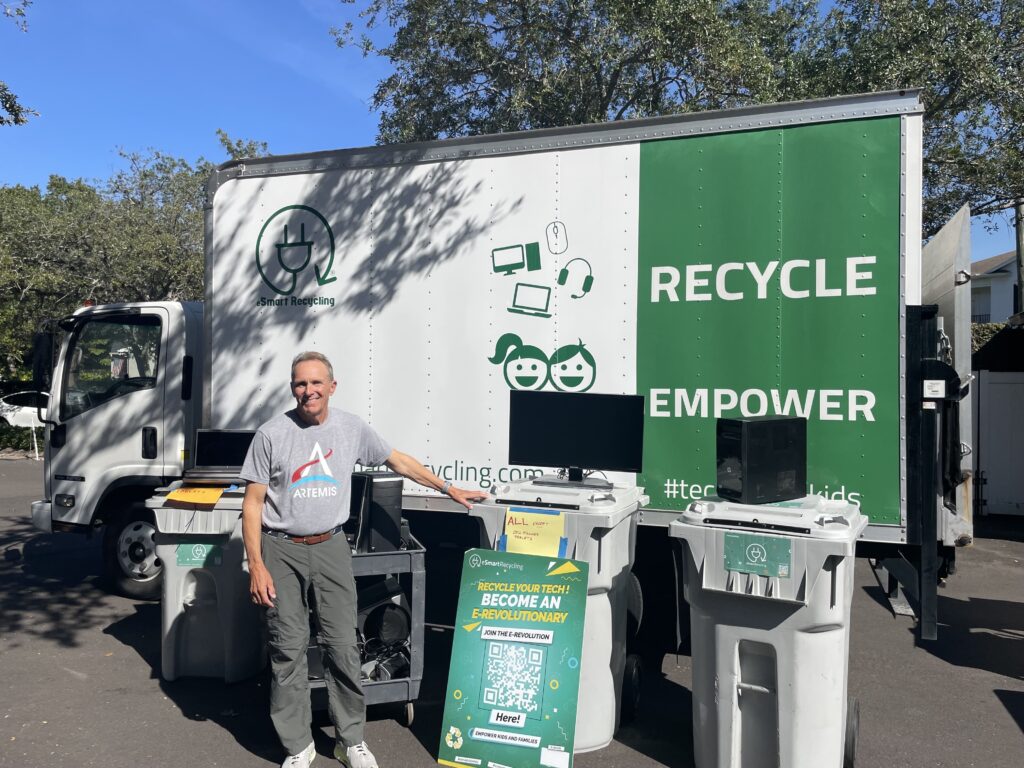
Collection and Commitment
Upon receiving the electronic devices collected by Palma Ceia Presbyterian Church, we at eSmart Recycling pledge to recycle each laptop with the care and excellence that define our work. This laptop recycling process not only benefits the environment but also opens a world of possibilities for students and educators.
The Transformation Process
Each laptop that arrives at eSmart Recycling is meticulously evaluated and remanufactured. Our team of “eSmart Techies” specializes in recycling and renewing these devices to ensure that each recycled laptop meets the highest standards before being handed over to the Hillsborough Education Foundation. Some, unfortunately, do not meet the minimum requirements and end up being recycled at the highest environmental standards.
The ‘Refurbished Laptops’: Beyond Renovation
At eSmart Recycling, recycling laptops is a way to empower the next generation. Each remanufactured laptop is a gateway to new skills and knowledge for the students who receive them.
The Educational Impact
Recycling laptops takes on a new dimension at eSmart Recycling: it becomes a mission to bridge the digital divide. By delivering remanufactured laptops to the Hillsborough Education Foundation, we ensure that more students can access the necessary technology for their education and training necessary to bridge the digital literacy divide.
Inspiration for the Future
The recycling initiative by Palma Ceia Presbyterian Church is just the beginning. At eSmart Recycling, we strive to recycle laptops and turn them into valuable educational tools, encouraging other communities to join us in this vital effort.
Laptop recycling is an ongoing task at eSmart Recycling, and we look forward to announcing soon how many remanufactured devices will be delivered to the Hillsborough Education Foundation.
Recycling laptops with eSmart Recycling means building a more sustainable and educational future. We are grateful for the initiative of Palma Ceia Presbyterian Church and for the opportunity to continue making a positive impact in the community through technology.
December 26, 2023
It’s that time of year when homes are filled with exciting last-minute Christmas gifts, but what do you do with the electronics you’re about to replace? From phones to music players or tablets, it’s important to properly dispose of your electronic gadgets when upgrading or replacing them.
Knowledge of local recycling facilities will help you make informed decisions when disposing of old electronic devices. Whether you’re disposing of recently replaced items or gadgets that have been sitting in a closet for too long, these tips for recycling post-Christmas electronics will surely be helpful.
Discover recycling options: understanding local regulations
The most crucial first step is to investigate local regulations. Check local websites and contact the local government to learn the best ways to dispose of your electronics. Most cities have electronic drop-off sites that are not suitable for household recycling. Not all cities accept electronic devices, and this often depends on the type of electronics. Remember, different areas have different safety and environmental regulations that could affect the disposal process.
Giving electronics to non-profits
If you find that your old electronics are still functional, check with your local Armed Forces to see if they participate in the Cellphones For Soldiers program. This program ensures that our soldiers overseas stay connected with their loved ones back home. If you’re interested in donating mobile phones, tablets, gaming systems, and other electronic devices, check if your local post office participates.
Even if your gadget is not working, certain non-profit organizations accept broken electronics for reuse and repair.
Data security matters: factory resets are not enough
When getting rid of phones, TVs, tablets, and computers, remember that wiping the device does not delete all the personal information that may be stored on the hard drive. Most people believe that a factory reset will do the job, but unfortunately, it’s not enough.
Private information such as messages, photos, videos, phone numbers, payment information, and even GPS data can still be recovered from your device. It’s advisable to perform a factory reset before disposing of the device, but keep in mind that it won’t delete everything.
Make it easy: professional electronic disposal services
Recycling electronic devices after Christmas may seem difficult, but you don’t have to do it alone. Professional disposal companies are a great option for those who lack the time or knowledge to properly dispose of electronics. eSmart Recycling is one of the country’s leading electronic disposal companies, and we accept all kinds of electronic devices, from tablets to mobile phones or desktop computers.
Our process is simple and secure: all we need from you is the device you want to dispose of, the battery, and any peripherals and accessories it may include. From there, we eliminate the electronics to ensure all your data is deleted, and then recycle the device to prevent environmental damage.
Recycling electronic devices after Christmas can be complicated, but use these tips to get started. Research local recycling regulations, consider donating your electronic devices to the Armed Forces, read the guidelines of electronic waste centers if local drop-offs are available, remember that factory resets do not delete all private information, and if you need more help, call an electronic disposal company.
Remember, at eSmartRecycling, we accept all kinds of electronic devices. Visit us for more information.
July 23, 2024
More and more companies are starting to implement electronic device recycling programs to reduce their environmental impact and meet their sustainability goals. However, getting employees to participate in e-recycling programs can be quite challenging. In this article, we’ll discuss some strategies to increase employee participation in electronic recycling programs within companies.
Inform employees about the benefits of electronic recycling
The first step to increasing employee participation in e-recycling programs is ensuring that all employees understand the benefits of recycling electronic devices. Recycling is not only good for the environment, but it can also help companies save money, reduce their carbon footprint, and create a positive image for the company. Make sure to explain these benefits in detail to educate employees about the importance of electronic recycling.
Address common concerns about electronic recycling
Many employees may have concerns about electronic recycling, such as data security and understanding what can and cannot be recycled. Companies need to address these concerns and provide employees with the information they need to feel comfortable participating in the program. For example, companies can create a data security policy, inform employees about the types of devices that can be recycled, and provide electronic recycling bins in common work areas to make participation even easier for employees.
Introduce incentives for electronic recycling
Another way to encourage employee participation in e-recycling programs is to introduce incentives. Incentives can take many different forms, such as discounts on company services or products, time off, or recognition and rewards. These incentives can help employees feel that they are making a difference and can also foster a bit of friendly competition in the office.
Implement a company-wide policy on electronic recycling
The most important step to increasing employee participation in e-recycling programs is to implement a company-wide policy that makes electronic recycling mandatory. This policy can include specific instructions on recycling devices, such as where and how they should be recycled, as well as which types of devices are allowed. Providing clear instructions can help ensure that all employees understand what is expected of them and are more likely to participate.
Implementing an e-recycling program in the company and increasing employee participation can be a challenging task. However, by educating employees about the benefits of e-recycling, addressing common concerns, introducing incentives, and applying a company-wide policy, companies can take steps to ensure their e-recycling program is a success. By making electronic recycling fun and easy for employees, companies can help create a more sustainable work environment and encourage employees to do their part to help protect the environment.
March 7, 2024
At eSmart Recycling, we firmly believe that technology is more than just tools; it is a bridge to opportunities, education, and a brighter future. Our mission focuses on bridging the digital divide by donating essential technological equipment to those who need it most. This commitment extends beyond borders, reaching communities in vulnerable situations where the need is greater but resources are fewer.
Recently, we have had the opportunity to expand our impact on Peru, collaborating with institutions that make a real difference in people’s lives. The Ronald McDonald House and Corazones Felices are the latest beneficiaries of our donation initiative, receiving 30 remanufactured computers that will benefit children, teenagers, and their families. These families face significant challenges, from complex medical treatments to conditions of poverty and extreme poverty.
Stories of transformation and hope
The donated technology will be used for educational and communication purposes, allowing these young people to continue with their studies and maintain contact with their loved ones during difficult times. Corazones Felices has inaugurated a new technology laboratory where about 70 children and adolescents can improve their digital skills, an invaluable resource in today’s world. Meanwhile, the Ronald McDonald House has incorporated these technological tools to support children’s education and emotional well-being while receiving treatment.
Tony Selvaggio, CEO of eSmart Recycling, emphasizes the crucial role of our allies and the importance of a sustainable approach in our work. Each donated device represents a story of collaboration, sustainability, and new life. This philosophy benefits the environment by extending the lifespan of technology and paves paths of hope and progress for more than 12 thousand people in various countries.
The impact of collaboration
Donating to the “Casa Ronald McDonald” and “Corazones Felices” underscores the importance of cooperation between organizations to maximize social impact. These collaborations allow remanufactured technology to reach hands that genuinely need it, changing lives and shaping futures. In an increasingly digital world, ensuring that young people have access to technology is fundamental to leveling the playing field and offering everyone the same opportunities for growth and learning.
Join our mission
We invite businesses, individuals, and communities to join us on this transformative journey. Whether through equipment donations, volunteer support, or financial contributions, every small act adds up to a big change. Collaborating with eSmart Recycling contributes to a more inclusive, educational, and sustainable future.
With each donation, each recycled device, and each life we touch, we move closer to a world where technology serves as a bridge to unlimited opportunities. We are proud of our achievements and excited about what is to come. We thank all our partners and donors who make this impact possible and invite more people to join our cause.
Together, we can make a difference. Together, we can build a future where every child, boy, and girl has the necessary tools to succeed in this connected world. Your support can light the way to a brighter tomorrow for everyone.
February 16, 2024
On February 16th, eSmart Recycling and Digital Inclusion achieved a significant milestone in our commitment to digitalization and education. We were thrilled to deliver 22 computers to the Infinite Potential Learning Academy (IPLA) in Saint Petersburg, Florida. This initiative represents a collaborative achievement and reaffirms our dedication to promoting equitable access to education and technological resources through eSmart Recycling and the eSmart Way™.
The inauguration: A gathering of visionaries
The inauguration of the IPLA computer classroom was a momentous event that brought together community leaders, Digital Inclusion partners, the eSmart Recycling team, and the dedicated IPLA faculty. The atmosphere was filled with tangible optimism, reflecting the hope and potential these technological means will deliver to students with eSmart Recycling.
A window to infinite opportunities
The new lab is more than just a physical space equipped with technology; it’s a symbol of doors opening to a future brimming with possibilities. With 22 computers, this environment is designed to be an epicenter of discovery and learning. Technology has become a fundamental pillar of education, preparing students for the challenges of a digital future.

The power of collaboration
This achievement is a clear example of the power of collaboration among different entities and organizations. The synergy between the more than 50 organizations that work under the Digital Inclusion program, including Community Tech House, and other collaborators, demonstrates that the impact can be monumental when we join forces. We are breaking down barriers and building a more inclusive and equitable future.
Our ongoing commitment at eSmart Recycling
The inaugural event may have come to an end, but our dedication to the cause of environmental sustainability and digital inclusion continues. At eSmart Recycling, we commit to empowering communities through technology and continue to seek new ways to bridge the digital divide.

Gratitude and hope for the future
We sincerely thank the entire Digital Inclusion team, the IPLA staff, and all participants for making this event successful. Together, we have demonstrated the transformative power of technology to renew education and create opportunities.
Looking forward, we remain hopeful and determined, knowing that each equipment donation, every open learning space, and each empowered student brings us one step closer to a future where technology is accessible to all. Narrowing the digital divide is an ongoing goal, and we are committed to moving forward together on this journey, day by day, toward a more promising and equitable tomorrow.
October 6, 2023
Technology has seamlessly integrated into our daily lives, reshaping various facets of society. One significant realm witnessing this transformation is the evolution of smart cities. These futuristic urban centers are built on sustainability and powered by cutting-edge technology. In this piece, we delve into the smart city revolution and how sustainability and technology are converging to shape the cities of tomorrow.
The Essence of Smart Cities
Smart cities aren’t just a concept; they’re a reality that’s slowly but surely shaping our future. These cities employ advanced technology and data-driven solutions to enhance the quality of life for their inhabitants while simultaneously reducing their environmental footprint. At the heart of smart cities is the vision to establish sustainable, efficient, and livable urban spaces.
Technology and Sustainability
Technology plays a pivotal role in making cities smarter and more sustainable. It helps optimize infrastructures, manage resources, and deliver efficient services. With devices and sensors from the Internet of Things (IoT), data is collected from myriad sources, offering real-time insights for decision-making and the enhancement of urban services.
Companies like Cisco Systems and Siemens are at the forefront of smart city tech innovation. Cisco’s Smart Connected digital platform enables city-wide connectivity and efficient infrastructure management. On the other hand, Siemens provides solutions for energy-efficient buildings and intelligent transportation systems. These companies are pioneering the technology and infrastructure essential for smart cities to flourish.
Sustainability in Smart Cities
Sustainability is a cornerstone in designing and implementing smart cities. By harnessing technology, these cities champion eco-friendly practices and decrease their carbon footprint. This contributes to a healthier environment and an improved quality of life for residents.
Renewable Energy
A primary pillar of sustainability in smart cities is the utilization of renewable energy sources. Solar panels, wind turbines, and other renewable energy technologies are integrated into urban infrastructure to power buildings and facilities. This reduces dependence on fossil fuels and curtails the environmental impact associated with energy consumption.
Leading the charge in renewable energy deployment is Tesla. With its solar shingles and Powerwall battery systems, Tesla allows homeowners and businesses to leverage solar power for their energy needs. This not only lowers electricity costs but also promotes a cleaner, sustainable energy grid.
Efficient Waste Management
Smart cities also prioritize efficient waste management systems to reduce landfill waste and promote recycling. Sensor-equipped waste bins monitor fill levels, optimizing collection routes and reducing unnecessary pickups. Moreover, automated waste sorting systems segregate recyclables, ensuring valuable resources don’t end up in landfills.
A notable player in this arena is BigBelly Solar. Their smart waste and recycling stations use solar-powered compactors, reducing garbage collection frequency. By compacting waste, these stations hold up to five times more trash than conventional bins, reducing collection vehicle emissions and bolstering sustainability.
Benefits of Smart Cities
Merging sustainability and technology in smart cities brings myriad benefits to both residents and the environment.
Enhanced Quality of Life
Smart cities prioritize their residents’ well-being by offering efficient transportation systems, smart buildings, and improved public services. Intelligent traffic management reduces congestion, saving time and easing commuter stress. Smart buildings with automated systems and energy-efficient technologies create comfortable, sustainable living spaces. These advancements uplift the overall quality of life for city dwellers.
Resource Management
Smart cities maximize resource usage through automation and data-driven insights. Real-time monitoring of water and energy usage identifies inefficiencies, promoting conservation. This not only curtails costs but also ensures sustainable usage of scarce resources.
Environmental Sustainability
By adopting renewable energy sources and efficient waste management, smart cities significantly reduce their carbon footprint. Transitioning to greener, cleaner technologies supports environmental sustainability by mitigating urbanization’s adverse effects on the planet.
The Future of Urban Living
The smart city revolution is just the beginning, and with advancing technology, the potential for sustainable urban development is boundless. From autonomous vehicles and smart grids to artificial intelligence and blockchain, the future of smart cities holds immense promise.
As we embrace this revolution, it’s vital to prioritize inclusion, privacy, and security to ensure the benefits of smart cities are accessible to all. Collaboration between urban planners, tech companies, and citizens is paramount to forge truly sustainable, livable urban spaces.
The smart city revolution is a paradigm shift in urban development, blending sustainability with technology. With the support of pioneering companies like Cisco Systems, Siemens, Tesla, and BigBelly Solar, cities worldwide are adopting these concepts to craft a brighter future for their residents and the globe. As smart cities continue to evolve and expand, they pave the way toward a more sustainable, interconnected world. Let’s embrace this revolution and work together to make our cities smarter and greener.
August 31, 2023
In today’s fast-paced business world, corporate social responsibility (CSR) has emerged as a key factor determining the success and reputation of organizations. Through CSR, companies actively contribute to the well-being of their employees, communities, and the environment. This article explores the significance of CSR and highlights the positive impact it can have on society while emphasizing the role of eSmart Recycling in promoting environmentally-friendly practices.
What is corporate social responsibility?
Corporate Social Responsibility, commonly known as CSR, refers to the ethical and responsible behavior of businesses toward society. It goes beyond economic objectives and focuses on making a positive impact on multiple stakeholders, including employees, customers, communities, and the environment. Companies that embrace CSR integrate social, environmental, and economic considerations into their decision-making processes and core business operations.
The benefits of corporate social responsibility
Adopting CSR initiatives offers numerous benefits to organizations. Firstly, it enhances their reputation and brand image, as socially responsible companies are seen as trustworthy and ethical. This improves customer loyalty and attracts socially conscious consumers who prioritize sustainable and ethical practices.
Secondly, CSR serves as a powerful tool for employee engagement and satisfaction. When employees perceive that their organization is genuinely committed to social causes, they feel motivated and proud to be a part of it. This leads to increased employee productivity, lower turnover rates, and a positive work environment.
Thirdly, CSR contributes to the development and betterment of the communities in which organizations operate. By investing in social projects, educational initiatives, and healthcare programs, companies can help uplift the lives of individuals, promote gender equality, and reduce poverty.
Lastly, embracing CSR practices can have a positive impact on the environment. By implementing sustainable practices, reducing carbon footprints, and promoting recycling, organizations can contribute to the preservation of natural resources and combat climate change.
eSmart Recycling: an advocate of corporate social responsibility
eSmart Recycling, a leader in the electronic waste recycling industry, is a prime example of a company committed to corporate social responsibility. With a vision to create a sustainable and greener future, eSmart Recycling offers comprehensive e-waste management solutions while adhering to ethical and environmental standards.
Through partnerships with businesses and communities, eSmart Recycling ensures that electronic waste is disposed of responsibly and safely. Their state-of-the-art facilities prioritize recycling and the proper disposal of harmful components, reducing the environmental impact of electronic waste.
eSmart Recycling’s commitment to CSR is further demonstrated through its participation in community engagement initiatives. By organizing education and awareness programs, they empower individuals and businesses to make responsible choices regarding e-waste management. This proactive approach not only helps protect the environment but also creates a positive social impact.
Corporate Social Responsibility is not just a buzzword; it is an essential component of a successful and socially conscious organization. By incorporating CSR practices into their core operations, companies can reap numerous benefits while contributing to society and the environment.
eSmart Recycling serves as a shining example of a company that integrates CSR principles into its operations. By responsibly managing electronic waste and actively working towards creating a sustainable future, they showcase the positive impact that organizations can have on society.
In a world where sustainability and ethical practices are of utmost importance, embracing CSR should become a priority for businesses. By doing so, companies can differentiate themselves, enhance their reputation, and foster long-term success – all while making a difference in the world.
February 1, 2024
Nowadays, in times of social and political upheaval, corporate social responsibility (CSR) is more crucial than ever. This idea is making waves in the business world, with companies, both large and small, feeling the pressure to be socially responsible. With the rising expectation that C-level executives, such as the Chief Information Security Officer (CISO), play a leading role in implementing and managing CSR initiatives, the role of CISOs is evolving significantly.
This article delves into the role of the CISO in corporate social responsibility, detailing the duties and responsibilities of CISOs concerning CSR. It will identify common NIST security measures and initiatives that all CISOs should be familiar with. Additionally, the potential benefits of implementing CSR in a company, as well as possible challenges to overcome, will be discussed.
Social and environmental responsibility in the business world
A core idea underlying corporate social responsibility is that companies should strive to operate in a way that is beneficial for society and the environment where they conduct their activities. This involves taking steps to reduce waste mitigate environmental impacts, and develop ethical business practices. Companies that adhere to CSR are often seen as more credible and trustworthy, as they are perceived to show a genuine interest in operating ethically and morally.
With this in mind, many companies are beginning to focus on developing CSR initiatives, and there is a heightened expectation for C-level executives, particularly CISOs, to play a leading role in launching and managing these initiatives. CISOs are uniquely positioned to take on this role, as they are responsible for securing the company’s sensitive data and infrastructure.
The role of the CISO in corporate social responsibility
When it comes to corporate social responsibility, the role of the CISO is very similar to their role in other security aspects: identifying and managing an organization’s risks, ensuring compliance with applicable policies and standards, and providing guidance and direction to their teams. To do this effectively, a CISO needs a broad range of technical knowledge and a thorough understanding of business operations and the potential impacts posed by security measures.
CISOs are often tasked with ensuring that their company has robust risk management practices, and it’s crucial to adopt a proactive approach to identifying and managing any potential risks. They frequently apply best security practices and seek and resolve known vulnerabilities in cyberspace. Additionally, they review the company’s policies and procedures to ensure they protect both sensitive data and customer information. All these practices can be used to help establish, maintain, and ensure compliance with CSR initiatives.
NIST and corporate social responsibility
CISOs need to be familiar with the National Institute of Standards and Technology’s cybersecurity framework, as this framework guides establishing and improving cybersecurity in almost any company. The NIST framework offers a holistic approach to risk management and can be used to help companies identify potential vulnerabilities and mitigate cyber-attacks. The NIST framework also provides specific guidance on addressing the implications of technologies and the development of digital infrastructures on the environment.
Benefits of corporate social responsibility
Implementing and maintaining CSR initiatives can offer organizations a wide range of benefits. These include improved public relations and reputation, reduced risks and vulnerabilities, increased employee engagement and retention, and enhanced financial performance. The nature of these benefits can be especially important when considering the perspective of the CISO, as much of the responsibility will fall on them to provide the guidance, leadership, and technical support needed to ensure that CSR initiatives are applied effectively and efficiently.
It should also be noted that companies adopting CSR initiatives will be more attractive to potential employees. Younger professionals, in particular, are drawn to companies that align with their values and are considered more appealing to work for.
Overcoming potential obstacles in implementing CSR
Of course, there will always be obstacles to overcome when implementing any new initiative in a company. Regarding CSR, the main challenges revolve around the time, cost, and resources required to implement the required changes. As a result, CISOs need to secure the buy-in of senior management before committing to any CSR initiative. It’s also crucial to take the necessary time to explore any potential risks, costs, and benefits before embarking on an implementation.
The role of the CISO in corporate social responsibility is evolving significantly, and it’s important for CISOs to familiarize themselves with best practices and means to implement CSR. The NIST framework provides a solid foundation for addressing the security implications of CSR initiatives and adopting a proactive approach to identifying vulnerabilities and establishing compliance will be the primary responsibility. Given the increasing level of demand for CISOs to play a leading role in achieving corporate social and environmental responsibility, the importance of the CISO’s role in this area will continue to grow over time.
June 8, 2024
Electronic waste is a challenge the world must face head-on, and social media plays a crucial role in educating consumers and encouraging them to recycle old devices. The enormous amounts of electronic devices discarded yearly pose a significant threat to human health and the environment. Companies and communities must find new ways to promote recycling to mitigate this risk.
Social media is a powerful tool to help improve recycling behaviors and easily change consumer mindsets.
Recycling electronic devices is not only best for the environment but also necessary to prevent excessive amounts of toxic chemicals from reaching waterways, air, and soil. It’s more complex than recycling bottles or plastics.
Electronic devices can take hours to break down, and most people don’t know how to dispose of them properly. Social media can educate people on recycling electronic devices, connect them with recycling programs, and help change consumer behaviors.
What are people saying about recycling electronic devices on social media?
People are discussing electronic device recycling on social media, and the reaction is mostly negative. Many consumers feel inconvenienced by current recycling programs, while others mistakenly believe that recycling electronic devices is too difficult. People want to get involved in recycling electronic devices; they must fully understand what recycling entails. Social media can provide information resources and show consumers where to recycle their electronic devices.
Individuals, companies, and organizations are using various social media platforms to discuss their efforts to encourage the recycling of electronic devices. Users on these platforms discuss recycling from a personal perspective and the broader issue of electronic waste. Topics include whether it’s worth recycling your old device or computer to switch to more sustainable electronics and discussions about the negative impact of electronic waste on the environment.
How can companies use social media to promote electronic device recycling?
Companies interested in promoting electronic device recycling can use social media to raise awareness and educate potential consumers. They can start using social media platforms to show people how easy it is to recycle electronic devices and share data and facts about electronic waste. Companies might also consider using social media advertising to reach people on a larger scale.
Social media platforms like Facebook, Instagram, and YouTube can be used to post images and videos that educate potential consumers about electronic waste and the positive impact of recycling. These images and videos can also demonstrate how electronic devices can be recycled and help promote recycling facilities in Canada. For example, Best Buy, whose recycling program aims to reduce electronic waste, uses social media to educate consumers and promote its convenience program.
What Is the impact of social media on electronic product recycling behaviors?
Research shows that social media does indeed have a positive impact on people’s recycling behaviors. Many people say that social media has made them more aware of the number of discarded electronic devices, and they are now more likely to take action to reduce their environmental impact. Additionally, many companies have started to improve their recycling programs after being reminded of the impact of their waste on the environment through social media campaigns.
Social media is a powerful tool for educating consumers on environmental issues, the positive effects of recycling, and what they can do to help care for the environment. Companies and organizations must use social media to promote recycling, improve consumer behaviors, and facilitate electronic waste recycling programs.
Electronic device recycling is an important issue that needs to be addressed. Social media can be leveraged to connect people with recycling programs, educate them on the importance of electronic waste recycling, and help change consumer behaviors. All companies and organizations can use social media advertising to raise awareness about electronic device recycling and its positive environmental impact. Social media is a powerful tool that can help promote electronic device recycling and create a positive impact.
February 16, 2024
Obsolete devices pose a significant threat to business security. With the increasing need for automation, the equipment many businesses use is becoming outdated. The role of predictive cybersecurity in managing old equipment is more important than ever.
In this article, we’ll discuss the main reasons for equipment obsolescence, the growing importance of predictive cybersecurity, the advantages of considering effective device security strategies, and some ways to benefit from digital security technology. By considering these factors, you can ensure that your organization is prepared to face the challenges posed by obsolete equipment.
Main reasons for equipment obsolescence
The primary reason for equipment obsolescence is the rapid evolution of technology. Manufacturing companies are constantly innovating to produce faster, more efficient, and reliable products. As a result, these older devices quickly become obsolete. Obsolescence can also occur in individual devices if repair becomes increasingly difficult, the supply of necessary replacement parts becomes scarce, or the devices can no longer connect to more modern systems.
The growing importance of predictive cybersecurity
With the increasing prevalence of vulnerable devices, predictive cybersecurity has become a vital tool for preventing unauthorized data access and other security threats. Predictive cybersecurity relies on machine learning techniques to continuously analyze network traffic and device behavior. This allows the cybersecurity system to anticipate potential security vulnerabilities and alert system administrators before they become significant problems. Predictive models can also detect if a device has been compromised by a cyberattack and quarantine it from the rest of the network.
The advantages of considering effective device security strategies
By incorporating predictive cybersecurity into your device management strategy, your company can benefit from enhanced device security. Predictive security reduces the risk of data breaches by quickly identifying and mitigating security threats. Predictive models can also indicate which devices are most likely to become obsolete, allowing your company to budget for replacement costs.
Effective device security strategies can also improve network performance by prioritizing device traffic and redirecting data to more efficient devices. Additionally, predictive cybersecurity can help your company assess current device policies and update policies as obsolete devices are retired.
Benefiting from digital security technology
The latest advancements in digital security technology have allowed companies to further enhance their security. With the advent of software-defined security strategies, companies can now maintain a single view of their security profile and policies across all devices on their network. Software-defined security also allows for quick response to security threats and the detection and blocking of potentially harmful network traffic.
Furthermore, companies can now automate the deployment of security patches and updates with software-defined security. This makes it easier to keep devices up-to-date and secure. Cloud security platforms can also help companies scan devices for vulnerabilities and respond quickly to cybersecurity threats.
The rapid evolution of technology has made it increasingly important for companies to consider the effects of obsolete equipment on their network security. Predictive cybersecurity can help your company anticipate and mitigate the risks associated with obsolete devices. Additionally, advanced digital security technology can further improve your company’s security profile by providing automated security management, threat detection and response, and vulnerability scanning. By following these strategies, your company can minimize the security risks of obsolete equipment.
April 10, 2024
Electronic recycling is vital for the environment’s health, and the employees working in the sector play a critical role in its success. Employees are the backbone of any electronic recycling operation, and their knowledge, skills, and dedication are essential for ensuring that recycling activities run smoothly and effectively. In this article, we will explore the role of employees in electronic product recycling and discuss why their work is so important.
What is electronic recycling, and why is it important?
Electronic recycling involves collecting and dismantling used electronic devices, such as computers, mobile phones, and televisions, and reusing or recycling the materials to create new products. This is important because electronic devices contain various materials and chemicals that can be hazardous to the environment if not correctly disposed of. Additionally, recycling electronic devices helps conserve natural resources and reduce the environmental impact of manufacturing new devices.
The roles of employees in electronic device recycling
Employees working in an electronic device recycling facility perform several important roles. They are responsible for overseeing the various steps of the recycling process, from collecting used devices to checking and sorting them before dismantling. Employees must adhere to strict health and safety standards when handling electronic devices and comply with all local and federal regulations governing electronic waste disposal.
In addition to these tasks, employees at an electronic device recycling facility must also be familiar with the types of devices they handle and the materials they contain. They must be able to identify which materials are recyclable and which are not, and they must be well-versed in the latest recycling technologies to ensure that electronic devices are recycled in the most environmentally friendly way possible.
The importance of employee collaboration
Beyond their tasks, employees at an electronic device recycling facility must also collaborate to ensure that recycling activities are carried out smoothly and effectively. For example, an employee working on dismantling an electronic device must be able to quickly and efficiently pass the various components to other employees responsible for sorting and recycling materials. Furthermore, employees at a recycling facility must be able to communicate with their peers to quickly and accurately identify any problems that may arise during the recycling process and devise a solution.
Benefits of employee training and education
Employee training and education are also essential for the success of an electronic product recycling facility. Employees must be up-to-date on the latest recycling technologies and best practices and receive training to comply with the strict health and safety standards governing the recycling industry. Additionally, employees need to receive regular training on correctly identifying and classifying the different materials found in electronic devices to ensure that recycling activities are conducted in the most effective and environmentally friendly manner.
Responsibility of brands and manufacturers
Electronic device manufacturers and brands are also responsible for ensuring that their products are disposed of responsibly at the end of their life cycle. Therefore, many electronics companies have begun participating in electronic waste recycling programs that allow consumers to dispose of their electronic devices easily and responsibly. Employees at an electronic device recycling facility must also be able to handle these devices and ensure that the materials are recycled in the most environmentally friendly way possible.
Employees working in an electronic device recycling facility play a crucial role in the operation’s success. These employees are responsible for overseeing the various steps of the recycling process, from collecting used devices to checking and sorting them before dismantling. In addition to their roles, employees at an electronic product recycling facility must also be able to work together to ensure that recycling activities are carried out smoothly and effectively. The training and education of employees are also important for the success of an electronic product recycling facility, and manufacturers and brands are responsible for ensuring that their products are disposed of responsibly. Working together, employees, manufacturers, and brands can help make the electronic product recycling process more effective and reduce its environmental impact.
April 25, 2024
The swift pace of technological advancements has caused a radical change in how we live, work, and connect. This has helped bring the concept of smart cities to life: cities that leverage technology to enhance the quality of life for their citizens. E-recycling plays a crucial role in the construction of smart cities.
E-recycling is a method for reusing electronic waste, which typically consists of old, obsolete, or unused electrical or electronic components, such as computers, mobile phones, and batteries. Recycling ensures that electronic waste does not end up in landfills or incinerated, causing environmental damage. Instead, the parts from this electronic waste are reused, refurbished, or matched with other electronic parts to create updated equipment, reducing the total cost of production and conserving valuable resources.
The environmental and economic impact of electronic recycling
Electronic recycling benefits not only the environment but also has tangible economic advantages. Approximately 4.3 million tons of electronic waste are generated annually in the United States alone. Recycling all these electronic wastes recovers an estimated 16.8 billion dollars of raw materials. This material can be reused instead of manufactured anew, conserving resources and saving money. Additionally, electronic recycling saves energy: the same process can save up to 92 billion kilowatt-hours of electricity and prevent 181 billion pounds of CO2 greenhouse gas emissions.
Electronic recycling and smart cities
For a city to be wise, it must be capable of controlling, managing, and efficiently using its physical infrastructure, such as roads, power networks, and buildings. Electronics play a significant role in achieving this goal, as it is the primary component of the digital infrastructure that underpins smart cities. An effective way of managing electronic waste is necessary for cities to adopt important technologies like smart meters, connected vehicles, and energy management systems. Only by maintaining proper electronic product recycling procedures can a city ensure that the electronic waste generated by these new technologies is disposed of properly, ensuring a healthy environment for the overall health of its citizens.
Developing e-recycling solutions for smart cities
The good news is that many companies and local governments are already aware of the advantages of e-recycling and are starting to take steps to ensure the proper disposal of electronic waste. Electronic recycling companies like Apple, Best Buy, and Dell offer the best systems and services for electronic waste recycling in the U.S. On a local level, several communities have also launched waste collection, recycling, and reuse services and are conducting public awareness campaigns to boost these programs’ adoption further.
Furthermore, many cities are launching large infrastructure projects that apply sustainable practices. For example, tech giants like IBM are developing software programs for smart cities to manage water, electricity, and other municipal services optimally with minimal waste.
This trend demonstrates that electronic recycling goes beyond individual companies and communities and is becoming an increasingly significant part of creating smart and sustainable urban living environments.
Electronic recycling is necessary for building smart cities. It has significant tangible economic benefits by conserving resources and saving energy. Furthermore, e-recycling is an essential part of the infrastructure for initiating and maintaining smart city practices, leading to a better future for urban citizens. Therefore, a critical area of focus for both companies and local governments should be developing e-recycling solutions that practice environmental management and pave the way toward an era of modern and sustainable infrastructures.
May 24, 2024
Electronic recycling is a crucial practice in today’s society to help minimize the waste of old and obsolete electronic devices. Electronic waste poses a risk to the environment and human health, and artificial intelligence is a modern approach to facilitating and making electronic appliance recycling more effective. In this article, we will discuss advances in electronic recycling technology and the role of artificial intelligence in its optimization.
The emergence of artificial intelligence (AI) has represented significant progress in various aspects of technology. AI uses machine learning algorithms to advance intelligent systems and automate tasks previously done manually. This can be achieved by analyzing large amounts of data and identifying patterns to predict future outcomes.
Why is electronic recycling necessary?
Today’s consumer electronic devices suffer from obsolescence. This means that devices become obsolete and unnecessary as new technology develops. As a result, a large amount of electronic waste is produced daily. When disposed of improperly, electronic devices can release harmful chemicals and heavy metals that can contaminate the environment and pose a risk to human health.
How does artificial intelligence help improve electronic appliance recycling?
Artificial intelligence can automate and optimize various tasks in the electronic appliance recycling process. One of the main applications of AI in electronic recycling is the identification and segregation of electronic waste. Machine learning algorithms can recognize various types of electronic devices, their components, and the presence of hazardous materials.
Another use of artificial intelligence is optimizing the input and output of an electronic recycling system. AI can analyze data and predict the best methods for devising recycling processes. This can help minimize energy consumption, reduce costs, and improve efficiency.
Advances in electronic recycling technology
Various advances in electronic recycling technology can be achieved thanks to artificial intelligence. One of the most prominent technologies in modern electronic recycling is a robotic system that uses machine learning algorithms to identify, dismantle, and separate the components of electronic devices. This can lead to a more effective and accurate recycling process.
AI can also be used to monitor and control the performance of a recycling system. Sensor technologies can monitor energy consumption and system performance, and AI algorithms can analyze this data and make improvement recommendations. This can help ensure the recycling process is as effective as possible and complies with all regulations and standards.
Artificial intelligence in electronic recycling is revolutionizing our way of viewing this practice. Electronic recycling is necessary to reduce waste and prevent harmful pollutants from reaching the environment. AI can make the recycling process more effective, precise, and cost-effective. Various technological advances are currently being used to make the most of the practice of electronic recycling, and AI is proving to be essential in this optimization process.
May 16, 2024
Climate change, environmental pollution, and the depletion of natural resources are just a few reasons why today’s companies prioritize environmental protection. Indeed, recycling is an eco-friendly way to reduce waste and pollution and save money. Great. But how do you get your team as motivated as you are to recycle and make it a routine? In this blog post, we’ll look at the psychology behind recycling and how you can use it to motivate your team to recycle more.
Background
In today’s society, people are increasingly aware of the importance of environmental conservation. Consumption and disposal behaviors have changed; now, more than ever, many people are taking steps to reduce waste and live more sustainably. This is also partly due to recycling and waste management legislation, which is commonplace in most areas.
However, more than traditional recycling programs may be needed to encourage people to recycle. Although the concept of recycling has been around for a long time, convincing team members to recycle their waste correctly and routinely remains a struggle for many companies. That’s why it’s crucial to understand the psychology behind recycling and how to leverage it to motivate your team.
Why recycle?
The benefits of recycling go beyond the environment. Recycling can positively impact your bottom line, reducing waste disposal costs and decreasing energy and material use through sourcing reprocessed products. Additionally, recycling can have further positive effects on the company, such as improving customer relations, reducing potential liability issues, and supporting surrounding local communities.
The psychology of recycling
Companies must first understand the psychology behind recycling to motivate employees to recycle successfully. The ultimate goal is to change individual behaviors, and since recycling adds a step to waste disposal and thus adds a level of inconvenience, companies must be able to change their employees’ perspectives on waste disposal.
The psychology of recycling can be divided into three main parts:
Collection
People are much more likely to recycle if the collection process is easy to manage. Simple and clear instructions allow for a smooth and hassle-free process. Using specific containers for specific types of waste can help streamline the sorting process. Time and effort are also key considerations in the collection process. If the recycling process seems slow and difficult, citizens will want to avoid recycling.
Convenience
Recycling programs will only be successful if they are convenient. This means that recycling programs must match the individual’s lifestyle. People are more likely to recycle if bins are placed near waste sources. For example, in an office, bins should be placed near desks and throughout the building.
Incentive
While financial compensation can be an effective method to encourage people to recycle in some cases, research suggests that non-monetary incentives usually work best. Making employees aware of their recycling efforts’ positive effects on the environment and neighboring communities can be a significant motivator. Companies can also employ strategies to create a competition to see which department can recycle the most items as an additional incentive.
Tips for Encouraging Team Members to Recycle More
Motivating your team to recycle can be challenging. However, understanding the psychology behind recycling can be incredibly helpful. Here are some tips to help your company make recycling something your team is as passionate about as you are.
Start a conversation:
Before starting your recycling program, talk to your team about the benefits. Start a small recycling initiative and measure the results over some time.
Find a hero:
Find someone within the team who is incredibly passionate about recycling and sustainability. Leverage this person to lead by example.
Make it a habit:
Try to make recycling a natural part of the team’s day. For example, you can place the recycling bin near the coffee machine or water fountain.
Reward them:
Use non-monetary rewards to encourage your team to recycle more. Look for ways to celebrate the achievements of those who recycle the most, such as a team lunch or an office party.
Recycling is an integral part of modern business operations. Motivating a team to recycle more can be a challenge. However, understanding the psychology behind recycling and applying the right strategies can help companies effectively create a sustainable recycling program. Remember, before motivating your team to change behavior, you must first hold conversations with them and provide them with the necessary tools so they can easily recycle waste. By doing so, companies can take environmental management to a new level.
July 16, 2024
Are you someone who loves technology? Whether you use it for personal or professional purposes, you can’t deny modern devices’ impact on our daily lives. We live in an era of almost limitless technological potential, and we do our best to make the most of it. Unfortunately, this also means it’s easier than ever to accumulate old and outdated technology.
While this old hardware and software may be languishing in the corner of your home, out of sight and mind, the fact is that it has the potential to hinder the present and future well-being of your devices seriously. That’s why it’s so important to regularly declutter and recycle old technology. Read on to learn more about this common problem and what you can do about it.
Why it’s a problem
It’s easy to shrug off old technology as something not worth worrying about, but the truth is it can have serious consequences. The biggest issue is security risks, as outdated software and hardware lack crucial security updates. These devices are essentially an open invitation for hackers to infiltrate your system. Additionally, these devices can become unstable and slow as they age. Having an old, slow computer can be frustrating for anyone, but it also poses productivity issues for professional use.
Another often overlooked concern is the environmental impact. Electronic devices can be extremely hazardous to the environment if not disposed of properly. Modern devices contain small amounts of highly carcinogenic materials, such as lead and mercury. When these substances are improperly discarded, they can leach into the soil, contaminating groundwater and posing a serious health risk to those who come into contact with them.
What can you do?
Old technology can cause many problems if left unchecked. The best thing you can do is periodically review your home and decide what is worth keeping and what can be safely discarded or recycled. If your old devices still work, consider donating them to a charity. These organizations often refurbish and redistribute computers and other devices to families in need.
If your device is truly unusable, consider finding a reputable electronic waste recycling center. These places will dispose of old electronic devices safely and environmentally. Most also offer hard drive wiping services, ensuring all your sensitive data is completely and securely erased before recycling.
It’s also worth talking to an IT professional to ensure all your devices are up-to-date and secure. They can help you find the best place to recycle your electronics and offer advice on updates and newer devices if needed.
Technology is exciting and accessible, and some of us are constantly on the hunt for the next big thing. But we can’t forget about what we already have. Old technology poses many overlooked risks. It’s important to be proactive in recycling and properly disposing of obsolete devices. Not only is it the most environmentally responsible choice, but it’s also the safest way to ensure your sensitive data is protected and your devices are secure from potential security risks.
The best thing we can all do is be aware and responsible when it comes to using technology. Regularly declutter and stay informed about updates, as well as explore electronic waste recycling as a viable option. By doing so, you can protect your devices and the environment from potential harm.
May 2, 2024
Recycling is essential for businesses as it helps reduce their carbon footprint and minimize environmental damage. To have reliable recycling practices, it is important to understand the importance of recycling and how to ensure that your company recycles correctly. This article will explore the importance of recycling and provide some tips for ensuring that your company recycles effectively.
Why is recycling important for businesses?
Recycling offers several advantages for businesses and the environment. Recycling companies can save money on waste disposal, as many recycling centers charge less for recycled materials than general waste. Recycling helps companies to meet their sustainability goals, reduce energy consumption, and decrease carbon footprint. Moreover, recycling can help reduce the amount of non-recyclable waste in landfills, contributing to pollution and climate change.
How to ensure reliable recycling practices
Now that you know the benefits of recycling, it’s time to learn how to implement reliable recycling practices in your company. This means having processes that ensure materials are sorted, stored, and transported correctly.
Assess your current waste management and recycling practices
The first step to implementing reliable recycling practices is to assess your current waste management and recycling practices. This will help you understand the materials generated, the amount of recyclable and non-recyclable materials, the density of the items, and how they are currently collected and processed. With this information, you can better determine what changes must be made to your recycling programs.
Incentivize recycling
An excellent way to ensure reliable recycling is to incentivize employees to recycle. This could be a rewards program, such as a point system for recycling certain items or recognition programs for outstanding recycling practices. Making recycling fun and rewarding can encourage staff participation.
Provide clear recycling instructions
Another way to ensure reliable recycling is to provide clear recycling instructions. Ensure all employees know which materials are recyclable, where to dispose of them, and what type of containers to use. Facilitating this information can help ensure that everyone recycles correctly. Additionally, ensure all your employees are familiar with your waste management and recycling practices and are interested, involved, and dedicated to participating in your recycling program.
Find the right recycling partner
Finding the right recycling partner is important for reliable recycling practices. Research potential recycling companies to determine which fits your company’s goals and needs best. This will ensure your materials are collected, processed, and transported properly. Additionally, working with the right recycling company can help you reduce the cost of recycling, as many companies offer volume discounts or discounts for participating in recycling programs.
Recycling is an essential practice for businesses that want to reduce their impact on the environment. For reliable recycling, it is important to understand the benefits of recycling, assess your current waste management and recycling practices, offer incentives for employees to recycle, provide clear instructions on proper recycling, and find the right recycling partner. By following these steps, businesses can ensure that their recycling practices are reliable and that they are doing their part for the environment.
November 23, 2023
Although nowadays, they are practically not used, we were for long years listening to music through CDs and watching movies through DVDs.
Now we have them everywhere, and we don’t know how to recycle them properly because they are not only made of plastic. They are made of many materials, such as plastics, metals, and even hybrids of both, and they contain a mixture of polycarbonate and aluminum.
This mixture of materials means that most municipalities do not allow them to be thrown in the recycling garbage can.
While the disposable nature of CDs and DVDs may be convenient, it also creates a significant waste problem when these items are not properly recycled.
What happens when CDs and DVDs are not recycled?
When people don’t recycle CDs and DVDs, they consume a large amount of landfill space. This diminishes landfill space and wastes valuable resources like metals.
CDs and DVDs have been around for decades, and many old media can still be found in homes. Therefore, recycling these items is an important step to help protect our environment and resources.
How can you recycle CDs and DVDs?
There are many ways to recycle CDs and DVDs. The first and most obvious is to find a recycling center near you that accepts these items. Check with your local government or garbage collection service to see if there is a program in your area that allows you to recycle CDs and DVDs.
In addition, you can also look for online stores that specialize in CD and DVD recycling. With these services, you can mail in your media and recycle it hassle-free.
You can also look for charity thrift stores that accept CDs and DVDs. This can be an easy and convenient way to get rid of unwanted items, as well as a good deed for the environment.
You can also sell your CDs and DVDs to a thrift store if the titles are popular with collectors.
Other creative uses
If you have CDs and DVDs that you no longer want to use but don’t want to get rid of, you can also get creative and turn them into something else. One popular option is to use them as coasters or to make mosaics.
All you have to do is sand off any lettering or patterns, apply a coat of primer and cut circles out of the fabric. You can then glue the fabric circles to the bottom of the discs with a hot glue gun and apply a coat of Mod Podge over them.
You can also use CDs and DVDs to create homemade lamps or wall art by painting the discs and decorating them to your liking.
The benefits of recycling CDs and DVDs
The benefits of recycling CDs and DVDs are many. Not only does it help protect the environment by keeping resources out of landfills, but it also helps to conserve valuable resources. CDs and DVDs are made up of polycarbonate plastic and aluminum, both of which are valuable materials when recycled responsibly. Recycling these materials means that they can be reused to make new products, saving energy and resources in the process.
Recycling CDs and DVDs is also a great way to make some extra money. Some stores and websites provide payment for certain titles of CDs and DVDs, so you may be able to sell yours and make some profit.
In conclusion, recycling CDs and DVDs is an important step in protecting the environment and our resources. Not only does it keep resources out of landfills, but it also helps to conserve valuable materials and even make some extra money. Additionally, recycling CDs and DVDs can also be a great way to get creative with upcycling projects. It’s never been easier to take old media that you don’t want anymore and give it new life as something else.
June 7, 2024
Managing waste from electrical and electronic equipment (WEEE), also known as electronic waste, is becoming increasingly important worldwide. The growing number and variety of electrical and electronic devices we use, the shortening of product life cycles, and the significant environmental concerns of the 21st century have led to a global increase in electronic waste generated. This article will examine the importance of managing waste from electrical and electronic equipment, including its effects on the environment, the economy, and overall health and well-being.
Environmental impacts
One of the most important reasons for managing electrical and electronic equipment waste is its significant negative environmental impacts. When improperly disposed of, electronic waste can release hazardous materials into the environment, such as lead, mercury, cadmium, and various flame retardants, all of which can cause severe harm to wildlife and humans. These materials can also contaminate water sources and soils, reducing crop yields and affecting the health of exposed individuals.
Additionally, extracting and processing raw materials to produce most electrical and electronic devices has a high carbon footprint, contributing to climate change. Recycling electronic waste can help save energy and raw materials compared to extracting and manufacturing them from scratch.
Economic impacts
Managing electrical and electronic equipment waste has significant economic implications besides the environmental impacts. Electronic waste is a valuable source of raw materials, such as gold, silver, and copper, which can be recovered and reused. When electronic waste is properly managed, these materials are recovered, increasing the production costs of new devices. Also, proper electronic waste management requires new technologies and infrastructure investment, providing jobs and economic growth.
Health and well-being impacts
Finally, improper electronic waste management can significantly impact health and well-being. Several studies have shown that people involved in recycling and disposing of electronic waste, especially in low-income countries, are often exposed to high levels of hazardous chemicals and dust that can have severe health consequences, such as respiratory diseases and cancer. Moreover, electronic waste recycling is often done informally, with few safety measures, making it difficult to avoid exposure.
What can be done?
Several things can be done to responsibly manage electrical and electronic equipment waste, starting with properly classifying and labeling electronic waste. This facilitates tracking and controlling where the material ends up and ensures that it is managed and disposed of properly. We can also promote extending product life cycles through repair and refurbishment instead of immediately replacing devices when they are damaged or outdated. Additionally, the design of electrical and electronic devices can be improved to make them easier to recycle at the end of their life cycle.
In conclusion, the importance of managing waste from electrical and electronic equipment is increasing. Considering its significant negative impacts on the environment, the economy, and health and well-being, it is essential to find sustainable solutions for its management and disposal. This requires investing in new technologies and infrastructure and promoting better practices, such as classification and labeling, repair and refurbishment, and improved product design.
January 25, 2024
As the business landscape continues to evolve, one topic that is becoming increasingly important is data security and the secure management of waste. With the rise of cloud-based technologies, companies generate and manage more data than ever before. This means they are under pressure to keep personal and sensitive information safe, and this extends to the way they recycle old computers, servers, hard drives, and other electronic waste (e-waste). Data security in the recycling process is crucial to protect businesses and their employees. In addition to environmental concerns, it is important to ensure that sensitive equipment does not end up in the hands of criminals.
Understanding the risks of insecure recycling
When electronic equipment is not recycled or disposed of properly, it can have devastating consequences for a company. Information contained in hard drives, tapes, and other storage devices can be easily accessed and used in criminal activities. Even if a company trusts its security measures, it must consider the recycling provider it works with. Different companies offer very different data security measures, and the one chosen can have a significant impact on a company’s security approach.
Data erasure versus degaussing: what companies need to know
Data erasure and degaussing are two of the most common methods for securely destroying data. The former involves overwriting all the data on a storage device with random characters so that the original data cannot be recovered. Degaussing, on the other hand, involves exposing a storage device to a strong magnetic field to completely eradicate all data. Companies must consider which method(s) their recycling provider uses before deciding whether to work with them. It should also be noted that both methods are becoming less secure, as characters or data can be written on devices in a way that can still be read.
Working with a secure and responsible recycling provider
One of the best ways for a company to ensure that its sensitive equipment is recycled and disposed of securely is to work with a professional recycling provider. These companies are well-versed in data security measures and have the experience and equipment necessary to ensure that the data stored on electronic equipment is properly destroyed. There are also various regulations that recycling companies must comply with, such as the European WEEE Directive and the U.S. HIPAA regulation. These regulations help ensure that the recycling of electrical and electronic devices is done responsibly and securely.
eSmart Recycling’s secure data destruction services
eSmart Recycling is a professional recycling provider committed to providing companies with a safe and responsible recycling service. We offer secure data destruction services that fully comply with current regulations, and we use various secure data destruction methods to ensure that data stored on electronic equipment is securely destroyed. Our team also pays special attention to environmental issues, and we work hard to ensure that all electronic waste is disposed of responsibly and environmentally friendly.
If your company is concerned about the security of its electronic waste, eSmart Recycling is the ideal partner. Our team has the professional experience and equipment necessary to ensure that all data stored on electronic equipment is securely destroyed. Contact us today to discuss how we can help your company with its electronic waste recycling requirements. You can learn more about our secure data destruction services by visiting our website. At eSmart Recycling, we are dedicated to providing companies with a safe and reliable data destruction service.
October 25, 2023
In today’s technology-driven world, data is the lifeblood of businesses and organizations. From confidential customer information to sensitive financial records, companies are constantly engaged in collecting, storing, and managing data. However, with the rapid rise of cyber threats, the security and protection of this data have become a top concern. This is where the importance of certified data destruction comes into play.
Why is data destruction important?
Data destruction is the process of permanently erasing or destroying digital data stored on various electronic devices such as hard drives, laptops, tablets, or smartphones. When these devices reach the end of their lifecycle, it’s crucial to ensure that all confidential information contained within them is effectively and securely destroyed.
Failure to properly destroy data can have severe consequences, including data breaches, identity theft, financial losses, legal penalties, and reputational damage. Hackers and cybercriminals are continuously developing sophisticated techniques to retrieve data from discarded devices. Therefore, it’s not enough to simply delete files or format a device. Professional data destruction methods are essential to eliminate any chance of data recovery.
Why is data destruction important in cybersecurity?
As the number and magnitude of cyber threats increase, organizations must take proactive measures to protect their confidential data. Data destruction is an integral part of a comprehensive cybersecurity strategy. Proper disposal of electronic devices ensures that valuable data doesn’t fall into the wrong hands.
A common misconception is that data stored on damaged or non-functional devices is not at risk. However, even if a device is inoperable, the data it contains can still be accessed by skilled individuals. Professional data destruction services employ specialized tools and techniques to ensure data is securely erased, preventing any potential unauthorized access.
What is the primary goal of secure data destruction?
The primary goal of secure data destruction is to permanently and irreversibly eliminate all traces of data from electronic devices, ensuring they cannot be recovered or reconstructed. This process involves using advanced data destruction tools and techniques, such as demagnetization, shredding, or overwriting, to render the data unreadable and irretrievable.
Through secure data destruction, organizations can minimize the risk of data breaches and comply with data protection regulations like the General Data Protection Regulation (GDPR) and the Health Insurance Portability and Accountability Act (HIPAA). Moreover, secure data destruction fosters a culture of trust, protecting customer privacy and safeguarding valuable intellectual property.
What is a data destruction certificate?
A data destruction certificate is a document provided by professional data destruction service providers, like eSmart Recycling, that serves as evidence that the data destruction process has been conducted in accordance with industry standards and best practices. This certificate provides documented proof that data has been securely erased, allowing organizations to demonstrate their commitment to privacy and data compliance.
The data destruction certificate typically includes important details such as the destruction date, a description of the device, and the specific data destruction method used. By obtaining a data destruction certificate, organizations can effectively showcase their adherence to regulatory requirements and mitigate potential legal and reputational risks.
Certified data destruction is of utmost importance in today’s digital age. Safeguarding confidential information has become an essential aspect of cybersecurity. By using professional data destruction services and obtaining data destruction certificates, organizations can shield themselves from data breaches, comply with regulations, and build trust with their clients. Remember, proper data destruction is not only a legal obligation but also a crucial step in preventing potential harm to your business and reputation.
May 22, 2024
International Biodiversity Day is celebrated on May 22nd each year to educate the public about the importance of protecting the Earth’s biodiversity. Biological diversity means the variety of living organisms that inhabit the Earth, from the smallest microbes to the largest mammals. Biodiversity is essential for the well-being of our planet, as it provides essential ecosystem services such as clean water, pollination, and soil formation.
With increasing awareness of our environmental impact, people must understand the importance of conserving and protecting biodiversity to sustain life on Earth.
What is biological diversity?
Biodiversity is a complex concept that refers to the diversity of life on Earth, including species variation, biological communities, and ecosystems. It encompasses the interactions and processes that shape the natural world and influence the ecosystems we depend on to survive. Biodiversity is crucial for the health and well-being of the Earth, human health, and food security.
The importance of biodiversity
Biodiversity provides countless economic, social, and environmental benefits to our society. Many of the foods and medicines we have come from the Earth’s biological diversity, and we rely on this variety for food security. Additionally, biodiversity provides essential ecosystem services, such as pest regulation, pollination, and soil formation.
Biodiversity also provides significant environmental value, as it is a critical part of the terrestrial systems that sustain life. Biodiversity contributes to the health and resilience of ecosystems and helps maintain the balance of the natural world. The loss of biodiversity threatens the ability of ecosystems to function properly, leading to severe ecological disruptions.
Biodiversity and food security
The relationship between biodiversity and food security is complex, involving multiple ecosystem interactions and processes. Biodiversity is an important component of agroecosystems, playing a key role in crop production, soil fertility, pest control, and climate change adaptation.
Biodiversity can help secure food systems for present and future generations by enhancing agricultural productivity and reducing the environmental impact of agriculture. For example, diverse crop rotations can help farmers increase productivity while preserving and restoring soil fertility. Additionally, using various crops can reduce the need for synthetic pesticides and fertilizers.
Promoting sustainable practices for biodiversity
Multiple sectors must work together to promote sustainable biodiversity and food security practices. Governments, industry, conservation organizations, and consumers all play a role in protecting and conserving biodiversity. It is crucial for policymakers to design and implement policies that incentivize sustainable agricultural practices and for industries to reduce the impact of their manufacturing and production processes on the environment.
Consumers also play an important role in promoting sustainable biodiversity practices, as their choices can impact ecosystems. By purchasing products from companies committed to sustainable biodiversity practices, consumers can help protect and conserve the Earth’s ecosystems.
International Biodiversity Day 2024 reminds us to conserve and protect the Earth’s biological diversity. Biodiversity is essential for the health and well-being of our planet and provides numerous economic, social, and environmental benefits. By taking action to conserve and protect biodiversity, we can help ensure a sustainable future for all living organisms on Earth.
July 2, 2024
In our globalized society, technology has drastically transformed how we interact with each other and the physical world. However, as more companies have adopted remote work policies, the issue of electronic waste (e-waste) has gained increased importance. This article explores the impact of remote work on e-waste generation, the underlying causes, and possible solutions.
What is remote work?
Remote work refers to working from a location other than a physical office. These remote work models can range from occasional work-from-home arrangements to fully remote teams operating from different geographic locations. The advent of the internet and cloud-based services has revolutionized how people can run businesses from their homes. Technological advancements in recent years have enabled a smooth transition to remote work, providing the tools and resources necessary for people to work effectively outside the traditional office environment.
Causes and implications of electronic waste
Electronic waste refers to the improper disposal and management of electrical and electronic devices. These devices can include laptops, desktop computers, mobile phones, printers, and other gadgets. E-waste can contain hazardous materials like lead, cadmium, and mercury, which can lead to air and water pollution and pose potential health risks. Besides these environmental implications, improper e-waste management can result in significant economic losses for countries or localities unprepared to handle their discarded electronic devices.
With the increased use of technology, the amount of e-waste generated has also risen. The widespread adoption of remote work is a significant driver of e-waste generation. As more companies implement remote work policies, employees frequently connect to their networks from various locations, which can accelerate the rate at which devices become obsolete. Additionally, studies have shown that remote work can generate higher levels of e-waste than traditional office environments.
Current situation and possible solutions
In today’s digital society, efforts must be made to address the challenges posed by the proliferation of electronic devices and the increased pace at which they become obsolete. One approach to limiting the amount of hazardous e-waste is promoting electronic recycling, the practice of recycling electronic devices. Industry experts widely agree that electronic recycling is an effective tool for managing the risks associated with e-waste. However, more than promoting these methods is required.
Some companies are now implementing strategies to reduce the environmental impact of e-waste generation. Some well-known companies have adopted policies that define the responsible disposal of electronic devices. For example, Microsoft has launched programs that recover and reuse materials from their electronic devices. By doing so, the company can reduce its environmental impact and create local jobs to dismantle old devices and retrieve and/or recycle valuable materials.
Additionally, using eco-friendly electronic devices can reduce the potential risks associated with e-waste. For example, many products are now designed to be smaller and more energy-efficient than their predecessors. These types of innovations can help reduce the amount of e-waste produced. IBM has recognized the dangers posed by old electronic equipment and has worked to design more energy-efficient products that require fewer resources to produce, last longer, and generate less e-waste.
Technology has changed how we work and live, but these advances increase the possibility of e-waste generation. Remote work is becoming more common and may contribute to the generation of more e-waste. To minimize these environmental impacts, efforts must be made to reduce e-waste levels and promote electronic recycling and sustainable business practices for the disposal of electronic devices. By promoting ethical business models and using technology wisely, we can work to ensure the sustainability of our environment for future generations.
June 26, 2024
Worldwide, the trade of electronic devices has seen a massive increase in recent decades. This growth in the use of electronic waste is contributing to an alarming amount of pollution in oceans globally, with catastrophic consequences for marine life and the environment. In this article, we will analyze the impact of electronic waste on oceans and examine how we can mitigate it.
What is electronic waste and why is it a threat?
Electronic waste, or e-waste, is the waste material produced by the disposal of used and obsolete electrical and electronic equipment such as televisions, computers, and printers. The United Nations Environment Programme estimates that around 500,000 tons of electronic waste are disposed of each year, with experts believing this could triple by 2025. When dumped in landfills or shipped to developing countries to be burned or buried, e-waste releases toxic chemicals that can contaminate the air, water, and soil.
The impact of electronic waste on oceans
Currently, it is estimated that 80% of electronic waste is exported to developing countries, where many economies depend on the use of electronic products like phones, laptops, and televisions. However, older models that have reached the end of their life cycle are often discarded, leaching a toxic mix of chemicals into the ground. Some of these chemicals are washed into the shore and end up in the ocean. Many of these toxic substances do not easily break down and accumulate in fish and invertebrates. This transfer through the food chain eventually affects human and animal health.
Fish caught in areas near e-waste dumps can have excessive levels of chemicals such as sulfur, lead, and cadmium. These chemicals can be hazardous to humans who consume the fish. Additionally, exposure to these chemicals can damage reproductive, endocrine, and nervous systems, as well as immune and other bodily functions.
How to mitigate the impact of electronic waste
To mitigate the environmental impact of electronic waste, the best option is to recycle electronic items. Recycling e-waste not only helps safeguard the environment but also recovers valuable resources, reduces the need for raw material extraction, and significantly decreases the emission of harmful chemicals.
Additionally, many electronic devices are still usable even if their owners no longer want them. Instead of discarding them, they can be easily donated to charities or resold. Many organizations accept old and functioning computers to donate to schools or small businesses in need. Moreover, many tech companies have recycling programs to prevent e-waste from becoming major pollutants. For instance, Apple accepts old iPhones, and Hewlett-Packard accepts electronic equipment of any brand, ships it, and recycles it for free.
Electronic waste is a significant problem for humanity. Without addressing the current issue, it will only worsen soon. It is crucial to start a conversation and educate people about the negative consequences that electronic waste has on our planet, and the steps we can take to improve the situation. Collaboration between individuals, organizations, businesses, and governments is needed to reduce electronic waste levels. Every action, from donating old electronic devices to learning and practicing conservation, will have a positive impact on the environment.
June 24, 2024
In today’s society, electronic devices play a significant role in daily life. From smartphones and tablets to laptops and appliances, the amount of electronic waste we produce annually can be staggering. Therefore, electronic waste recycling is increasingly important for conserving natural resources. This article explores the impact of electronic waste recycling on the environment and its benefits.
Electronic waste, also known as e-waste, is often discarded in landfills. This can negatively impact natural resources, as electronic devices contain valuable materials like metals and chemicals. In many cases, these resources are irreplaceable, which leads to various adverse environmental effects. Additionally, discarded electronic waste can cause health problems for humans and animals.
What is e-waste recycling?
Electronic waste recycling involves collecting and reusing electronic devices for parts and components. This process includes breaking down electronic devices, separating and recovering valuable materials, and repurposing them for various uses. By recycling electronic devices, we can conserve resources and eliminate the negative environmental impact of discarded e-waste.
There are several ways to recycle electronic devices, such as donating or selling the device to a third party or returning it to the manufacturer for recycling. Additionally, many municipalities offer electronic waste recycling programs to encourage the responsible disposal of electronic devices.
The impact of electronic waste recycling
Electronic waste recycling has several positive impacts on the environment and the conservation of natural resources. First, recycling electronic devices helps conserve valuable raw materials like gold, platinum, and nickel. Additionally, recycling electronic devices can also reduce energy consumption. When electronic devices are recycled, they are broken down and reused, saving the energy used to extract and refine materials.
Moreover, recycling electronic waste helps reduce the amount of potentially hazardous materials dumped in landfills. When these materials are disposed of improperly, they can severely impact the environment, contaminating air and water sources. By recycling these materials, we can eliminate their negative environmental impact.
The benefits of electronic waste recycling
In addition to environmental benefits, electronic waste recycling has several economic and social benefits. Recycling electronic devices can help create jobs in the recycling industry and reduce the production costs of new electronic devices. Additionally, recycling electronic devices has a reduced environmental impact, which can save money in the long run by reducing the need for waste disposal programs and mitigating the effects of pollution.
Many manufacturers offer electronic waste management programs to encourage the responsible disposal of electronic devices. For example, Apple, Samsung, and HP have partnered with the Electronic Product Stewardship Association to offer mail-in programs that help reduce the environmental impact of electronic waste.
Electronic waste recycling is increasingly important for conserving natural resources and the environment. Recycling electronic devices helps conserve valuable raw materials, reduces energy consumption, and eliminates negative environmental impacts. Additionally, electronic waste recycling offers numerous economic and social advantages, such as job creation and long-term cost reduction. Both individuals and businesses should responsibly dispose of electronic devices by utilizing the various electronic waste recycling programs available.
July 3, 2024
5G technology has taken the world by storm, opening up new possibilities for connectivity and convenience. With higher data speeds, 5G is revolutionizing how we connect our electronic devices and, in turn, how we use and recycle them. This next-generation technology has several advantages and some limitations regarding the generation and recycling of electronic products.
This article aims to shed light on the impact of 5G on the generation and recycling of electronic products and offer some insights into how the technology could transform the recycling industry.
What is 5G technology?
5G technology represents the fifth generation of wireless technology. It is designed to deliver higher data speeds, lower latency, and more connected applications than its predecessors. 5G networks are more energy-efficient and can handle a greater number of devices simultaneously. For consumers, this means that smartphones and other connected devices will be more powerful, and applications like augmented reality and virtual reality will be faster and more reliable.
The impact of 5G on electronics generation
The powerful potential of 5G technology means that electronics manufacturers will produce new devices with even higher levels of connectivity and functionality. Devices such as smart home systems, security cameras, and medical wearables are likely to become even more popular, as will data-heavy devices like drones and smart cars. Traditional electronic devices like smartphones and tablets are also expected to be upgraded as 5G technology offers faster data speeds and capabilities.
However, as electronics become more advanced, they will be more challenging to recycle.
The impact of 5G on electronics recycling
Recycling electronic devices is likely to become more difficult as 5G technology advances. Devices will be more intricate, with more components and materials that are difficult to recycle. This makes the need for a comprehensive and environmentally friendly recycling solution even more urgent. The increase in data transmission speeds will also mean that more data is stored on devices, making it more important for users to securely erase any stored data before recycling their devices.
Potential to improve electronics recycling
While 5G technology presents some challenges for the recycling industry, it also offers an opportunity to improve the recycling of electronic products. Some experts believe that 5G can help enable the development of new recycling techniques and technologies. Advanced technologies like machine learning and artificial intelligence can help streamline the recycling process and make it more efficient.
Smart electronic devices can also be designed with recycling in mind, making it easier and more efficient to recover valuable materials.
5G technology is set to revolutionize how we connect our electronic devices and, in turn, how they are used and recycled. The increase in data transmission speeds and connectivity of 5G networks will lead to the production of a greater number of more complex devices. Therefore, all stakeholders in the electronics industry need to cooperate in developing better recycling solutions.
As 5G technology evolves, both the generation and recycling of electronic products will need to adapt accordingly to ensure that we can all enjoy the benefits of this new and powerful technology.
August 31, 2023
In recent years, a new movement has emerged within the realm of entrepreneurship – the trend of ‘tech for good.’ This concept refers to the use of technology to create positive social and environmental impact, promoting sustainability, social justice, and overall well-being. As the world steadily embraces innovation and digitalization, the integration of technology for the betterment of society has gained tremendous momentum.
Why ‘Tech for Good’ Matters
The ‘tech for good’ movement is driven by a desire to solve pressing global challenges, leveraging the power of technology and innovation. By strategically applying technology, entrepreneurs can address societal issues such as poverty, inequality, climate change, healthcare, and education. Through their innovative solutions, they aim to create a more equitable and sustainable world for all.
The rise of ‘tech for good’ is an encouraging response to the dark side of technological advancement. While technology has brought numerous benefits and conveniences into our lives, it has also given rise to ethical concerns and unintended consequences. From data breaches to surveillance, technology has raised valid concerns regarding privacy, security, and its potential for exploitation. The ‘tech for good’ movement aims to balance these concerns by harnessing technology’s potential for positive change.
Innovative solutions for a better future
One of the most prominent examples of ‘tech for good’ is the rise of renewable energy and clean technologies. Startups and entrepreneurs are striving to develop and implement sustainable energy solutions that combat climate change, reduce carbon emissions, and promote a greener future. From solar panels to wind turbines, these innovative technologies are transforming the energy sector and contributing to a more sustainable planet.
Another area where ‘tech for good’ has made significant strides is healthcare. Entrepreneurs are harnessing cutting-edge technology such as artificial intelligence, machine learning, and data analytics to enhance medical diagnostics and treatment. From remote patient monitoring to personalized medicine, these advancements aim to improve healthcare accessibility, efficiency, and patient outcomes.
Education is yet another field benefitting from the ‘tech for good’ movement. Entrepreneurs are developing e-learning platforms, educational apps, and digital tools to democratize education and bridge the educational gap. By leveraging technology, they are making quality education accessible to individuals worldwide, regardless of their socioeconomic background.
The role of entrepreneurship
Entrepreneurship plays a vital role in driving the ‘tech for good’ movement. By nature, entrepreneurs are driven to identify problems and develop innovative solutions. They possess the vision, passion, and risk appetite necessary to disrupt existing systems and create positive change. Entrepreneurs are uniquely positioned to harness the power of technology and bring it to bear on societal challenges.
Moreover, the rise of social entrepreneurship has further fueled the ‘tech for good’ movement. Social entrepreneurs aim to generate a positive impact on society while also pursuing financial sustainability. Their innovative business models combine profit-making with purpose, and ‘tech for good’ is a natural fit for their endeavors. Through socially-conscious and tech-driven startups, they are reshaping industries and making a tangible difference in people’s lives.
The future of ‘Tech for Good’
The future of ‘tech for good’ looks promising, with countless opportunities for innovation and positive change on the horizon. As more entrepreneurs embrace this movement, we can expect to see groundbreaking solutions to address a range of global challenges.
However, the success of ‘tech for good’ relies on collaboration between various stakeholders. Governments, technology companies, investors, and civil society organizations must join forces to create an enabling environment. Supportive policies, funding mechanisms, and mentorship programs are crucial in nurturing and scaling ‘tech for good’ ventures.
The growing trend of ‘tech for good’ in entrepreneurship is a testament to humanity’s resilience and determination to shape a better world. By leveraging technology for positive social and environmental impact, entrepreneurs are ushering in an era of sustainable innovation and progress. As we move forward, it is essential to foster and support this movement, ensuring that technology remains a driving force for good in our rapidly evolving world.
February 8, 2024
The future of recycling technologies and trends is closely linked to environmental concerns and the imperative of achieving greater sustainability globally. As communities and industries work to reduce their carbon footprint, it’s essential to implement cutting-edge recycling programs that ensure fewer waste materials end up in landfills, waters, and other places. With these goals in mind, the recycling business continues to evolve, introducing new and exciting technologies and trends. This article takes an in-depth look at the current and future landscape of recycling technologies and trends.
Definition of recycling
First, let’s understand what recycling means. In its most basic form, recycling refers to the process of converting waste into new products. It’s a way to conserve resources, reduce the need for harvesting new raw materials, and minimize pollution. However, in recent years, the concept of recycling has expanded to include new technologies such as the use of renewable energies, the production of zero-waste products, and the reuse of discarded materials. This “circular economy” model is one of the essential trends in the future of recycling.
Emerging technologies for recycling
One of the leading emerging technologies for recycling is chemical recycling. This relatively new process uses chemical processes to break down waste and convert it into useful chemical precursors or new products. For instance, the advanced recycling technology being developed by companies like Dow, LyondellBasell, Chevron, Shell, and BASF aims to transform plastic-based food packaging into petrochemical building blocks and monomers that can later be used to manufacture virgin plastics. This technology could help reduce the use of virgin plastic that ends up in oceans or landfills.
Another emerging technology in the world of recycling is plasma gasification, a process that uses an electrical current to create a plasma arc in a chamber filled with waste. This arc breaks down the molecules and chemical bonds of the waste, creating synthetic gas, heat, and residues that can be converted into energy. This technology has the potential to be a game-changer for the recycling sector, as it could create added value for waste and thereby incentivize businesses and consumers to recycle their waste.
Sustainable materials and design
In recent years, one of the most significant trends in the recycling sector has been the shift towards more sustainable materials. For instance, many industries—including food, beverage, packaging, and automotive—are increasingly adopting materials that are not only more biodegradable but also easier to recycle. These include materials like bamboo, polylactic acid (PLA), cellulose fiber, glass, wood, and biologically sourced polymers. This transition to more sustainable materials aligns with European Union regulations aimed at reducing the use of single-use plastics, as well as other regulations worldwide.
Consumer engagement and education
Consumer engagement and education are also being recognized as a crucial part of the recycling process. Although many in the general public are well aware of the concept of recycling, new and innovative approaches are being developed to facilitate and make the process more comfortable. For example, companies like Unilever are implementing portable composting machines that people can use at home or in the office to compost organic waste. This not only promotes recycling but also raises awareness about the issue of food waste. Similarly, DuPont developed a new recycling label that provides consumers with information about the recyclability of specific products and clear instructions on how to recycle them properly.
Overcoming obstacles and challenges
Despite the significant technological improvements that could help drive the recycling revolution, several obstacles still stand in the way. Firstly, there needs to be an efficient recycling infrastructure in place to successfully implement new technologies and sustainable materials. This infrastructure includes policies, regulations, collection, sorting, treatment, and recycling facilities worldwide. In addition, investment in research and development is necessary to scale up new recycling technologies, as well as new materials and incentives. Finally, the biggest challenge for the recycling sector is raising public awareness. This can be mitigated through education and awareness campaigns, but it will take time for consumer attitudes to change.
The future of recycling technologies and trends looks incredibly promising. From new chemical and plasma technologies for recycling to the use of sustainable materials, many innovative approaches are being developed to tackle the waste issue. However, several obstacles still need to be overcome for the sector to successfully undergo a sustainable revolution. For the future of recycling to succeed, a large-scale shift in how businesses and consumers think and apply recycling technologies is necessary.
November 27, 2023
Electronic waste, often referred to as e-waste, has become a pressing concern in today’s modern world. As technology progresses, more and more electronic devices are discarded, adding to the growing e-waste problem. However, there’s hope for a brighter future as the significance of proper e-waste management is recognized and steps are taken to address this issue.
The Rising Need for Electronic Recycling
In recent years, the demand for electronic devices has surged. From smartphones and laptops to tablets and gaming consoles, these devices have become an integral part of our lives. Yet, with the frequent release of newer models, many older devices are left behind or end up in landfills, posing threats to both human health and the environment.
With growing awareness of the negative impacts of e-waste, there’s an increased need for electronic recycling. Recycling electronic devices ensures that valuable materials like precious metals and rare earth minerals can be reclaimed and reused, reducing the need for destructive mining practices. Proper recycling also prevents hazardous substances in electronic devices from leaching into the soil and groundwater.
The Future of Recycling
The future of recycling looks promising, with technological advancements and initiatives aimed at creating a more sustainable environment. A key aspect of recycling’s future is the development of more efficient and environmentally friendly methods to dismantle and process e-waste.
Researchers and innovators are continually working on enhancing recycling techniques to extract valuable materials from electronic devices without harming the environment. This includes using advanced machinery and automated processes to boost efficiency and lessen the carbon footprint of recycling facilities.
Moreover, the future of recycling also lies in establishing a circular economy, where electronic devices are designed with their recyclability in mind. This involves using modular components that can be easily taken apart and recycled, reducing the amount of e-waste generated.
The Future of E-waste Management
E-waste management is crucial to ensure electronic devices are disposed of properly and recycled efficiently. The future of e-waste management will see increased collaboration between governments, manufacturers, and consumers to implement effective recycling programs and policies.
Laws and regulations will be set up to enforce responsible e-waste disposal and recycling practices. This will include establishing collection centers and drop-off points for unused electronic devices. Additionally, manufacturers will be incentivized to take responsibility for the end-of-life disposal of their products, encouraging them to design easily recyclable devices.
Education and awareness campaigns will also play a vital role in the future of e-waste management. By informing people about the importance of recycling and the proper methods to dispose of electronic devices, more individuals will be motivated to recycle rather than discard their old devices.
Is Electronic Device Recycling Possible?
Absolutely! Electronic recycling is not only possible but essential for a sustainable future. The process involves collecting, dismantling, and processing electronic devices to reclaim valuable materials and components for reuse.
Various recycling techniques are used to extract precious metals like gold, silver, and copper from e-waste. These materials can then be refined and used in producing new electronic devices, reducing the need for raw materials.
However, it’s crucial to note that not all electronic devices can be recycled in the same way. Certain types of e-waste, like batteries and hazardous materials, require specialized recycling methods to ensure safe handling and disposal.
What Will Happen to E-waste?
Without proper e-waste management, the consequences can be devastating. Hazardous substances in electronic devices, such as lead, mercury, and cadmium, can leach into the soil and groundwater, contaminating the environment and posing a threat to human health.
Yet, with rising awareness and efforts to tackle e-waste, the future offers a more sustainable solution. Through recycling, valuable materials and components can be reclaimed and reused, reducing the demand for raw materials and minimizing environmental impact.
The future of e-waste involves establishing robust recycling and collection programs, responsible disposal practices, and heightened consumer awareness. Only through these collective efforts can we ensure a healthier and greener future.
The future of electronic recycling is hopeful, with technological advancements and growing awareness paving the way for a more sustainable approach to e-waste management. Through improved recycling methods, the development of a circular economy, and collaboration among stakeholders, we can work towards a future where electronic devices are responsibly recycled, reducing the negative environmental impact of e-waste. Recycling electronic devices is not just a possibility but a necessity for a greener and healthier world.
May 25, 2024
With the rise of electric vehicles (EVs), the future of battery recycling is becoming increasingly important. Integrating renewable energy resources, such as solar panels and wind energy, has also driven the development of more efficient and sustainable battery technologies. This has triggered a growing demand for battery recycling as companies and consumers seek to minimize their environmental impact. This article will explore the trends and emerging technologies in battery recycling and examine the future of sustainable energy storage.
Why is battery recycling important?
Batteries contain hazardous wastes such as lead, cadmium, nickel, and lithium. If disposed of incorrectly, these materials can contaminate the soil and water, posing serious health risks. The widespread use of EVs and renewable energy sources will likely lead to even larger volumes of spent batteries, further exacerbating these environmental issues. Battery recycling minimizes these negative impacts by recovering and reusing these materials in new industrial processes.
Battery recycling processes and techniques
Traditional battery recycling involves smelting or pyrometallurgical methods using high temperatures and chemicals to extract metals from batteries. However, these methods can be energy-intensive and are only sometimes suitable for recovering some of the newer battery chemistries. More modern battery recycling techniques involve hydrometallurgical processes using chemical leaching to extract metals from batteries. These methods generally require less energy and can be more effective at recovering materials, especially from complex chemistries like advanced lithium-ion batteries.
Latest trends and technologies in battery recycling
The latest trends in battery recycling revolve around innovative methods and technologies that aim to achieve higher recovery rates and recycling efficiency. New processes, such as extraction with supercritical fluids and bioleaching, are being developed to extract metals from batteries more effectively and with less environmental impact.
Laboratory research is also producing new materials and methods for battery recycling. For example, researchers are experimenting with 3D-printed lithium-ion battery cathodes that can be easily dismantled and recycled. Other innovations include using sustainable materials and design principles to make batteries easier to disassemble and separate during recycling.
Another emerging trend in battery recycling is the development of closed-loop recycling systems. These systems allow materials to be recovered and reused within the same industrial chain, eliminating the need for energy-intensive transportation.
The future of battery recycling
The future of battery recycling looks promising. As more countries and companies commit to making sustainable and circular economy practices a top priority, the demand for battery recycling will likely increase. This will lead to new advancements in battery recycling technologies and more significant investments in infrastructure and innovations.
Efforts to standardize recycling processes and improve the supply chain of recycled materials are also key elements for the future of battery recycling. This will help reduce recycling costs and make it a more sustainable and economically viable practice.
Getting started with battery recycling
If you want to start battery recycling, several resources are available to help you. Many local governments, nonprofit organizations, and companies offer programs and services to help you properly dispose of spent batteries. You can also look for battery recycling centers in your area that will accept used batteries and recycle them properly.
Battery recycling is an increasingly important and promising practice that can help minimize the environmental impact of used batteries. The future of battery recycling will likely witness further evolution of innovative processes and technologies and greater standardization and investment in recycled materials. Companies and consumers are encouraged to take advantage of the numerous resources available to help them properly dispose of and recycle their used batteries.
April 17, 2024
Did you know that old computers, mobile phones, and other electronic devices being disposed of are one of the fastest-growing types of waste in the world? As the demand for electronics grows, so does the need to recycle devices. But it’s not just about being self-aware of nature when recycling; it’s about protecting your company against data leakage and reducing the cost of IT equipment. Old devices have information stored in their memory that should always be disposed of properly, but they can still be valuable for the right buyer. That’s why we will examine the different ways and regulations for recycling old computers in the company in this guide.
What is electronic waste, and how does it affect your business
Electronic waste, or e-waste for short, can be defined as discarded electronics such as laptops, desktops, servers, cellphones, tablets, printers, scanners, and other devices. If improperly handled, E-waste can contain harmful elements like lead, mercury, and cadmium, creating a severe health and environmental impact. Also, e-waste increases the risk of data exposure and identity theft. To mitigate these risks, you must have a policy and a comprehensive control plan. Failure to recycle these devices responsibly can also lead to fines and, in severe cases, prohibiting certain products from entering the market.
Benefits of recycling old computers in the company
Old computers and electronic devices also contain valuable materials, like gold, silver, and platinum, which can be recycled and used to make new products. You can also set up an inventory tracking and management system to track your IT equipment more efficiently. Proper monitoring lets you identify if necessary components are outdated, damaged, or unused, which will help you make informed decisions when purchasing new hardware.
Have a policy and a control plan in place
Regardless of the size of your business, it’s essential to have a policy and a control plan in place for recycling old computers and IT equipment. This will ensure that your devices are properly handled and disposed of and that you comply with local and national regulations. The policy should highlight how to dispose of devices properly, what to do with still usable devices, and who is responsible for implementing the policy. The control plan should include steps to keep track of devices and their components and measures to ensure that information stored on the devices is appropriately destroyed. It is also important to include data breach protection measures in your policy and control plan to protect the company’s data in case of loss, theft, or improper disposal.
Ensure the recycling facility is approved
When sending old IT equipment to be recycled, it is important to ensure that the recycling facility is approved and certified to handle e-waste. Some recycling facilities will charge a fee to properly dispose of devices, while others will buy devices from you and recycle them for you. To ensure that the recycling facility will adequately handle your devices and not expose your company to any liability, you should take the time to research and verify the facility’s qualifications.
The importance of secure data destruction
The most important step before recycling old computers and IT equipment is to ensure that all device data is securely destroyed. This can be done using a software program that erases all data or physically destroying the devices. A software solution will overwrite the data with random characters to ensure it cannot be recovered. When using a software solution, it is vital to make sure that the software is robust enough to erase the hard drive’s data areas that are not ordinarily accessible. If you destroy the device physically, it is essential to be aware of the specific regulations. For example, some states require that devices be demagnetized before being destroyed.
Helpful tips when recycling old computers and IT equipment
To make recycling old computers and IT equipment easier, there are some helpful tips that all companies should consider. Having a designated location for storing devices no longer in use is an excellent practice. Keeping the devices in a secure location allows you to easily keep track of them and prevent data breaches from occurring. When storing devices, it is essential to keep them from becoming damaged or dusty, as this can cause them to become unusable. If devices become damaged or unwanted, keeping them in a separate location is a good idea, as they may be resold or recycled.
Recycling old computers and IT equipment in the company is not only a responsible and eco-friendly thing to do but also provides several benefits. Reusing and recycling electronic devices can reduce the cost of equipment upgrades and the risk of data breaches. Also, properly disposing of devices can help protect the company from being held liable for failing to comply with local and national regulations. Therefore, it is important to have a policy and a control plan in place, ensure that the recycling facility is approved, securely destroy all data, and take advantage of the many valuable tips that can make recycling old electronic devices more accessible.
At eSmart Recycling, we know how important it is to recycle old computers and IT equipment responsibly and adequately. We offer a suite of services to simplify recycling old devices for your company.
June 18, 2024
Lithium-ion batteries are used in a wide range of modern technologies because they are lightweight, have high energy storage capacity, and are durable. However, recycling these batteries comes with its own set of challenges. This article explores the various challenges associated with lithium battery recycling.
Definition of lithium batteries and the recycling process
Lithium-ion batteries are rechargeable batteries that contain lithium and are used in various electronic devices, from mobile phones and laptops to electric vehicles and solar panels. These batteries are designed to be efficient and durable, containing a significant amount of easily recoverable lithium. The recycling process for lithium batteries typically involves the removal of metal components, followed by chemical treatment to extract the remaining components.
Recent developments in lithium battery recycling
In recent years, several new technologies have been developed to make lithium battery recycling more efficient. One of the most promising new techniques is the so-called direct recycling process, which involves a chemical treatment process that can be carried out without physically dismantling the batteries. This technology can make the recycling process much more cost-effective and energy-efficient.
Technical difficulties in lithium battery recycling
Recycling lithium batteries presents several technical challenges. The first challenge is that the batteries are usually encased in a plastic housing, which must be removed before they can be effectively recycled. Additionally, recovering the metal components can sometimes be difficult, and the chemical processes to extract the remaining components can be energy-intensive.
Environmental considerations in lithium battery recycling
Besides technical challenges, recycling lithium batteries also involves environmental and safety considerations. The chemical treatment process can produce potentially hazardous byproducts, which must be carefully managed and disposed of to avoid environmental damage. Additionally, the metal components of lithium-ion batteries often contain small amounts of mercury, a highly toxic substance that must be handled with care.
Economic challenges in lithium battery recycling
Finally, there are several economic challenges associated with lithium battery recycling. The chemical treatment process to extract the remaining components can be very expensive and energy-consuming, making the recycling process less economically viable. Moreover, even if the recycling process is carried out, selling the recovered materials at a profit can sometimes be difficult.
It is clear that recycling lithium-ion batteries involves various challenges. However, research into new technologies and processes offers hope that recycling these valuable components can become more feasible. Lithium battery recycling can be more efficient and sustainable by addressing the technical, environmental, and economic challenges.
February 26, 2024
The global pandemic has had a profound impact on our way of living and working. One of the most significant changes has been the widespread adoption of remote work. Many people have adapted to the new reality of working from home and wonder if this new way of working can help the environment. In this article, we will explore the carbon footprint of remote work and determine if working from home can help reduce our collective impact on the planet.
As we spend more time working from home, it’s important to consider the environmental impact of this new way of working. A study conducted by researchers from the University of California in Davis found that by working from home, employees could improve their ecological footprint by 9%. This reduction in carbon emissions was due to the decreased need for commuting, which resulted in fewer car trips and lower carbon emissions.
The reduced energy consumption of remote work
Of course, remote work also brings its own set of environmental challenges. For some employees, working from home might mean using more energy and generating more carbon emissions. For example, working from home can entail the use of more electronic devices and a greater dependence on the Internet and telephone services. This can lead to an increase in energy consumption and carbon emissions.
However, many employers are implementing strategies to help reduce the environmental impact of remote work. For instance, some companies provide employees with low-energy devices, such as laptops and monitors, which consume less electricity. Moreover, many businesses strive to develop policies that encourage employees to turn off electronic devices when not in use and to limit the use of high-energy-consuming appliances, like printers and heaters, when working from home.
Virtual collaboration can reduce emissions
One of the main advantages of working from home is the ability to collaborate virtually. Studies have shown that virtual collaboration can help reduce carbon emissions associated with travel. For example, employees can use videoconferencing to connect with colleagues and clients, reducing the need for business trips.
Additionally, the use of cloud technology and other digital tools can allow employees to easily access and share files, reducing the need for paper documents and the associated environmental impact. Employers can also take advantage of digital collaboration tools, like project management software, to help employees stay organized and connected with their peers without having to commute.
Other considerations when remote working
Beyond the environmental impact of remote work, there are other factors to consider. For example, some employees may feel isolated when working from home, and this can disrupt their work-life balance. Additionally, some employees may feel less productive when working from home and may adopt unhealthy habits, such as spending too much time in front of a screen.
Companies need to consider these factors and develop policies that can help employees manage the challenges of remote work. For instance, some companies offer their employees the option to work from a nearby coworking space. This allows employees to change their environment and interact with other professionals while still enjoying the benefits of working from home.
Working from home can help reduce our collective carbon footprint, but it also comes with its challenges. As the number of employees adopting remote work increases, companies must develop policies and provide resources that can help employees effectively manage the environmental and social impact of remote work. In conclusion, working from home can contribute to reducing our collective impact on the environment, provided that both employees and employers are willing to take the necessary steps to adopt a more sustainable way of working.

